- Festival 'Montagne en Scène' this Thursday 2 May 2024 in Chamonix
- Mont Blanc Tunnel closed from 2 Sept to 16 Dec 2024
- Skier 25, dies on Aiguille Verte after 500 meter fall
- Magic Mont-Blanc, from Thursday 11 to Sunday 14 April 2024
- In Chamonix, which ski resorts are open for spring skiing?
At the foot of Mont Blanc (4808m or 15,770ft), the highest mountain in western Europe, Chamonix's alpine town atmosphere

The resort of Chamonix has three 5 star hotels, eleven 4 star hotels, twenty two 3 star hotels, thirteen 2 star hotels

TransferFix, we help you find your Chamonix transfer

Since 1934, Snell Sports has been the largest mountain shop in the Chamonix Valley.


Compare & Book Online with Chamonix.net
Tour du mont blanc hiking - routes, maps and itineraries.
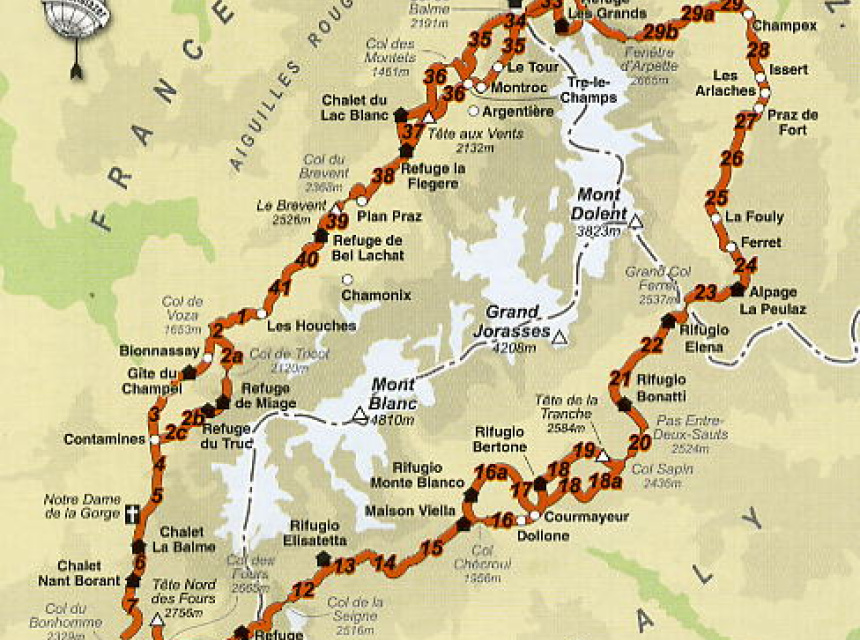
The Tour du Mont Blanc (TMB) is a 170 km trek that encompasses the whole of the Mont Blanc Massif; with nearly 10 000m of cumulative descent and ascent it is usually completed in a number of days.
The TMB has a variety of accommodation facilities along the route (hotels and mountain huts with possibility for vehicle support) that allow you to really enjoy the scenery, take lots of photos and walk each day with just a light pack.
Alternatively, the TMB can be done completely self-sufficiently: you carry all your own food and camping gear. This gives you a better sense of freedom and the ability to go where you please whenever you want.
Tour of Mont Blanc General Information
Mont Blanc Tour mountain huts are open, in general, from mid-June until the first or second week in September. It is advisable to reserve a bed, particularly in the high season of mid July to mid August.
Early in the season is the quietest and most beautiful, but beware of old snow on the higher paths which could be icy and dangerous and would make an ice axe essential.
For additional safety or to just show you the way you could hire an Independent Trek Leader .
Wildlife on the Tour du Mont Blanc
Have a look at the Chamonix.net nature, fauna and flora page for more information on wildlife you might encounter on the Tour of Mont Blanc. Chamois, deer, eagles and a range of beautiful alpine flowers can all be seen and photographed.
Tour du Mont Blanc Maps, Kit List and Equipment
Lightweight boots and shorts are sufficient as long as there are warm clothes in your backpack. Waterproofs are essential and trekking poles useful. Here are some of the best mountain equipment shops in Chamonix .
Do not forget sunglasses, skin and lip protection. Always carry drinking water and check the Chamonix weather forecast before starting your journey.
Maps for the Tour of Mont Blanc:
Tour of Mont Blanc - Route Descriptions
You have plenty of options: from 4 day sportive hikes to leisurely 12 day cultural experiences; there is not only one way to do the Tour of Mont Blanc. Here are a couple of different suggestions which may help you make up your mind on your particular style.
- You can go on your own with your own GPS track, or benefit from a mountain leader's experience
- You can carry your own gear or hike with a light pack with vehicle support
- You can sleep and eat in the refuges or carry a tent
Here is a list of contact information for the various mountain huts .
4 day trip: Not quite racing - but fast enough: For the hardcore hiker
This itinerary follows pretty much in the footsteps of the Ultra Trail race (which varies slightly from year to year). This is for very fit hikers and is done with only a light day pack, eating and sleeping in huts and is basically the run/walking version of the Tour du Mont Blanc. The times noted are for fit spandex-wearing (not obligatory!) hikers.
7 day trip: Hiking the Tour of Mont Blanc - hiker
Start with the previously mentioned itinerary and break up the days a bit depending on where you would like to spend the night.
For people who carry their own gear, plan on a 7 day trip.
9 to 11 day trip: Taking the time to look at the scenery
Of course if you really do have time, you can expand the experience. Here's an example of a slower pace, with time to veer a little off the path. This is described as an 11 day trip, but it would be really easy to knock off the first and last days as those days are dedicated to trekking in the Chamonix Valley.
Each year, in the last days of August, the trails around the Mont Blanc get really busy. This is because of one of the most amazing human competitions ever organized on this planet - The Ultra Trail du Mont Blanc - so keep this in mind when planning your hike of the Tour du Mont Blanc.
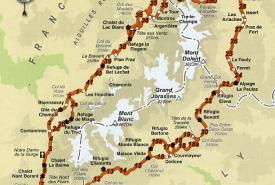
Social Networks

Latest News

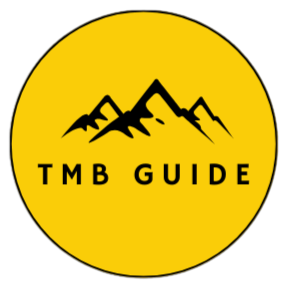
Tour du Mont Blanc in 7 Days: Map, Stages & Accommodations
The Tour du Mont Blanc is an epic hiking experience that takes you through three countries – France, Italy, and Switzerland – in an intense week. This adventure invites you to measure yourself against the majesty of the Alps, crossing mountain passes such as the Col du Brévent, the Col de la Seigne, and the Col des Fours, while admiring the grand landscapes of Mont Blanc.
The route offers exceptional flexibility, allowing hikers to adjust the difficulty of their journey by varying the number of days. A seven-day tour represents a considerable challenge, with some long and strenuous stages, but offers unmatched rewards in terms of satisfaction and breathtaking panoramas. For those who prefer a gentler adventure, a ten-day tour provides a more relaxed alternative.
Accommodation along the route is varied and abundant, with a wide choice ranging from comfortable hotels to quaint gîtes, traditional mountain refuges , and even bivouac sites for the more adventurous. Prepare for total immersion in the wild splendor of the Alps, facing the vastness of Mont Blanc.
Day 1 (Option 1): Les Houches – Refuge de la Balme
Download the GPX track of the stage: https://www.visugpx.com/mSlFmJ4Qro
Elevation gain, altitude, and mileage of the stage

Elevation +

Elevation –

Max. Altitude

Min. Altitude
Stage Summary:
The first stage of the Tour du Mont Blanc is a 25-kilometer adventure that starts at Les Houches and ends at the Refuge de la Balme. After about 2h30 of walking from Les Houches, you will reach the Col de Voza, an initial challenge that will get you into the swing of things with about 660 meters of positive elevation gain over a distance of 6 to 7 kilometers, depending on your starting point. This first part of the route offers an impressive introduction to the beauty of the Alps and a first leg-stretcher for the rest of the tour.
After the Col de Voza, you will descend about 11 kilometers, with a negative elevation change of around 800 meters, to arrive in Les Contamines. This charming town is an ideal place to take a break, refresh with a local beer, and even spend the night if you prefer not to continue to the Refuge de la Balme. For those who choose to continue, there are still about 7 kilometers and 550 meters of positive elevation gain to reach the Refuge de la Balme. There, you can choose to sleep in the comfort of the refuge or experience a more rustic stay at the bivouac area.
Points of Interest for the Stage
Col de Voza
Where to Sleep?
Refuge de la Balme Bivouac area of Refuge de la Balme Possible to stop earlier in Les Contamines (camping or hotel)
Day 1 (option 2): Les Houches – Refuge de la Balme via the Col de Tricot variant
Download the GPX track of the stage: https://www.visugpx.com/rFQWJMXPXN
Summary of the Stage
The first stage of the Tour du Mont Blanc offers an exciting variant that goes through the Col du Tricot, adding an extra dimension to this alpine adventure. The first part of the stage remains the same as the classic route, with a walk of about 2h30 from Les Houches to the Col de Voza. This section of the route includes about 660 meters of positive elevation gain over a distance of 6 to 7 kilometers, depending on your starting point.
Once at the Col de Voza, you will have the choice of staying on the classic route or taking the variant via the Col du Tricot. If you choose the latter, you should prepare for about 600 meters of additional positive elevation gain over a distance of 6 kilometers to reach the Col du Tricot. This variant offers a more demanding hiking experience, but also more rewarding, with spectacular panoramic views of the Alps.
From the Col du Tricot, you have several options for the rest of your day. You can continue to the Refuge de la Balme to spend the night, offering a longer but also more rewarding end to the day. Alternatively, you can turn towards Les Contamines to shorten your day and spend the night there.
Col de Voza Col de tricot at 2120m
Day 2 (option 1): Refuge de la Balme > Chapieux > Les Mottets
Download the GPX track for the stage: https://www.visugpx.com/pubLJ5t1su
The second stage of the Tour du Mont Blanc begins at the Refuge de la Balme and ends at the Refuge des Mottets. It follows the classic route of the tour.
The departure from the Refuge de la Balme leads to a climb of 650 meters of elevation gain over a distance of 4 kilometers to reach the Col du Bonhomme. Once at the pass, you will continue on the classic route of the tour, without taking the variant via the Col des Fours.
After the Col de la Croix du Bonhomme, you will begin a descent of 4 kilometers with a negative elevation change of 800 meters to arrive at Chapieux. From there, you will continue calmly for about 6 kilometers to the Refuge des Mottets. Along the way, you can stop at the Ville des Glaciers, where it’s possible to stop at the alpine pasture to stock up on local cheese, a true delicacy of the region.
Once arrived at the Refuge des Mottets, you will have completed this stage of the tour. This is your last stop before crossing into Italy the next day. It is recommended to book in advance if you plan to sleep in the refuge. It is important to note that it is forbidden to bivouac on the refuge property, which is quite large. However, you can pitch your tents before the refuge at the level of the ruins (about 5/10 minutes before the refuge) or after starting the ascent towards the Col de la Seigne, just behind the first “peak” that is visible from the refuge.
Col du bonhomme Col de la croix du bonhomme
Refuge des Mottets Bivouac before the Refuge des Mottets at the level of the ruins. Set up your tents quickly as it fills up very fast. Bivouac after the Refuge des Mottets (directly after the first ascent towards the Col de la Seigne)
Day 2 (option 2): Refuge de la Balme > Col des Fours > Les Mottets
Download the GPX track for the stage: https://www.visugpx.com/URWmZQHWLG
The beginning of the stage is the same as the classic route, starting from the Refuge de la Balme and ascending 650 meters of elevation gain over 4 kilometers to reach the Col du Bonhomme.
Continuing towards the Col de la Croix du Bonhomme, you will then choose the variant that leads to the Col des Fours. This variant takes you to an altitude of 2665 meters, offering spectacular views of the surrounding mountains. Before embarking on this variant, it is essential to check the weather and the trail conditions in advance. Depending on the season, there can be a lot of snowfields, making some passages dangerous even in summer.
Once at the Col des Fours, you will begin a descent of 5 kilometers with a negative elevation change of 900 meters to arrive at the Ville des Glaciers. You can stop at the alpine pasture to stock up on local cheese, a true delicacy of the region, before continuing to the Refuge des Mottets.
The Refuge des Mottets is your last stop before crossing into Italy the next day. It is recommended to book in advance if you plan to sleep in the refuge. It is important to note that it is forbidden to bivouac on the refuge property, which is quite large. However, you can pitch your tents before the refuge at the level of the ruins (about 5/10 minutes before the refuge) or after starting the ascent towards the Col de la Seigne, just behind the first “peak” that is visible from the refuge.
Day 3: Les Mottets > Courmayeur
Download the GPX track for the stage: https://www.visugpx.com/Twvax7D6iA
The third stage of the Tour du Mont Blanc will take you from France to Italy, crossing spectacular alpine landscapes. The stage begins at the Refuge des Mottets, and after only 4 kilometers and about 600 meters of positive elevation gain, you will reach the Col de la Seigne. This pass, perfect for waking up, marks your entry into Italy and offers breathtaking panoramic views of the surrounding mountains.
After the Col de la Seigne, you will continue for about 9 to 10 kilometers through the beautiful Italian valley. This part of the route takes you through varied landscapes, including the picturesque Lake Combal and several mountain refuges. Each step of this stage offers a new view of the Alps, with constantly changing panoramas and opportunities for memorable photos.
Finally, you will begin a descent of 11 kilometers with a negative elevation change of 1260 meters to arrive in Courmayeur. This Italian town is a welcome resting place after this long stage. Courmayeur is full of hotels, perfect for recharging and preparing for the next stage of your adventure. Whether you choose to relax in a spa, taste local Italian cuisine, or simply rest, Courmayeur offers a perfect end to the day for this third stage of the Tour du Mont Blanc.
Col de la Seigne Lake Combal
Hotels in Courmayeur
Campings outside Courmayeur
Day 4: Courmayeur > Refuge Elena
Download the GPX track for the stage: https://www.visugpx.com/B3MhnslfBa
The fourth stage of the Tour du Mont Blanc is a day that offers a mix of challenges and relaxation. Your day begins with a climb of about 800 meters of positive elevation gain over a distance of 4 to 5 kilometers, depending on your starting point. This initial climb is an excellent way to wake up and prepare for the day ahead.
Once this climb is completed, the rest of the day is relatively “quiet” compared to other stages. You will continue for about 12 kilometers, with 330 meters of positive elevation and 600 meters of negative elevation. This part of the route takes you through the beautiful Italian valley, offering spectacular views and a relaxing hiking experience.
Before arriving at the Refuge Elena, you will have about 2 kilometers and about 300 meters of positive elevation gain left. This last climb is a final challenge before ending the day. The Refuge Elena is a popular place to spend the night, offering spectacular views of the surrounding mountains.
It is important to note that you will need to book in advance to sleep at the Refuge Elena, as it fills up quickly and there are not many sleeping options in the vicinity. In Italy, bivouacking is prohibited below 2500 meters in altitude, so it is essential to plan ahead. This fourth stage of the Tour du Mont Blanc offers a balanced hiking experience, with physical challenges, beautiful landscapes, and moments of relaxation.
Italian Valley
Where to sleep?
Refuge Elena
Day 5: Refuge Elena > Champex
Download the GPX track for the stage: https://www.visugpx.com/v4RKRYwRg3
The fifth stage of the Tour du Mont Blanc, from the Refuge Elena to Champex-Lac, is a hiking day that offers both challenges and moments of relaxation. Although this stage is quite long and some parts may not be the most attractive of the tour, it nevertheless provides a rewarding hiking experience.
The day begins with a beautiful climb of about 500 meters of positive elevation over 2 kilometers to reach the Grand Col Ferret. This ascent marks your crossing into Switzerland, a moment to celebrate, but also to consider for your phone’s internet data, as Switzerland may not be included in your European plan depending on the operator.
From the Grand Col Ferret, a descent of about 20 kilometers and 1600 meters of negative elevation awaits you. This descent brings you closer to Champex-Lac, your destination for the night. It’s worth noting that part of this stage can be done by bus by taking the shuttle at Ferret or La Fouly, which can be an attractive option for those wishing to save some energy.
You then have 6 kilometers and 600 meters of positive elevation remaining to reach the Relais de l’Arpette, where you will spend the night. It is also possible to sleep at the Camping des Rocailles in Champex, which is located about 45 minutes before the Relais de l’Arpette.
Grand Col Ferret (Italy/Switzerland border) Option to take the shuttle at Ferret to Champex and avoid walking for 4 hours Supermarket in La Fouly to restock if needed
Relais de l’Arpette Camping des rocailles (in Champex)
Day 6 (option 1): Champex > Col de Balme (via La Forclaz) > Tré le Champs.
Download the GPX track for the stage: https://www.visugpx.com/f8P8nDc8xt
The sixth stage of the Tour du Mont Blanc, from Champex to Tré le Champ, is a quite hard hiking day even without taking the variant via the Fenêtre d’Arpette. This stage also marks your return to France.
Your day begins with a climb towards the Col de la Forclaz, followed by another ascent to the Col de la Balme. The Col de la Balme is a highlight of this stage, offering spectacular views of the surrounding mountains. The refuge here is a beautiful place to take a break and enjoy the scenery. The passage at the Col de la Balme also marks the border with France, another significant milestone of your journey.
After enjoying the Col de la Balme and a drink at the refuge, you will begin a descent of about 6 kilometers with 700 meters of negative elevation to reach Tré le Champ and the Auberge de la Boerne. This descent offers another opportunity to enjoy the alpine landscapes while approaching your destination for the night.
It’s important to note that you need to book your night at the Auberge de la Boerne in advance, as it fills up quickly. The bivouac area is not the largest, so it’s advised to set up your tents quickly. Once settled, you can enjoy a wonderful meal at the inn and take advantage of the showers if you wish.
Col de la Forclaz Col de la Balme
Auberge de la Boerne (hostel) Auberge de la Boerne (camping)
Day 6 (option 2): Champex > Col de Balme (via Fenêtre d’Arpette) > Tré le Champs
Download the GPX track for the stage: https://www.visugpx.com/iIoAINv20C
The sixth stage of the Tour du Mont Blanc, from Champex to Tré le Champ with the variant via the Fenêtre d’Arpette, is considered one of the hardest of the Tour, but also one of the most beautiful and rewarding.
Starting from Champex, you’ll begin a climb over 6 kilometers with an elevation gain of 1100 meters. This ascent is a challenge in itself, with some complicated passages to reach the Fenêtre d’Arpette, and the trail can be difficult to follow. It’s essential to be cautious on the way, check the weather and trail conditions beforehand carefully. Some passages may still be snow-covered and dangerous if the weather is not favorable.
Once you reach the Fenêtre, take the time to rest and savor your accomplishment. You then have a descent of about 4 kilometers with 1000 meters of negative elevation before arriving at the Chalet des Glaciers. Here, you can reward yourself with a cheese crust and a good beer.
After a well-deserved break, you’ll embark on another ascent to the Col de la Balme, about 2 kilometers with approximately 600 meters of elevation gain. The view and refuge here are magnificent, and it’s recommended to make the most of it.
Finally, you have “only” 6 kilometers and 800 meters of negative elevation to reach Tré le Champ. As always, make sure to book your night in advance, whether in a refuge or bivouac, as these places fill up quickly. The bivouac area is not the largest, so it’s advised to set up your tents quickly. Once settled, you can enjoy a wonderful meal at the inn and take advantage of the showers if you wish. This stage of the Tour du Mont Blanc offers an unforgettable hiking experience, with physical challenges, breathtaking views, and well-deserved moments of relaxation.
Fenêtre d’Arpette Col de la Balme
Day 7: Tré le Champs > Les Houches
Download the GPX track for the stage: https://www.visugpx.com/3kIaPa8PzP
Congratulations! You’ve reached the seventh and final stage of the Tour du Mont Blanc, from Tré le Champ to Les Houches. It’s a flexible day, adaptable to your needs and desires, whether in terms of accommodation, transport, or difficulty level.
If you choose to descend to Les Houches, prepare for a full day. However, many “exits” are available along the way, allowing you to adjust your day according to your physical condition and desires.
You have the option to take the cable car from La Flégère to Chamonix, offering a quick descent and a stunning view of the valley. Another option is to take the cable car from Brévent to Chamonix, another way to enjoy the view without the effort of descending.
If you feel up to it, you can also choose to walk down to Chamonix before the ascent of Brévent. This option allows you to fully enjoy the natural beauty of the route, while offering one last physical challenge.
During this day, you will pass through the Aiguillette d’Argentière and its ladders, as well as the Col du Brévent. Both points offer spectacular views and are highlights of this final stage.
Whichever option you choose, this last stage of the Tour du Mont Blanc is an opportunity to celebrate your achievements, enjoy the last beautiful views, and finish your adventure in style.
Aiguillette d’Argentière Col du Brévent
Les Houches Chamonix Option to take the cable car from La Flégère to Chamonix Option to take the cable car from Brévent to Chamonix Option to walk down to Chamonix before the ascent of Brévent (expect 1h30 to 2h of steep descent)
Submit a Comment
Your email address will not be published. Required fields are marked *
Please enter an answer in digits: 12 − eight =
Submit Comment
- Follow Follow
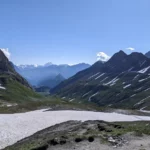
This article was written by Hugo, a hiking enthusiast and co-creator of TMB-Guide.com. This site is your gateway to your adventure on the Tour du Mont Blanc. We strive to share as much information as possible about the Tour to help hikers prepare for their trips.
- Trail Guides
- App Features
- General FAQs
- Subscription FAQs
- How-To Guides

170km / 105 miles • The Alps of France, Italy & Switzerland
Official companion app to trailblazer’s tour du mont blanc by jim manthorpe.
Download our guide to access the Tour du Mont Blanc map, tracks, waypoints, and comments! Trek the European Alps through the epic peaks and stunning valleys of the Tour du Mont Blanc. The Tour du Mont Blanc is one of the world’s most famous hiking trails. This loop route passes through seven stunning mountain valleys around the spectacular Mont Blanc. This amazing scenery is classic European Alps: rugged spiky mountains, lush green valleys, strenuous mountain passes, and photo-worthy vistas. Hikers can start the loop from a variety of points in France, Italy, and Switzerland, including in Les Houches in the Chamonix Valley, Les Contamines in the Montjoie Valley, Courmayeur, Champex, and Martigny. The route also passes Chamonix, the famous resort which hosted the first Winter Olympic Games in 1924.
$14.99/£14.99 A TRAILBLAZER GUIDE
Buy Once, Works Everywhere
Works Offline
Trusted Trail Data
Detailed Waypoints
Built for Community
Tailored to You
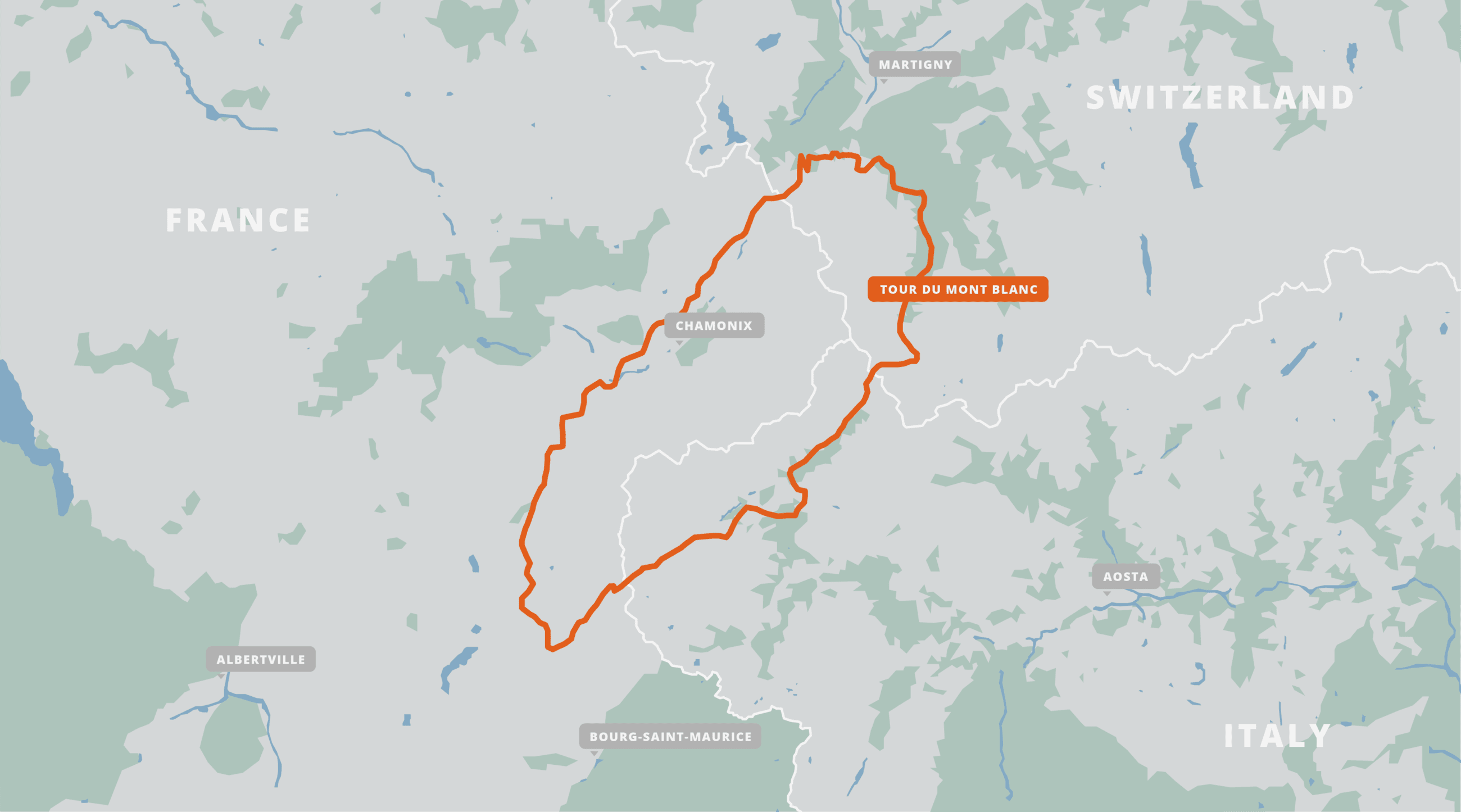
Available on
- Desktop browser
- Android tablet

Trailblazer Special
Purchase all Trailblazer apps in one package. Includes South Downs Way, Coast to Coast, West Highland Way, Hadrian’s Wall Path, The Cotswold Way, and The Ridgeway. Purchase now and you will receive any new apps we add in the future at no additional cost.
$34.99/£34.99
Tour du Mont Blanc
The Tour du Mont Blanc is one of the world’s most famous hiking trails. This loop route passes through seven stunning mountain valleys around the spectacular Mont Blanc. This amazing scenery is classic European Alps: rugged spiky mountains, lush green valleys, strenuous mountain passes, and photo-worthy vistas. Hikers can start the loop from a variety of points in France, Italy, and Switzerland, including in Les Houches in the Chamonix Valley, Les Contamines in the Montjoie Valley, Courmayeur, Champex, and Martigny. The route also passes Chamonix, the famous resort which hosted the first Winter Olympic Games in 1924.
$14.99/£14.99
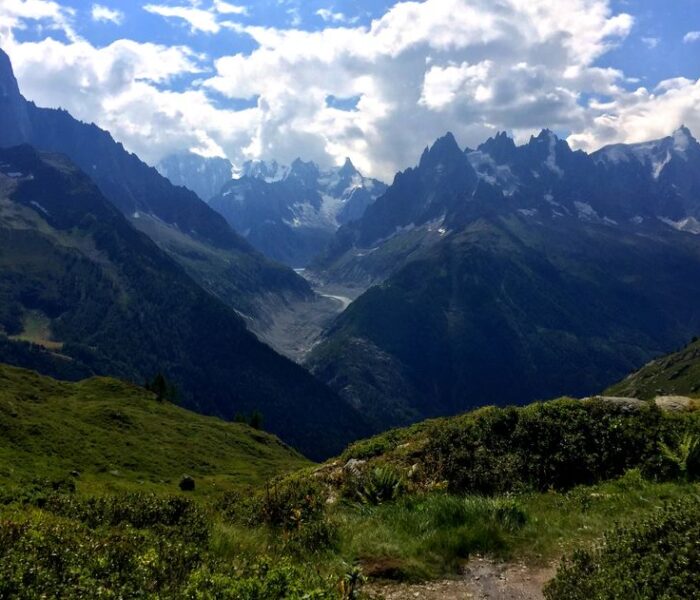
About Our Partner
Trailblazer was started in 1991 by traveller and author, Bryn Thomas. In his travels since the 1980s he has used a lot of guidebooks and firmly believes that it is the detail that makes guides most useful. Walkers need to know the nut and bolt detail of a walk – timings, distances, gradients and prices – rather than have to read long descriptions of views they can see for themselves. So Trailblazer guides focus in on really detailed information for only a single long-distance walk or a select few trails rather than general information on a large network of trails. And our authors have a voice – they tell it like it is. These are guides are written by walkers for walkers. Trailblazer is proud to have been associated with FarOut since 2014 and we work closely together.

- Best Hikes In The World
- Appalachian Trail
- European Hikes
- Nepal Hikes
- Patagonia Hikes
- See All Hikes
- Mount Kenya
- Mount Kilimanjaro
- Mount Toubkal
- See All Mountains
- South Africa
- New Zealand
- Switzerland
- United Kingdom
- Packing Lists
Tour du Mont Blanc (Expert Guide)
Europe , France , Hikes , Italy , Mountains , Switzerland
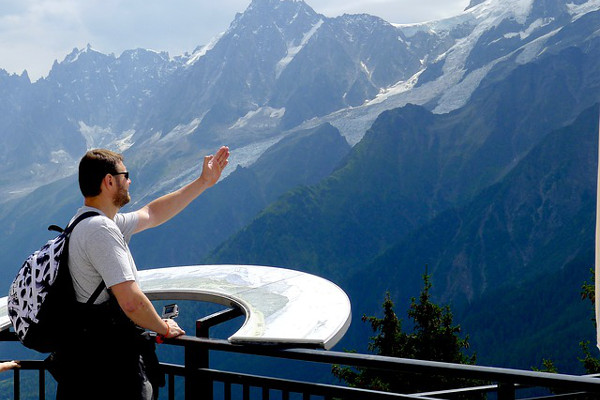
The Tour du Mont Blanc is one of the most popular treks in Europe. It covers a distance of roughly 170 kilometres and gains more than 10,000 meters of altitude over 11 stages.
In this guide we cover: what weather to expect and the best time to hike the Tour du Mont Blanc, which huts to book, what gear you might need, and much more...
Join a Tour du Mont Blanc Highlights Hike
Book with our recommended local guide
Tour du Mont Blanc
Route overview.
The Tour du Mont Blanc covers a distance of roughly 170 kilometres and gains more than 10,000 meters of altitude over 11 stages. Most people start their hike in Les Houches, France going in an anti-clockwise direction.
During this trek you will hike in the French, Italian and Swiss Alps and spend the night in mountain huts. This is one of Europe's best hikes and is a classic alpine trek. On the hike you will get splendid views of some of the highest mountains in Western Europe, as well as glaciers and alpine meadows.
The highest point reached is 2,665 meters.
The hike passes seven valleys along the way, which means there is a lot of altitude to be gained, making the Tour du Mont Blanc a physical challenge.
Fortunately, walkers are rewarded with some of the best views you can get of Mont Blanc . The route is not only one of the most beautiful long-distance treks in Europe (up there with the Walker's Haute Route ), but one of the most popular ones as well.
Nights can be spent in either mountain huts along the route or back in the valley, where you can have the luxury of a warm bed in a hotel.
What we like and dislike about the hike
- Incredible views of the Mont Blanc massif
- Hike in three countries
- Visit the beautiful villages of Chamonix and Courmayeur along the way
- Spend the night in some of Europe's most iconic mountain huts
- More expensive than other treks in Europe due to the cost of mountain huts
- Physically challenging
- Can be crowded during the summer months
Join the full Tour du Mont Blanc Hike (10-Days)
Tour du mont blanc circuit.
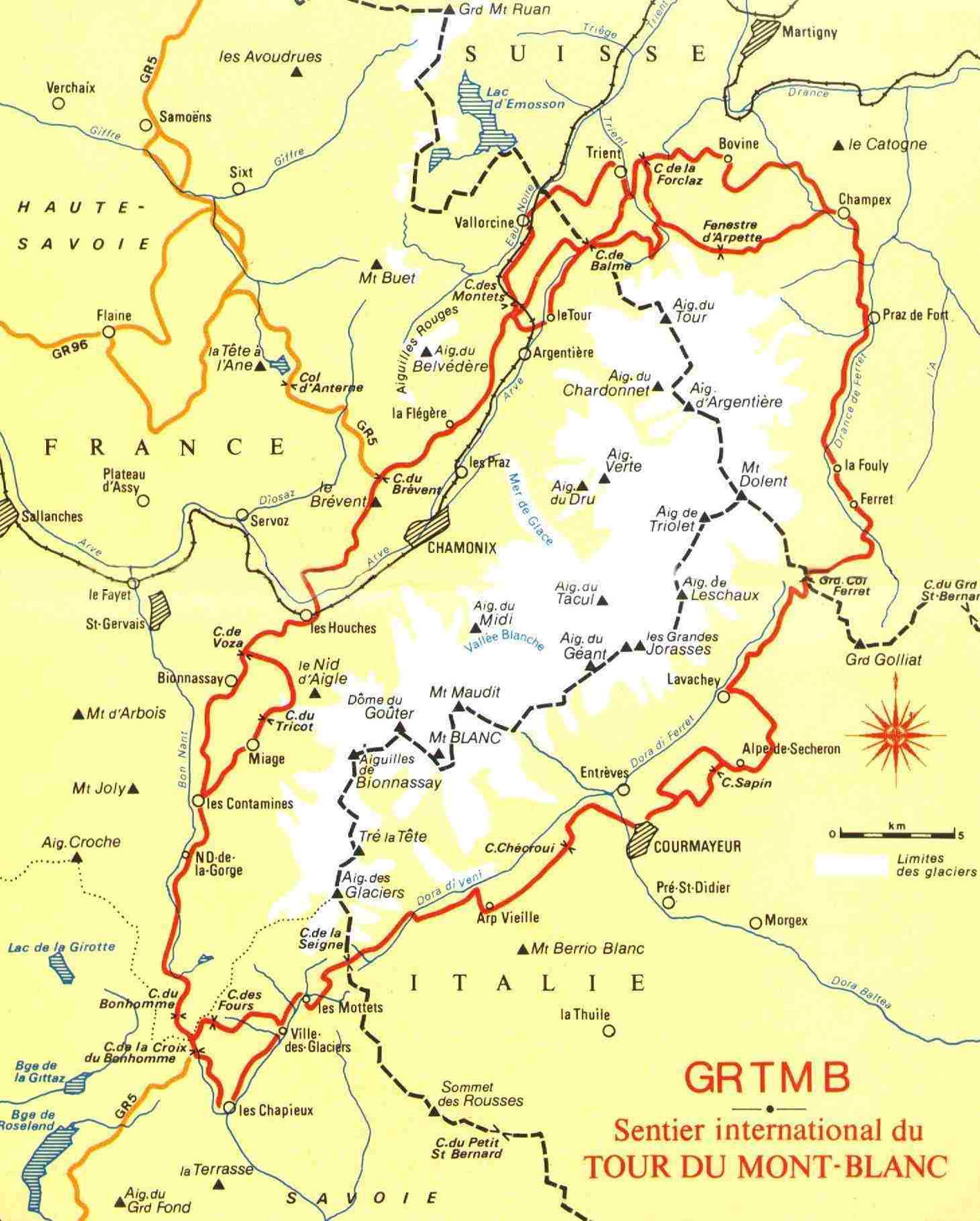
Source: chamonix.net
This map illustrates the Tour du Mont Blanc route. It starts off at Les Houches, France close to the Swiss and Italian border before heading west towards the Italian side of Mont Blanc.
There are 11 stages depending on your physical level. The route is circular around the Mont Blanc Massif, crossing the borders of France, Switzerland and Italy.
In terms of a trekking map we recommend:
- Chamonix, Mont-Blanc ~ IGN Top25 3630OT 2012 (English and French Edition)
And in terms of a trekking guide we highly recommend:
- Cicerone's The Tour du Mont Blanc: Complete two-way trekking guide
Altitude Profile
In the chart below you see the altitude profile of the full hike. It is quite clear there is a lot of altitude to be gained over the 11 stages, with the highest point reached just above 2500 meters. You can see that there are a few strenuous stages reaching high mountain passes that will require great effort.

Mont Blanc Route Itinerary
Below we have laid out the most popular version of the Tour du Mont Blanc Route – 11 days, starting and finishing in Les Houches. The itinerary includes approx. distances, hiking times and elevation changes.
Day 1: Les Houches – Les Contamines
Distance: 16 km Ascent: 646m Descent: 633m Hiking time: 5hrs
Easy first stage along, this is the most roadway you will see during the trek. The best views are to be seen at Col de Voza, where you get a look at Dome du Gouter and Aiguille de Bionnasay, with the glacier splitting it in half.
Day 2: Les Contamines – Les Chapieux
Distance: 18 km Change in elevation: 1316m+, 929m- Hiking time: 7.5hrs
A bit tougher than the first stage. Especially, since there is quite some altitude to be gained and distance covered.
Day 3: Les Chapieux – Rifugio Elisabetta
Distance: 15 km Change in elevation: 1004m+, 258m- Hiking time: 4.5hrs
This is the day you will leave France and enter Italy via Col de la Seigne. Despite being a short day, there still is some elevation to be gained as you will pass Col de la Seigne. At the highest point, you will gain some great views of both France and Italy and gaze into Val Veni. This is the first night you will spend in a mountain hut.
Day 4: Rifugio Elisabetta – Courmayeur
Distance: 18 km Change in elevation: 460m+, 1560m- Hiking time: 5hrs
Another short day, since you will mainly be descending. Still, some great views will be shared before reaching Courmayeur, the Italian equivalent of Chamonix.
Day 5: Courmayeur– Rifugio Bonatti
Distance: 12 km Change in elevation: 860m+, 101m- Hiking time: 4.5hrs
Often described as the most scenic stage of the Tour du Mont Blanc. With views on the glaciers of Planpincieux and Frebouze it’s not hard to see why. The high route along the Mont de la Saxe Crest is thought of as one of the best viewpoints of the southside of the Mont Blanc.
Day 6: Rifugio Bonatti – La Fouly
Distance: 20 km Change in elevation: 895+, 1410m- Hiking time: 6.5hrs
Today will cross another border and enter Switzerland. Cowbells and tiny villages that have been stuck in time are your scenery for the next few days.
Day 7: La Fouly - Champex
Distance: 15 km Change in elevation: 420m+, 565m- Hiking time: 4hrs
This probably is the easiest stage of the Tour du Mont Blanc since there are no cols to be conquered. This stage mainly is a valley trek with some great charming villages along the way. However impressive views of the mountains remain.
Day 8: Champex – Col de la Forclaz
Distance: 16 km Change in elevation: 742m+, 682m- Hiking time: 4.5hrs
There are two ways to reach Col de la Forclaz. A lower route via Alp Bovine, or the more scenic and higher route along the Trient Glacier. This latter passes the Fenetre d’Arpette, the highest point on the Tour du Mont Blanc, and should only be considered in good weather.
Day 9: Col de la Forclaz – Tre le Champ
Distance: 13 km Change in elevation: 1069m+, 1168m- Hiking time: 5.5hrs
From this point you re-enter France via Col de Balme. A lot of elevation is to be gained and lost, which makes the stage a strenuous one.
Day 10: Tre le Champ – Refuge Flegere
Distance: 8 km Change in elevation: 733m+, 257m- Hiking time: 3.5hrs
Short stage, but with some ascent. You will spend another night in a mountain hut. Refuge Flegere offers great views and is a perfect last night in the mountains before arriving in Les Houches the next day. There are some ladders to be climbed before reaching the refuge however.
Day 11: Refuge Flegere – Les Houches
Distance: 17 km Change in elevation: 772m+, 1546m- Hiking time: 6.5hrs
This last stage of the Tour du Mont Blanc goes along Le Brevent in the Aiguille Rouge. There are some splendid views of the Chamonix Valley before finally descending and arriving back in Les Houches.
Video Overview
A beautiful video overview, filmed with a GoPro, of the Tour du Mont Blanc by Eugenio psnt .
Join a Tour du Mont Blanc Hike
Frequently asked questions, how much does the tour du mont blanc trek cost.
The cost of the Tour du Mont Blanc trek is dependent on whether you plan to do a self-guided hike or join a planned tour. Self guided hikes cost in the region of $1500 (estimate of $50-$75 dollars a day). Most mountain huts / gites are around $50 (incl. breakfast).
Guided trekking tours can be quite expensive since not only do you pay for the guiding service, but you eat and spend most nights in hotels or mountain huts. This mostly includes a luggage transfer to your next accommodation as well, so you can hike with a small backpack. Guided tours range from $2000-$3500, depending on the company / season / size of the group.
Self guided is the cheaper option, however, it does mean you carry more weight in your backpack and some planning of logistics in the weeks / months before.
Are permits required for the Tour du Mont Blanc trek?
No permits are required for the Tour du Mont Blanc trek.
When is the best time to trek the Tour du Mont Blanc Route?
The best time to trek the Tour du Mont Blanc is between July-September, but exact start and end dates depend on the amount and timing of the previous winter’s snowfall and the onset of cold weather in the Autumn.
Since the Tour du Mont Blanc crosses high passes, snow could create problems / dangerous conditions. Therefore in a normal year it is not advisable to set out before July. In the summer months, mid-July through to end of August, are the busiest, and temperatures during the day can rise to 25 degrees. Nonetheless, thunderstorms or a dump of snow is possible as well.
By the end of September, huts will close and it might get a lot harder to complete the trek.
Is altitude sickness a risk?
No, you will cross passes slightly higher than 2500 meter and since you’re hiking slowly to this altitude, you have more than sufficient time to acclimatize. Most people don’t feel any symptoms of altitude sickness before reaching 3000-3500 meter.
How difficult is the Tour du Mont Blanc trek?
Hiking the Tour du Mont Blanc comes with great rewards. Rewards that will be more easily gathered when physically fit and mentally attuned. There are many steep and uphill sections to conquer, so exercising regularly at home before the trek is necessary to get in shape for the physical demands of this route. Mental fitness is as important and often go hand in hand.
The Tour du Mont Blanc is doable for any fit mountain walkers who are able to hike between 5h and 7h30 min per day for several days in a row.
If you are finding the trek tough there are a few sections where you can use public transport to shorten your hike.
What gear do I need?
To do a serious trek like the Tour du Mont Blanc, appropriate clothing and equipment is a must.
Some comfortable lightweight trekking boots are a must to enjoy this trek, while good waterproofs might be essential, not only to protect you against rain or snowfall but to double as wind-proofs. Since you’ll be crossing passes of more than 2500 meters, gloves and several layers will prove useful. Trekking poles are a good way to not overload your knees and ankles
To help you plan and prepare for your trek we recommend our Tour du Mont Blanc packing list .
What travel insurance do I need?
Trekking insurance is important when going into the mountains. See our article on insurance for more information.
Do I have to carry my own gear all the way?
It’s up to you. There are many organisations offering guided trips for this hike, meaning they do all the logistics for you. This often includes a luggage transfer to your next accommodation in the valley, so you only need to carry a small backpack with some lunch, snacks and clothes.
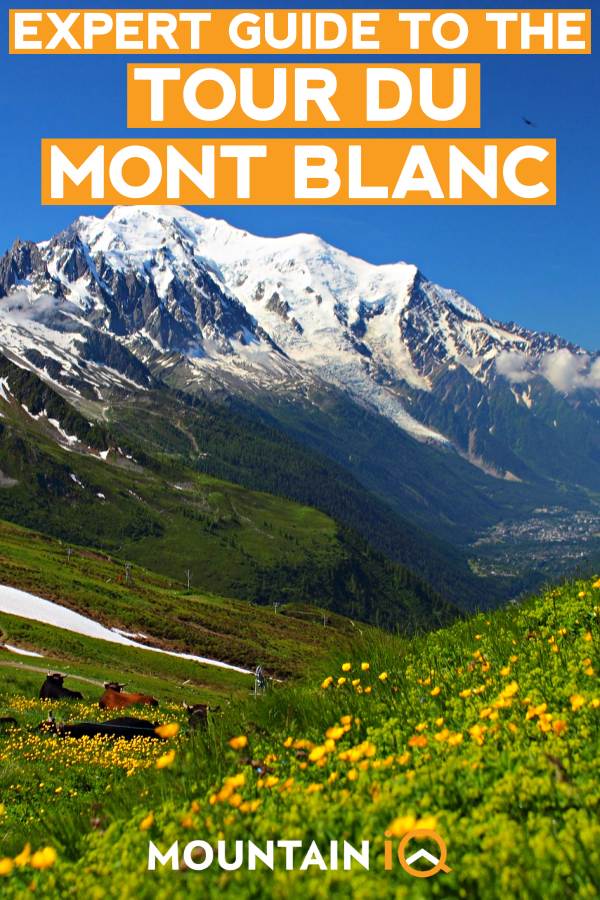
Browse more hikes in Europe
See our top European hikes picks, or check out these popular hikes.
- Tour de Monte Rosa
- Walkers Haute Route
- Camino de Santiago Routes
- Cinque Terre Hiking
- West Highland Way Hike
- El Caminito del Rey
- Laugavegur Trail
- Kungsleden Trail
- Rota Vicentina
- Slovenian Mountain Trail
About the author
Mark Whitman
Mark has trekked extensively in Asia, Europe, South America and Africa. He founded Mountain IQ in 2014 with the sole aim to be the best online information portal to some of the most popular mountain destinations around the world. When not writing for Mountain IQ, Mark is out exploring the outdoors with his wife!
Leave a Reply
Your email address will not be published. Required fields are marked
Hi Dempsey,
I’ve been thinking about doing that hiking for a long time and I think, after this pandemic crisis, it’s the time to see my dream coming true. I hope to do it as soon as possible, and to see it how beautiful the nature around is. Stay safe,
João Leite.
Wife and I are interested in doing this in last half of August. I know it is (too) late to reserve now. We plan to show up and hope for the best, perhaps taking advantage of late cancellations on a guided/luggage transfer arrangement. Any advice?
Hi Mike, there are a few dates available on this TMB highlights tour, which is amazing if you’re looking for a short circuit: https://www.skyhookadventure.com/trips/tour-du-mont-blanc-highlights
We work with local guides to offer great value adventures at unbeatable prices

The Ultimate Guide to the Tour du Mont Blanc
The Tour du Mont Blanc is one of the world’s most iconic treks. Frequently referred to as the ‘TMB’ for short, the Tour du Mont Blanc circumnavigates the Mont Blanc massif and takes trekkers through France, Italy, and Switzerland over the course of 11 stages. Along the way you’ll experience stunning valleys, high-mountain passes, incredible cuisine, and some of the best hiking in the world.
This guide is designed to be the perfect planning companion for your own Tour du Mont Blanc adventure. We’ve included everything you need to know to have a spectacular trip in one place, so you can be sure you’ve thought of everything. Read it through in a single go or jump to a specific section below, but rest assured knowing you’ve found the best resource on the internet for planning your Tour du Mont Blanc trek. Let’s get started!

In this Tour du Mont Blanc Guide
- How long is the Tour du Mont Blanc?
- How difficult is the Tour du Mont Blanc?
- Which direction should I hike?
- When should I hike the TMB?
- Designing your TMB Itinerary
- Shortcuts, detours, and rest days on the TMB
- Stage-by-stage Itinerary for the Tour du Mont Blanc
Tour du Mont Blanc Accommodation
- Getting to Les Houches from Geneva
- Getting to Champex from Geneva
- Luggage storage and transfer on the TMB
- Weather on the TMB
- Food and drink on the TMB
- Maps & Guidebooks
- Budgeting and money
- What to pack for the TMB
- How to train for the Tour du Mont Blanc
Everything you need to plan your TMB – all in one place.
Whether you prefer mountain huts or hotels, fastpacking or meandering, or something in between, we’ve got you covered. Our Guide to the Tour du Mont Blanc is the ultimate tool to help you plan your perfect trip.
When you purchase a guide, you’ll get instant access to all the information you need to plan your trip in our planning portal as well as in a downloadable PDF eGuide.
- Planning Portal Access: Get instant access to our online trip planning portal complete with 9-day, 11-day, and 12-day TMB itineraries.
- Accommodation Insights: You’ll get information on accommodation options for every stage, including where to book when popular huts are fully booked!
- GPS Maps: Every guide comes with custom GPS maps for three different itineraries. Download the maps for offline use so you’ll always be able to find your next campsite.
- Expert Advice: Find detailed maps for every stage, accommodation & booking information, packing lists, and much more.

We’re confident this is the best resource available for camping on the Tour du Mont Blanc. Pick up your guide below and if you’re not satisfied for any reason we’ll give you a full refund!
( 100% Money Back Guarantee )
About the Tour du Mont Blanc
The Tour du Mont Blanc (TMB) is a 170-km trek that circles the Mont Blanc massif. The route is traditionally walked in the anti-clockwise direction over 11-stages. The TMB starts and finishes in the French village of Les Houches , which sits adjacent to the popular mountain town of Chamonix . Along the way the trail passes through seven unique and beautiful valleys, where charming hamlets and regional delicacies abound. Between the valleys, the route traverses a rugged mountain landscape and stunning high alpine scenery.

The TMB is one of the most popular long-distance treks in Europe, with over 10,000 hikers per year embarking on their own walk around Mont Blanc. It is easy to understand why when considering the ease of access to the trek , plentiful accommodation options , and the fact that the route is achievable by most reasonably fit walkers . The closest major city to the TMB is Geneva, Switzerland, located just a few hours north by train or bus .
The route passes through seven mountain valleys (Val d’Arve, Val d’Montjoie, Vallee des Glaciers, Val Veny, Italian Val Ferret, Swiss Val Ferret, and Vallee du Trient) and visits charming alpine hamlets as it winds its way around Mont Blanc. Contrary to what many believe, the TMB does not go through the iconic French mountain town of Chamonix, instead taking a trail high-above this famed destination.

Want to see the entire TMB in three minutes? The fly through video below will take you along the entire circuit, providing a helpful overview of the trek.
How Long is the Tour du Mont Blanc?
The short answer: it depends! The Tour du Mont Blanc has many variations and route options as it makes its way around Mont Blanc. These variations include options to tackle challenging mountain passes (see the Fenetre d’Arpette ), visit crystal clear mountain lakes (such as Lac Blanc ), or to simply avoid some of the more challenging sections of the hike. However, the classic TMB route is approximately 170-kilometers long. Taking alternate routes may lengthen or shorten your total distance, depending on the routes chosen. Throughout the trek, you’ll have options to walk less or more depending on the weather, your preferences, and the conditions encountered on the trail.

How Difficult is the Tour du Mont Blanc?
If you are reasonably fit and have some trekking experience , you should be well-suited to the physical challenges of the TMB. It is a tough trek that involves long, steep ascents and descents on nearly every stage , but it isn’t too technically demanding. Remember, the Tour du Mont Blanc is a hike not a climb! Trekkers should be prepared for long days of hiking with plenty of elevation change, but frequent services along the route make it more approachable. Weather can add to the challenge , and hikers should be prepared to encounter rain and even snow at any time.
Many of the stages of the TMB are structured such that you’ll begin your hike from the valley floor, trek up and over a mountain pass, and then descend into the next valley to finish the day. This provides a nice rhythm to the Tour du Mont Blanc but can also make for some difficult days. Make sure you have healthy knees, as the downhill sections can take their toll! All that being said we truly believe that most walkers who invest a bit of time in training and preparation can complete the Tour du Mont Blanc with no problems and have a great time doing it! Our best advice is to be sure you are in good physical condition and also make sound decisions when you encounter bad weather or snow.
Get The FREE TMB Essentials Handbook

Our free PDF guide covers all the basics – when to hike, accommodation, typical costs, and more!
Your TMB Essentials Booklet will be emailed to you shortly.

Planning Your Perfect Tour du Mont Blanc
Now that you have a bit of background on the TMB let’s get to the heart of this guide: helping you plan your perfect Tour du Mont Blanc! First, we’ll start with some basics such as which direction you should hike in and what time of year will be best for you to tackle the TMB. Then we’ll dive into some more in-depth considerations such as designing your perfect itinerary and selecting your accommodation . Let’s get started!

Which Direction Should I Hike the TMB?

The TMB is traditionally hiked in an anti-clockwise direction beginning in the French town of Les Houches, adjacent to Chamonix. It is also possible to walk the route in a clockwise direction, and trekkers headed this way typically start in the Swiss town of Champex-Lac . Below we’ve outlined some pros and cons of hiking in each direction.
Anti-Clockwise (starting in Les Houches, France)
- Follows the classic route, good if you’re a sucker for tradition.
- Begins near Chamonix, which is easier to get to from the Geneva Airport than Champex.
- Rewards hikers with jaw-dropping views of Mont Blanc on the final stage.
- More people hike in this direction, so the trail could feel more crowded throughout the day.
Clockwise (starting in Champex, Switzerland)
- Fewer hikers walking in the same direction as you.
- The first few stages are a bit mellower, allowing you to get acclimated before tackling the tougher sections.
- You’ll meet different people at each stop along the way.
- You’ll pass a large wave of people walking in the opposite direction each day, which can get tight on narrow trails.
- Champex (your starting point) has fewer amenities and is less conveniently connected by public transport than Les Houches. If you want to start in Les Houches and hike clockwise, be warned that the first day involves a very challenging climb, which can be a tough way to begin your trek.
All things considered, you will be sure to have a great time on the TMB regardless of which direction you choose to hike in. Think through your options and make the best decision for yourself!

When Should I Hike the Tour du Mont Blanc?
The hiking season for the TMB generally lasts from late June through mid-September. July and August are the busiest months, and accommodation (with the exception of camping) must be booked in advance. There’s a chance you could get away without advance bookings in June and September, but we still wouldn’t recommend it.

June : Early in the season, you are likely to encounter snow on the trail. Depending on the snow levels, there could be sections that will be impassible and you may need to reroute. Otherwise, expect cool evenings, bright sunny days, and less crowded trails. Keep in mind that most mountain refuges don’t open until late June.
July : Hikers could still encounter some snow along the trail, but chances of significant snow will diminish as the month wears on. Expect beautiful warm days and abundant wildflowers. This is a popular month to hike.
August : Another busy month on the trail, hikers can expect snow-free paths and warm, sunny weather. The end of August brings the Ultra Tour du Mont Blanc trail race . Although the atmosphere during the race week is incredible, we recommend you try to avoid hiking during the UTMB to avoid crowds and logistical challenges.
September : Expect shorter days and increasingly chilly weather. This is a beautiful time to be on the trail and less crowded, although some accommodation providers may be closed for the season.
The bottom line : The best (and safest) time to hike the TMB is from late-June through early September. You’ll need to make advance bookings if you plan to hike during this time frame.

Designing Your TMB Itinerary

Now that you have a sense of which direction you’ll plan to hike in as well as which month you’ll embark of your trip it’s time to start thinking about your specific itinerary! As we’ve mentioned, the Tour du Mont Blanc in traditionally hiked over the course of 11 days, which will be a great pace for many hikers. However, there are certainly those who will want to tackle the trail in fewer days or savor their time in the Alps and extend their hike over the course of two weeks or more!
Whatever you choose be sure to consider your personal abilities, how much time you’ll have, and what you want your typical days on the TMB to look like. Given the amount of accommodation options on the TMB your itinerary possibilities are nearly endless! Checkout our general guidelines below as well as our stage-by-stage itinerary for the traditional 11-day Tour du Mont Blanc circuit to get some ideas of your own. Here are our general guidelines for thinking about how many days you’ll need to complete the TMB:
- 8-10 days : Fast pace (8 – 10 hours of hiking each day)
- 10-11 days : Average pace (without a rest day) (6-8 hours of hiking each day)
- 11-12 days : Average pace (with a rest day) (6 – 8 hours of hiking each day)
- 12-14 days : Leisurely pace (6 – 7 hours of hiking each day)
Shortcuts, Detours, and Rest Days on the TMB
One of the great things about trekking the Tour du Mont Blanc is the ability to alter your route based on the conditions encountered. Bad weather, injuries, fatigue, burnout, limited time; there are countless reasons why you may need to use alternative means of transportation to get from one point of the TMB to another. Fortunately, the trail rarely strays too far from civilization, meaning you have tons of options along the way for when you need them. Below, we’ve listed some of the most common detours and shortcuts used on the TMB, as well as a few great resources for problem-solving your unique situation.
Bellvue Cable Car: This option allows you to eliminate the lion’s share of the climb out of Les Houches on the traditional (anti-clockwise) first stage of the trek . Once you get to the top, follow the signs a short way to rejoin the main trail.
La Maison Vielle Cable Car (and chairlift): If you’d like to avoid the knee-wrenching descent into Courmayeur ( Stage 4 ), you can take a chairlift from La Maison Vieille down to Plan Chécrouit, where there’s a cable car that terminates in the town of Dolonne, across the river from Courmayeur. You can take a bus from Dolonne to Courmayeur if needed, otherwise it’s just a short walk.
La Flégère Cable Car: This gondola departs directly next to Refuge la Flégère and ends in the village of Les Praz. From there, it’s possible to take a bus or taxi back to Chamonix. This is a good option if you need to cut out the final day of the TMB , or if you want to hike in reverse and avoid the long, long climb out of Les Houches. You could also take the cable car down into Les Praz for more accommodation and services at this stage, and then take it back up the next morning to continue your trek.

La Chapelle to Notre Dame de la Gorge Navette : This free shuttle bus, or “navette,” runs from La Chapelle (a short walk from the trail on the outskirts of Les Contamines) to Notre Dame de la Gorge (at the beginning of Stage 2 ). This means you can pick it up at the end of Stage 1 to cut out the last hour or so of walking before reaching Les Contamines, and you can also take it from Les Contamines to Notre Dame de la Gorge on the next day to get a bit of a head start (30-60 minutes, depending on where you stay in Les Contamines).
Les Chapieux to Refuge des Mottets Navette : This shuttle allows you to avoid about 2 hours of road walking at the beginning of Stage 3 . It only costs a few euros to ride, and you can pick it up at the tourist information office in Les Chapieux. Make sure to buy your tickets in advance (do so the previous day, at the tourist office), as the shuttle fills up quickly in the mornings!
Arriva Bus-In and around Courmayeur: This is the bus network you’ll use if you need to take any alternative transportation in Val Ferret or Val Veny (the two valleys in the surrounding area). You can take a bus from La Visaille to Courmayeur to cut out the final hour of walking on Stage 4 . This bus can also be used to reach campgrounds that are not located directly on the TMB route. Additionally, you can use the Savda bus to get to either La Fouly or Champex (although you will need to transfer in Orsières and take a Post Bus the remainder of the journey).
TMR/SBB Bus La Fouly to Champex: You can get from La Fouly to Champex (effectively cutting out all of Stage 7) by bus. You’ll need to take line 272 from La Fouly to Orsières, where you’ll transfer to the 271 that will take you to Champex. Service is relatively frequent and easy to navigate.

SBB Train from Champex to Trient: It’s relatively easy and straightforward to take the Swiss SBB train from Champex to Trient, effectively cutting out all of Stage 8. You need to utilize the local bus in Champex and may need to transfer a few times on the way, but Swiss trains really do live up to their reputation for being timely and efficient.
Keep in mind that there are many more transportation options along the TMB! We’ve simply listed a few of the most common and straightforward ones. If you need to find a specific detour, we recommend using Rome2Rio or Google Maps as a starting point. PostBus and SBB also have excellent apps that can be used to plan trips and buy tickets.
NOTE: Many of the buses and cable cars only run during the peak months of the hiking season (July and August). Make sure that you check the websites and timetables before planning to use any of the options listed above.
Stage-by-Stage Itinerary for the Tour du Mont Blanc
We recommend most hikers take between 10-12 days to hike the Tour du Mont Blanc, depending on their hiking ability, pace preferences, and weather conditions. The classic itinerary described below takes 11 days to complete and will be the best option for the majority of hikers. We’ve given you a brief overview of each of the classic eleven stages, as hiked in the anti-clockwise direction. While your specific itinerary may look different, it’s still helpful to look over these stage descriptions to get an idea of what you can expect on the trail.
Be sure to check out our interactive map and elevation profile to get a comprehensive understanding of all of your options!
Stage 1: Les Houches to Les Contamines
- Distance & Elevation: 17 km // +1,112 m, -902 m
- Estimated hiking time: 5 – 6 hours
- Where to stay: Chalet-Hôtel La Chemenaz
Description: This stage is a perfect introduction to the TMB. It’s not too technical or demanding, yet it still gives walkers a decent challenge. You’ll start by climbing fairly steeply up out of Les Houches and past a ski area before topping out at Col de Voza . From the Col, you’ll descend along dirt then paved roads while enjoying incredible views of the surrounding glaciers and aiguilles. Continue along the road through some very quaint hamlets, before veering off onto a trail (pay attention-this is easy to miss). You’ll end this stage by walking along a mellow riverside path all the way to Les Contamines.

Stage 2: Les Contamines to Les Chapieux
- Distance & Elevation: 19 km // +1,440 m, -1,024 m
- Estimated hiking time: 7 – 8 hours
- Where to stay: Auberge de la Nova
Description: Start this stage by passing by the Baroque chapel of Notre Dame de la Gorge . From there, you’ll follow an old Roman road steadily uphill before getting a break when the trail levels out and passes through open meadowland. After that, prepare for another steep climb, much of it on stony steps and scree, up first to the saddle of Col du Bonhomme, and then even higher to the Col de la Croix du Bonhomme. Here you’ll find the Refuge de la Croix du Bonhomme , which makes a great spot to enjoy a break and small meal. Early in the season, it’s common to encounter snow on this section.
Upon reaching the summit of Col de la Croix du Bonhomme, begin your descent towards Les Chapieux. The trail on the way down begins as a steep footpath, eases to join a jeep road for a bit, and then finishes with steep zigzags through a pasture above Les Chapieux.

Stage 3: Les Chapieux to Rifugio Elisabetta
- Distance & Elevation: 14 km // +1,079 m, -480 m
- Where to stay: Rifugio Elisabetta
Description: Choose to begin this stage with either a couple of miles of road walking, or by short-cutting it on a bus to Refuge des Mottets . From the refuge, you’ll begin a relatively short and easy climb to the Col de la Seigne. Reaching the Col is special for a few reasons. First it marks the first of three international borders that you’ll cross on your trek. Standing at the top of the Col, you can look back towards France while also gazing ahead into Italy. Additionally, the wide-open views here are downright marvelous. From Col de la Seigne, enjoy a mellow descent to Rifugio Elisabetta.

Stage 4: Rifugio Elisabetta to Courmayeur
- Distance & Elevation: 16 km // +603 m, -1,536 m
- Where to stay: Maison La Saxe
Description: As indicated by the elevation statistics, this stage is dominated by a very long and steep descent into Courmayeur. Before beginning that section, however, you’ll cross through the expansive Vallon de la Lee Blanche, where Lac Combal reflects the magnificent surrounding peaks. From there, you’ll climb for awhile on an undulating path to reach Col Chécrouit, where the path begins its long downhill trajectory.
After passing a few ski areas (options to take the cable car down may be available), you’ll complete numerous switchbacks through the woods until you reach the quaint town of Dolonne. Walk through the town of Dolonne and cross the river to enter Courmayeur. Enjoy a wide arrange of excellent food and luxurious accommodation in Courmayeur. This is also a great place to take a rest day.

Stage 5: Courmayeur to Rifugio Bonatti
- Distance & Elevation: 12 km // +1,225 m, -415 m
- Estimated hiking time: 5 hours
- Where to stay: Rifugio Bonatti
Description: The views along this stage are some of the most spectacular of the entire walk, but you have to earn them with a very steep climb at the outset. You’ll enjoy the satisfaction of watching Courmayeur grow ever smaller down below you as you zigzag your way up the hillside to Rifugio Bertone.
From the Rifugio, you’ll enjoy an undulating, mellow walk with unparalleled views of Col de la Seigne, Aiguille Noire, Mont Blanc and the Grandes Jorasses. It’s an incredible experience to look back and see Col de la Seigne far in the distance, knowing you’ve traversed such an expanse in just a few days with your own two feet. The beautiful views continue to abound all the way until you reach Rifugio Bonatti, an atmospheric and memorable place to spend the night.

Stage 6: Rifugio Bonatti to La Fouly
- Distance & Elevation: 19 km // +1,032 m, -1,456 m
- Estimated hiking time: 6 – 7 hours
- Where to stay: Hotel Edelweiss
Description: This stage rewards hikers with another border crossing and more tremendous views. The walk begins with a relatively flat path that crosses a lovely hillside. Eventually, you’ll descend into Val Ferret (the Ferret Valley) before beginning a steep climb past Rifugio Elena and up further until you finally reach the Grand Col Ferret. At the top of the pass, you’ll enjoy your first views of Switzerland as well as phenomenal views of majestic peaks in every direction. It’s all downhill from there, much of which is pretty manageable, save for a few steep sections. There’s a rather uninspiring stretch of road walking at the very end of the day, but the charming town of La Fouly makes it all worth it.

Stage 7: La Fouly to Champex
- Distance & Elevation: 15 km // +729 m, -860 m
- Estimated hiking time: 4 – 5 hours
- Where to stay: Au Vieux Champex
Description: All of the guidebooks will tell you that this is the easiest day of the TMB (which is technically true), but don’t expect this stage to be completely effortless. Sometimes the “easiest” days can end up feeling really tough if we go into them with too cavalier a mindset. The first two thirds of this stage are quite mellow indeed; you’ll wind your way gently downhill through a quintessential Swiss valley filled with small farms and picturesque hamlets.
A substantial climb to Champex waits for you at the end of the stage, however. Even though it really is much less strenuous than the ascents of previous stages, it can be a shock to the body at the end of the day. Fortunately, the trail stays in the shade of the trees for much of the way up, and you’ll also get to experience the many wooden sculptures that are interspersed throughout the woods.

Stage 8: Champex to Col de la Forclaz
- Distance & Elevation: 14 km // +1,125 m, -1,066 m
- Where to stay: Hotel de la Forclaz
Description: On stage 8, the main TMB route follows an undulating path up to the Alp Bovine and then descends to Col de la Forclaz, but there are quite a few options to consider here. The Fenêtre d’Arpette route is a popular variant for those seeking challenge and adventure. With either route, you’ll also have a few options to choose from when it comes to your stopping point. For a shorter day, you can stop at Hotel de la Forclaz or you can continue on further to either Le Puety or Trient. There isn’t a clear “best” choice for what to do on stage 8, but it is important to think about what is best for you in terms of challenge, distance, and accommodation.

Stage 9: Col de la Forclaz to Tré-le-Champ
- Distance & Elevation: 14 km // +1,112 m, -1,229 m
- Where to stay: Auberge la Boerne
Description: This stage isn’t without physical demands, gaining and losing quite a bit of elevation in a relatively short distance. While most of the climb maintains a grade that isn’t crazy steep, the descent is another story. Even if you don’t love the arduous nature of stage 9, you’ll almost certainly be smitten by the scenery. Not only does summiting Col de Balme mean you’ll celebrate your third and final border crossing (back into France), but you’ll also get incredible views of Mont Blanc, back in sight for the first time in several days. Seeing Mont Blanc again and being back on French soil will likely remind you that your trek is nearing its end. Make sure to savor the final two stages of this incredible experience!

Stage 10: Tré-le-Champ to La Flégère
- Distance & Elevation: 7 km // +892 m, -446 m
- Estimated hiking time: 4 hours
- Where to stay: Refuge de la Flégère
Description: Allow yourself to sleep in on this stage, as you’ll have just a short walk ahead of you. Better yet, get to Refuge la Flégère early and enjoy a walk to the nearby Lac Blanc and a meal or beverage at the refuge. The final two days of the TMB follow the Grand Balcon Sud, a balcony trail with unrivaled views of Mont Blanc and the surrounding peaks. To reach the high point, you’ll need to climb a series of ladders, catwalks, and platforms that go on for longer than you might expect. If you have a fear of heights, we recommend taking the Col des Montets variant. This route takes about the same amount of time and still has great views. Upon reaching Refuge la Flégère, join in the festive revelry of your fellow hikers marking their final night on the trail.

Stage 11: La Flégère to Les Houches
- Distance & Elevation: 17 km // +969 m, -1,821 m
- Where to stay: Hotel Le Morgane (Chamonix)
Description: The final stage of the TMB is a big one in every way. Even though it’s dominated by downhill walking, the physical demands shouldn’t be overlooked. Start the walk on a very mellow uphill grade, before beginning a steeper climb past a ski area until reaching Col du Brevent. Take in the scenery (and catch your breath) here, but keep in mind that the best is yet to come. Climb further on more rugged terrain until you reach the almost-summit of Le Brevent (you can take a 5-minute detour to get to the actual top if you’d like).
From Le Brevent you’ll have an unobstructed and totally breathtaking vantage point from which to take in the entire Mont Blanc range. Take time to study every intricate glacier and craggy spire before finally tearing yourself away to make your way down towards Les Houches. Fortunately, you’ll continue to enjoy the scenery for awhile as you descend on a very long and very steep path. As you near Les Houches, the trail enters the woods where it passes a zoo and the large Christ Roi statue. Finally, the path ends at a road and perhaps the least scenic part of Les Houches. Keep walking to reach the more charming part of town, then stop and toast to your remarkable accomplishment!

There are accommodation options along the TMB to suit every budget and travel style. While not all of these options are available at every stage of the route, you can certainly customize your itinerary to fit your needs. It’s nearly inevitable that you’ll need to stay in a mountain refuge on at least one stage of your trek. Be prepared for basic, communal facilities, but don’t fear! These special places often yield the most memorable stays of the entire trip. We’ve provided a brief explanation of each of the options below:
Hotels on the Tour du Mont Blanc

Typically small and independently owned, the hotels along the TMB serve up a dose of luxury to the weary hiker. Unless otherwise noted by the hotel, expect all of the usual amenities (hot shower, private bathroom, breakfast offered, linens and towels provided, etc). Hotels typically cost upwards of €65 per person. For an additional fee, many hotels offer half-pension (AKA half-board or demi-pension ) which includes dinner and breakfast. A few hotels along the route have dortoirs in addition to private rooms. Dortoirs are dormitories that offer a good budget option.
Read More: TMB Accommodation and Refuge Guide
Refuges on the Tour du Mont Blanc
We consider a stay in a mountain hut to be a highlight of any TMB trek. Set in stunning and remote locations, the ambiance at the refuges (or rifugios in Italian) can’t be beat. Half-pension gets you a bed in a dorm (linens not provided), a delicious communal dinner, and a basic breakfast. Some refuges also offer private rooms (with shared bathrooms). Expect to pay around €55 per person for half-board in a dorm.

Gites d’Etape and Auberges
These are simple guest houses offering basic, dorm-style accommodation. Half-pension (dinner and breakfast) is typically included in the price. There are shared bathroom facilities with hot showers. Bed linens are usually provided. These are a good option for those who want to stick to a smaller budget, but don’t want to carry camping gear. Expect to pay around €50 per person for half-pension.

Camping on the Tour du Mont Blanc
Although they are the cheapest accommodation option along the TMB, the campgrounds on the route are quite luxurious. All provide sinks and toilets, and many offer hot showers and even WiFi! Expect to pay around €15 per person to camp. Note: you cannot camp on every stage of the TMB. Be sure to check out our Complete Guide to Camping on the Tour du Mont Blanc for a full camping itinerary.

Do I Need to Book my Accommodation in Advance?
This is a question that creates stress and anxiety for many hikers as they are planning for their TMB adventure. The short answer is that you should try to book your accommodation as early as possible, but the longer answer is a bit more nuanced. We’ve broken it down for you here, so you can plan with more confidence and less worry.
- Mountain refuges are the most important to book ahead of time. Many of these huts are quite small, so they fill up quickly. Many refuges accept reservations year-round, typically allowing you to book up to 12 months in advance. Some, however, do not respond to reservation requests during the winter months (September-March, typically). You should still try to email or call the refuge to reserve your spot as soon as you know your itinerary, even if it’s prior to March.
- Gites, auberges, and guesthouses should be your next priority when it comes to advance bookings. This is especially true in the smaller villages where accommodation options are limited, and/or if you have specific preferences for your lodging (ex; private room, linens provided, etc). As soon as you’ve made your travel plans, reach out to the gite/guesthouse (or book online). For peak summer months, it’s optimal to have these bookings made by the end of March.
- For larger hotels, you have a bit more wiggle room when it comes to making reservations. You should definitely still try to do it as early as possible, but they have more rooms and are often located in places with greater availability of lodging options.
- You do not need to make advance reservations for any of the campgrounds on the TMB. In fact, we recommend that you don’t. This will allow you to maximize the freedom and flexibility that camping provides, and it will make it much less complicated to check in at the campgrounds.

Booking your Accommodation for the Tour du Mont Blanc
When it comes to booking your TMB accommodation, there’s good news and bad news. Let’s get the bad news out of the way first. There’s no single, streamlined booking platform for all of the refuges and/or accommodation providers along the route. In fact, the way you book will vary greatly from place to place. The good news is that most (but not all) can be booked using the Autour du Mont Blanc platform . Many refuges, hotels, and gites also have their own websites with easy online booking platforms. Some require that you send an email or complete a contact form on their website.
The TMB is relatively easy to get to given its close proximity to Geneva, Switzerland. Flight connections from the rest of Europe, the US, and other international destinations are frequent. Travel by train to Geneva is also straightforward, if not a bit more time consuming than air travel. We recommend booking you flights as soon as you are able, as fares during the peak summer season can be quite high.
Getting to Chamonix/Les Houches from Geneva
The vast majority of walkers will get to the start of the Tour du Mont Blanc by first flying into the Geneva Airport (GVA). There are frequent flights to Geneva from the rest of Europe as well as a good number of flights from the U.S. Once you’ve landed in Geneva, you’ll have several options for getting to Chamonix/Les Houches:
- FlixBus – This is one of the least expensive and highest rated options. The service departs directly from the Geneva Airport and will take you to the Chamonix Sud bus station, in the heart of Chamonix. Expect the journey to take about two hours.
- AlpyBus – AlpyBus runs a door to door transfer service from the Geneva Airport to hotels in the Chamonix Valley. It is more costly than FlixBus, but also more convenient since they’ll drop you directly at your hotel or campground.
- Mountain Drop-offs – Similar to AlpyBus, Mountain Drop-offs runs a door-to-door transfer service for walkers arriving in Geneva. Very highly rated.
All of the options above will also be able to transport you back to the Geneva Airport at the end of the TMB. Many also offer discounts for booking a return ticket.

Getting to Champex from Geneva (for clockwise TMB hikers)
If you plan on walking the Tour du Mont Blanc in the clockwise direction, you may be choose to start your hike in the Swiss town of Champex. You’ll likely begin your travel by first flying into the Geneva Airport (GVA). Once you’ve landed in Geneva, you’ll need to connect via train and local bus to reach Champex. Unlike Chamonix, you have few options other than public transportation to reach Champex. However, Swiss trains are renowned for being on time and generally pleasant. Here are the instructions for reaching Champex from the Geneva Airport:
- Step One – Train to Martigny : Upon exiting the airport in Geneva you’ll need to catch a train to the Swiss town of Martigny. Most of these trains will be signed in the direction of Brig, so be sure to inquire that the train you are boarding stops in Martigny. The journey should take around 1 hour and 45 minutes.
- Step Two – Train to Sembrancher : From Martigny you’ll take a 15-minute train ride to the town of Sembrancher.
- Step Three – Train to Orsières : From Sembrancher, you’ll catch another train to the town of Orsieres. This is a short, 10-minute ride from Sembrancher.
- Step Four – Local bus to Champex : Unfortunately, Champex is not on a train line so you’ll have to complete the final leg of your journey via the local bus. From outside the Orsieres train station, you’ll need to catch bus #271 to Champex. The ride takes approximately 30 minutes and will drop you conveniently in the center of Champex.
The Swiss train provider, SBB , has an excellent website to help you plan your journey. We also recommend downloading the SBB app to your phone, which is very helpful for viewing timetables while traveling. Rome2Rio is also an excellent resource for mapping out your specific trip.

Luggage Storage and Transfer on the Tour du Mont Blanc
Many walkers will be traveling with more luggage than they might want to carry for the entire TMB. Storing extra luggage or having it transferred to your next stop is a great way to avoid carrying excess weight on your trek, while still allowing you to have everything you need for the remainder of your trip. This is especially true if you plan on traveling elsewhere on your holiday.
Luggage Storage on the TMB
Unfortunately, there are no luggage storage facilities at the train station in Chamonix. Walkers can store their extra luggage at the Gite le Chamoniard , which charges €4-6 per day, depending on the size of the bag. Other hotels and accommodation may store your baggage if you have a reservation before and after you walk, but you’ll want to confirm this ahead of time.
Luggage Transfer on the TMB
If you’re concerned about the difficulty of the TMB and have room in your budget, using a luggage transfer service can be an excellent way to reduce your effort on the trail and make your trek more enjoyable. Both of the companies we’ve recommended below come highly rated and allow you to customize services to your itinerary and preferences. Each morning of your trek, you’ll simply leave your bag in the designated storage location to be picked up by 8:00am. Your luggage carrier will deliver your bags to the next stop on your itinerary by 6:00pm each evening. Keep in mind that they will not be able to deliver your luggage to any of the mountain refuges that are inaccessible by road (including Rifugio Bonatti and Rifugio Elisabetta). Additionally, they will not drop your luggage at private residences or AirBnB’s.
- Besson Taxi Mont Blanc : This carrier typically charges between €150-€300 per bag for transfers, depending on how many days you use their services and how many people are in your group. They charge per bag and have a strict policy that bags may not exceed 15kg. This company also can provide shuttle services between stops on the TMB, if needed.
- Chamonix Valley Transfers : This company offers a variety of customizable luggage shuttles that range in price from €400-€800 for up to eight bags. The price increases with the number of stops added to your itinerary. They get good reviews for their reliability and friendly service.

Tour du Mont Blanc Weather
Mountain weather is always volatile, and what you’ll experience on the Tour du Mont Blanc is no different. Conditions can change very rapidly in the Alps, meaning that you can find yourself in the middle of a whiteout blizzard or on an exposed ridge during a thunderstorm without much warning. However, for the most part the weather during the hiking season is ridiculously lovely. Expect warm, sunny days, cool evenings, and not too much rain. You should also need to be prepared for very hot temperatures, very cold temperatures, rain, and storms (and you could even see all of these in the same day!)
Getting caught high up in the mountains during a storm or without the right gear is extremely dangerous, but you can greatly minimize your risk by taking a few important precautions:
- Meteoblue is arguably the best resource for predicting the weather. It allows you to see the forecast for specific peaks or coordinates, plus it has excellent radar displays and wind predictions. Check it every time you have cell service. Chamonix-meteo also gives detailed and accurate forecasts for the Mont Blanc region.
- If you’re ever unsure about whether you should hike in the current conditions, it can be helpful to ask the warden at the nearest mountain refuge. When in doubt, it’s usually better to air on the side of caution and give the mountains the respect they deserve. You can almost always find a detour or shortcut to get back on track the following day.
- Start hiking early in the day! This will allow you to avoid hiking in the heat of the day and greatly reduce your risk of getting caught in afternoon thunderstorms.

Food & Drink on the TMB
One of the many wonderful things about the Tour du Mont Blanc is that you don’t need to worry about carrying (and eating) eleven days’ worth of underwhelming freeze-dried backpacker meals. Due to the fact that the trail passes through many towns and villages, you will be able to resupply every few days. For budget travelers, it is possible to self-cater and keep your food and drink costs quite reasonable. You’ll need to bring your own camp stove and cooking equipment if you plan on fixing most of your own meals along the TMB. You can purchase baguettes, good local cheese and charcuterie, fresh fruit, and delicious pastries for very reasonable prices.
Most of the shops along the route have convenient foods like instant noodles and canned soups, as well as dried fruits, nuts, energy bars, and other snacks so you should have no problem putting together quick and delicious meals and snacks along the route. Some hikers choose to use some backpacker meals and supplement with foods they purchase along the way.
Additionally (for those with slightly deeper pockets), nearly all of the hotels, gites, and refuges offer the option of purchasing meals. You can just show up for lunch or a snack, but you’ll need to order ahead of time for dinner. Most refuges and many hotels and gites offer the option of half-board ( demi pension ), which includes dinner and breakfast.
Dinners at the mountain refuges are typically indulgent, multi-course affairs. Expect a soup or salad as a starter, a hearty pasta dish as the main, and either a cheese course or dessert to finish. Breakfast is much simpler, typically consisting of a selection of breads, cold cereals, juice, and coffee or tea.
Whichever way you approach your food and drink strategy, we think you’ll find that trekking in the Alps is every bit as much a culinary delight as a natural one!

Dietary Restrictions
The restaurants and accommodation providers along the TMB are generally quite willing to provide a vegetarian option. Those who are vegan, gluten-free, or have a specialized diet will have a harder time finding suitable meals. While certain places will be able to accommodate your needs, that will be the exception and not the norm. Make sure to inform all of your lodging providers of your dietary needs in advance, as they will be much more likely to accommodate you. That being said, we’d recommend bringing along plenty of your own food as a back up.
All of the hotels, gites, and campgrounds provide potable water ( eau potable ). You will pass through many villages with public drinking fountains, but make sure to plan ahead and carry 1-2 liters of water each day. Due to the presence of agricultural activity near large swaths of the trail, we do not recommend drinking any water from natural streams without filtering it first.
If you need to purchase fuel for a camp stove, your best bet is to get this in Chamonix or Les Houches. Both towns have outdoor retailers that sell a few different kinds of fuel, and will be able to accommodate most standard stove types. It is unlikely that you’ll be able to find it at most of the stops you’ll pass through along the TMB, so plan on getting enough fuel to last your entire trek.
Maps & Guidebooks for the Tour du Mont Blanc
Carrying a good map is essential on the Tour du Mont Blanc. While the trail is generally well-marked and easy to follow, there are countless trail junctions, detours, and confusing sections that require some form of navigation.
When we hiked the Tour du Mont Blanc we did not rely on traditional, paper maps that are available for the route. Instead, we preferred utilizing GPS maps on our phones to ensure we knew where the trail was as well as where we were in relation to it . Cell phone service is very limited along the TMB, so it is critical to have a good offline mapping app such as Gaia GPS to ensure you’ll be able to view the map at any point along the route.

You can learn more about how to navigate on the Tour du Mont Blanc here.
With all this considered, we still recommend carrying a paper map. While technology has done a tremendous amount to make navigating while hiking easier, there is simply no replacement for carrying a physical map with you. We recommend bringing the IGN 3630 OT Chamonix and IGN 3531 ET St-Gervais with you, as they provide a detailed view of the TMB route. A weatherproof carrying case like this one wouldn’t hurt to have either.
Find everything you need to know about Tour du Mont Blanc maps here.

As for guidebooks, you’ll have two excellent options to choose from. The first, and the one we recommend, is Kev Reynolds excellent Tour of Mont Blanc: Complete two-way trekking guide published by the renowned guidebook company, Cicerone. Another good option is the Trailblazer Guides Tour du Mont Blanc guidebook . Trail Blazer guides are known for their excellent maps and exhaustive list of accommodation options.
Budgeting & Money on the Tour du Mont Blanc
At first glance, the Tour du Mont Blanc might seem physically daunting, but many might find it even more financially intimidating. The beautiful thing about the TMB, however, is that it’s pretty much up to you how expensive you want to make it. There are hikers who choose to spend more to take guided tours, stay in private rooms at upscale hotels and huts, and buy all of their meals at restaurants along the way. Others take a more frugal approach, camping as much as possible, cooking their own meals, and minimizing expenses wherever they can.

Regardless of your budget and travel style, it’s important to get an idea of what to expect in terms of expenses so you can plan accordingly and avoid any stressful situations when it comes to money. Additionally, you might find that an experience like the TMB is more within reach than you originally thought, if you just make a few intentional decisions when planning your travel.
In this section, we’ve broken down the typical costs for things like transportation, accommodation, and food. Obviously, prices will vary from place to place, but this should give you a good starting point.
- Average Hut Price: €65 (per person)
- Average Campsite Price: €15 (per person)
- Hotel in Chamonix for before and after the hike: €140 (per night)
- Hotel in Courmayeur for rest day: €150 (per night)
- Bus from Geneva to Chamonix: €50 (round trip)
- Bus from Chamonix to Les Houches: €3 (each way)
- Shuttle Bus from Les Chapieux to Refuge Des Mottets: €3
- Average one-way cable car ticket: €25
- Bottle of Wine: €10
- Baguette: €2
- Breakfast/Lunch Mountain Hut: €15
- Dinner at Mountain Hut: €25
- Coffee/Tea: €3
- Sandwich: €10
- Stove Fuel: €7
- Laundry: €4 for wash and dry
Find more detail on how to budget for the Tour du Mont Blanc here.
Cash or Credit?
While an increasing number of accommodation providers, shops, and other services are beginning to accept credit cards, cash is still the primary payment method used along the TMB . It is important to carry enough cash to cover all of your expenses for several days, as ATMs are infrequent along the trail . Below we’ve provided a list of stops along the TMB that have ATMs:
- Les Houches
- Les Contamines
- Argentiere*
*These stops require a short detour from the main TMB route.
Currency on the TMB
The TMB crosses the borders of three different countries, meaning that you’ll need to switch from using Euros in France to Swiss Francs in Switzerland then back to Euros upon entering Italy . While most places in Switzerland will accept Euros, you’ll be better off using Francs if you can.
What to Pack for the Tour du Mont Blanc
Making smart choices about what to pack (and what to leave behind) is a vital part of setting yourself up for a successful and enjoyable Tour du Mont Blanc experience. It’s simple- the heavier your pack, the harder your effort . However, with a little thoughtful planning, you can keep your pack weight manageable while still ensuring you have everything you need to be comfortable on the trail and while relaxing at the refuges, campgrounds, and villages along the way.
Find our complete Tour du Mont Blanc Packing List here.
Our best advice for packing for the Tour du Mont Blanc is to adopt the mantra less is more . Here’s a few tips for ensuring you pack weight is manageable:
- You only need a couple of shirts. Same goes for underwear and socks. You’ll have plenty of time and sunshine to wash and dry laundry Second, clothes are heavy, so cutting out everything but the absolute essentials will make a huge difference.
- Plan out when/where you’ll restock food provisions and don’t carry more food than you need. This is especially true for those camping along the route.
- Consider leaving your bulky camera equipment at home. Unless photography is your passion, most smartphones take great photos and save a ton of space and weight.

A few of our essential items for the Tour du Mont Blanc are outlined below:
- Trekking poles : You (and your knees) will be so glad to have them on steep sections, and this is especially true for campers who are carrying heavier loads
- A good backpack: Backpacks need to be broken in through use, and your body needs to get used to the feeling of wearing it for extended periods of time. In terms of size, most campers will need between 45 and 65 liters. Those staying in refuges will find that 30-40L is perfect
- Down jacket: We’ve found this to be a perfect piece of gear for the Tour du Mont Blanc. It can be quite chilly in the Alps in the early morning and evenings, but a heavy fleece or bulky jacket can really sabotage a lightweight pack.
- Ear plugs: A must for sleeping in mountain refuges!
- Good base layers: A good base layer is an essential part of any complete TMB gear list. We always bring a high-quality merino wool base layer and recommend all TMB hikers do the same.
- How to Train for the Tour du Mont Blanc
With just a bit of advance work and preparation, you can make sure you’re physically ready to have your best experience on the Tour du Mont Blanc. Because of its relatively low elevation and minimal technicality, the TMB is a pretty approachable long-distance trek for the casual hiker. That being said, it’s still a serious physical challenge that will push your body to new limits. You will enjoy your trip infinitely more if you train ahead of time. Here is a rough outline of a training plan to get you in shape for the TMB:
- Six Months Before Your Trip: Build the Base Obviously, everyone will approach the TMB with varying levels of fitness, past injuries, and overall health needs. You’ll know your individual situation best, but you should generally focus on building your aerobic endurance in the months leading up to your trip. Start to incorporate longer bouts of walking or running into your regular fitness routine.
- Three Months Before Your Trip: Go Uphill Ideally, at this point in your training you should increase the frequency and intensity of your hiking. If possible, try to hit the trails once a week and select hikes that would take two hours or longer with at least 1,500 feet of elevation gain.
- Two Months Before Your Trip: Put on Your Pack In the eight weeks or so before your trip, try get in as many longer hikes (or walks) with your gear as possible. Think of it as a “dress rehearsal” for your trek. The benefits of breaking in your gear at this point are twofold. First, you’ll be able to test your boots, backpack, socks, and so on to ensure that they fit well during longer hikes. Second, you’ll begin training your body to hike while wearing a heavy backpack.
- One Month Before Your Trip: Time for a Test Run If at all possible, try to take a 1-2 night backpacking trip in your local woods. If you aren’t planning on camping along the TMB you don’t need to take an overnight trip, but you should still try to fit in two back-to-back days of long, hard hiking. This important step allows you to try out different ways of packing your backpack for maximum fit and comfort, practice setting up camp, and get your body used to hiking for consecutive days in a row.
Follow our outline above and you will be able to enjoy every moment of your incredible trip so much more. Plus, the time and effort you spend working towards your goal will make the real thing that much sweeter!
For more details on how to train for the Tour du Mont Blanc check out our comprehensive guide here.

Let Us Make Your TMB Trip A Success
We have used our experience, research, and passion to create effective and trail-tested resources for all TMB hikers. If you plan to trek without the support of a tour company, our resources can help you with the logistics of preparing for the trip of a lifetime.
- Camping Guide (Our Best Seller): If camping is more your style, our dedicated camping guide is just for you. It includes detailed campground descriptions and camping-specific itineraries.
- GPS Digital Downloads (2nd Best Seller): Navigate the TMB with ease using our GPS files, updated yearly and compatible with most devices. The files cover the entire trek, including common alternate routes.
- Guide to the TMB: Our comprehensive guide includes everything you need to know about the TMB. It’s available on our online planning portal and as a downloadable eGuide. The guide includes accommodation recommendations, offline GPS & maps, and video fly-throughs of the trail.
- Custom Itineraries: We’ll help you design a TMB itinerary that fits your specific needs, including your trip length, accommodation type, hiking ability, budget, and more.
- Custom GPS Files: For a truly personalized experience, we can create a GPS file customized to your specific itinerary, including your accommodations and route preferences.
As passionate hikers, we’ve made it our goal to empower you with all the information you need for your best TMB experience. We’ve helped over 2,500 hikers prepare for their trips, navigate on the trail, and simplify the planning process.
What’s Next?
If you’ve made it through our post above, you’re well on your way to having an incredible experience on the Tour du Mont Blanc. However, you still have lots of preparation before you’re truly ready! Be sure to read our entire series on the TMB to learn everything you’ll need to know to prepare for your trip and don’t hesitate to comment with your questions below!
- Tour du Mont Blanc Packing List – Be sure you’ve got everything you need!
- Tour du Mont Blanc Logistics – Don’t forget the small details!
- How to Navigate on the TMB – Turn your smartphone into a GPS!
- How to find all of your campgrounds on the TMB – Know where you are and where you’re going!
- TMB Trip Report – Know what to expect!
- 10 Essentials for the Tour du Mont Blanc- The quick and dirty basics
- Guide to Camping on the Tour du Mont Blanc – The essential resource!
- Tour du Mont Blanc Photo Galley – Find some inspiration!
- How to hike the TMB for (nearly) free – save BIG on your TMB costs!
- How Much It Cost Us to Hike the TMB
- Tour du Mont Blanc Map
- Tour du Mont Blanc Accommodation and Refuge Guide
Leave a Comment Cancel reply

We’re Emily and Ian, outdoor lovers and planning nerds who live in Boulder, Colorado. The only thing we love more than researching and mapping out our next adventure, is actually being out there on the trail. Between the two of us, we’ve been to over 30 countries, and much of our travel in these countries has been on two feet or two wheels. When we’re not in a far-flung destination, we spend a lot of time exploring the amazing camping, hiking, and biking destinations in our home state of Colorado. Learn More About Us
Tour du Mont Blanc
West highland way, laugavegur trail, walker's haute route, coast to coast walk, national parks.
Let Us Help Plan Your TMB!

We’re here to help! We offer comprehensive TMB planning support so you can plan your perfect trip!
TOP 5 CAMPING FAVORITES FOR 2023
1. Rumpl Puffy Blanket - The coziest camp blanket out there.
2. Solo Stove - Elevate your campfire with this smoke-free fire pit.
3. Solar Power Bank Charger - Keep your gadgets charged with the power of the sun.
4. Yeti Tundra 45 Cooler - The ultimate camping cooler.
5. Gaia GPS - Download offline maps for easy navigation! Get 20% here .


Everything You Need To Know About Hiking The Tour du Mont Blanc
A s an avid hiker, you’ve probably heard of the Tour du Mont Blanc or TMB hiking trail. You might even have plans to conquer this popular hiking destination one day. If so, here’s everything you need to know before you go.
In 1760, a Swiss Geologist and physicist, Horace-Bénédict de Saussure, then living in Geneva, discovered the TMB hiking trail. Saussure wanted to explore the Mont du Blanc Mountains to examine and document plant specimens. Also called the Mont Blanc massif, the mountain range is 60 miles by 20 miles long, with 11 summits over 4,000 meters high. Though he discovered it in 1760, Saussure first walked around the entire TMB hiking path in 1767.
Unfortunately, the Swiss scientist failed to climb one of its peaks on that initial journey around the path. The first to achieve this feat were Michel Paccard and Jacques Balmat. The two found a path to the apex in 1786 through the Grands Mulets route. Sausurre became the third person to reach the summit shortly thereafter.
Trail Overview
Though Pacard and Balmat first reached the peak of the Mont Blanc massif via the Grands Mulets route, the Gouter route is today’s standard path. This trail is 105 miles long and passes through 3 countries: France, Italy, and Switzerland . The Gouter Route (also known as the Voie Des Cristalliers and Voie Royale) is one of the two most commonly utilized routes to reach the summit of Mont Blanc in the Alps. Though the Gouter route reaches an elevation of 15,774 ft, it is considered the most straightforward ascent. The route lies on the north side of the mountain, in France, seeing thousands of mountaineers annually.
The Tour du Mont Blanc difficulty level is somewhat subjective to the hiker. The Gouter route is relatively easy because it takes about two days to reach the ascent and does not require extensive technical skills. Nonetheless, it is physically demanding and mentally challenging if you lack athletic ability. The most difficult aspect of this route includes a narrow passageway of unstable rocks on the mountain’s edge. Seventy-four have died, and 180 were injured in accidents along this dangerous segment between 1990 and 2011.
Once passing this tricky part, the Gouter route is smooth sailing. It steadily increases in steepness while crossing exposed terrain. Hazardous weather conditions are the most dangerous aspects that remain. Cold and wet conditions can cause hypothermia and frostbite. Therefore, visiting the Tour du Mont Blanc for Summer hiking, Mid-June to mid-September, is safest. During the summer, temperatures will range from 40 degrees at night to 80 degrees during the day. Some days require shorts beneath a warm, sunny sky ; others might entail brisk, wet conditions.
Permits And Regulations
No permits are required for the TMB and there are no regulatory restrictions. However, some believe a technical skills test could reduce deaths and injuries along the path. Additionally, residents are disturbed by the amount of trash that hikers inevitably abandon to lighten their loads on the ascent. What’s interesting about the Tour du Mont Blanc is that there are many comforts along the path in the form of hotels and huts. Several companies offer self-guided packages that include accommodations, detailed hiking guides, and set itineraries.
Trail Highlights And Points Of Interest
The Tour du Mont Blanc hike is considered one of the world’s top ten “bucket list” hiking trails. In addition to the soothing sounds of waterfalls , there are glaciers, streams, high alpine meadows, and the natural beauty of the Mont Blanc landscape. Among the most beautiful and visible flora are the rare Slipper Orchid, the Martagon Lily, Aquilegia Alpha, the famous Edelweiss, and rare Campanula thyrsoides. Though heavily impacted by human presence, the animals that remain in the wilderness of the Mont Blanc massif include Marmots, Ravens, Goats, Mountain Hares, Vultures, and Eagles, among others.
Safety Considerations
On the Tour du Mont Blanc hiking trail, the most important considerations will be comfortable shoes and a good quality backpack with appropriate dimensions and weight. What qualifies as an appropriately sized bag will depend on whether you stick to hiking the trail or detour slightly to local huts and hotels. The former will require a 60L bag, and the latter will require a 30L bag. Remember to break in your footwear a few months in advance and buy shoes larger than usual to accommodate swollen, achy feet. Trekking poles will help lessen aches and pains experienced in the knee and leg muscles. Hiking crampons are a “better safe than sorry” item to add to your Tour du Mont Blanc packing list. They will help maintain balance and avoid slipping across waterways and snow patches, which might even save a life!
In case of an emergency, administer first aid, note location and grid reference on a map, call for help (cell phone service is generally available along the TMB). If no phone is available, blow a whistle or flash a flashlight six times. If there is an injured person, carefully consider whether to go for help or stay with the injured. If the injured party stays behind, leave them with food, water, and warm clothes.
Planning and Preparation
Being physically prepared for the TMB hike is a necessary safety precaution. Training should start at least three months in advance and should be in layered clothing, hiking boots, and a fully packed backpack to best simulate trail conditions. Other things that require planning include booking accommodations along the trail and deciding how many days to stay. An itinerary will vary depending on whether two days, two weeks, or even two months are set aside to experience the beauty of TMB.
Most hikers can ascend the Tour du Mont Blanc self-guided if interested. The trail is easy to follow, with well-maintained paths, directional markings, and clearly understood signs. However, map reading skills are essential, and hikers should also carry a guidebook.
People Ask: Hiking the Tour du Mont Blanc
Q: What is the Tour du Mont Blanc hiking trail?
A: The Tour du Mont Blanc is a 170-kilometer hiking trail that circles the Mont Blanc massif in the Alps, passing through France, Italy, and Switzerland.
Q: How long does it take to complete the Tour du Mont Blanc?
A: The entire trail takes about 10 to 12 days to complete.
Q: What is the best time of year to hike the Tour du Mont Blanc?
A: The best time to hike the Tour du Mont Blanc is from mid June to mid September, when the weather is typically mild and the trails are clear of snow.
Q: Are there any accommodations along the trail?
A: Yes, there are many accommodations available along the Tour du Mont Blanc, including hotels, hostels, and mountain huts.
Q: Is it necessary to hire a guide for the hike?
A: No, it is not necessary to hire a guide for the hike. The trail is well-marked and there are many resources available for hikers.
Q: How difficult is the hike?
A: The hike is considered to be moderately difficult, with some steep ascents and descents.
Q: What should I pack for the hike?
A:You should pack appropriate hiking gear, including sturdy boots, warm clothing, and rain gear. You should also bring a map, a compass, and plenty of water and snacks.
Q: Are there any safety concerns I should be aware of?
A: Yes, there are some safety concerns to be aware of, including potential hazards such as steep drops, loose rocks, and unpredictable weather. It is important to stay on the marked trail and to be prepared for changing conditions.
Q: Can I hike the trail in sections?
A: Yes, it is possible to hike the Tour du Mont Blanc in sections, with many hikers choosing to focus on one or two sections at a time.
Q: What are some of the highlights of the hike?
A: Some highlights of the Tour du Mont Blanc include stunning views of the Alps, charming mountain villages, and the opportunity to experience the unique cultures of France, Italy, and Switzerland.
The Tour du Mont Blanc is a renowned hiking trail accommodating hikers from across the globe. It is mentally and physically challenging, but efforts will be rewarded with breathtaking views along the route. The TMB is accessible with or without a guided tour, as there is food, water, emergency services, accommodations, and other modern amenities along the path. With a reasonable amount of advanced preparation, physical training, thoughtful packing, and a conscientious “Leave no trace” mindset, this unforgettable journey is worth experiencing for yourself.


Account Options
- Where to stay – Chamonix
- Geneva Airport to Chamonix
- Itineraries
- Tour du Mont Blanc Refuges
- Refuges ebook

The Tour du Mont Blanc’s 11 stages
This page will help you get a grip on the route of the Tour du Mont Blanc. There are 11 Tour du Mont Blanc étapes (stages). If you’re planning to trek self guided independently, then you need to get acquainted really well with the trail route and understand it as much as you can before trying to plan your days and where you will stay.
The Tour starts traditionally in Les Houches, a village at the beginning of the Chamonix Valley and it’s actually possible to hike either way around the loop – clockwise or anti-clockwise. Most hikers hike anti-clockwise so that the views of Mont Blanc are always in front of you, but there are actually advantages of hiking clockwise, namely less traffic on the trail in the mornings.
There are several alternative start points to the TMB if you don’t want to start at Les Houches. You could start at any of the main towns along the trail – Les Contamines (France), Courmayeur (Italy) or Champex-Lac (Switzerland).
It’s also possible to start your hike a couple of stages earlier in the Chamonix Valley so instead of starting at Stage 1, you could for example start at Stage 11 and do Stage 1 as your day 2. I often suggest this when I help trekkers plan their itinerary (I offer private consultations via zoom). This is a great option as accommodation is limited between stages 10 and 11 so by starting off on Stage 11 (you can get the Brévent cable car up from Chamonix town centre) you can either do this as a day hike and return to your Chamonix hotel, or you can book somewhere to stay in Les Houches if you want to be moving each day. This means you would finish at the end of Stage 10. Bear in mind that Stage 11 has a long, brutal descent – in fact if you took the Brévent cable car up and then the summit cable car after – you would be whizzed to the top of Brévent (and that spectacular views! ) within minutes – you would ONLY have descent for the remainder of the day (around 5 hours). If you have delicate knees then you might want to re-consider turning this into your first day!
Its also a great idea to do Stages 10 and 11 as day hikes. This allows you to get some ‘training’ hikes in before with just a day pack before you set off into the wilderness!
If you aim to camp along the trail (and are not therefore tied to refuge bookings) and bad weather is predicted for the end of your trek. Instead of missing stage 10 and 11’s outrageously incredible views of Mont Blanc due to closed in weather, you could start at stage 10 and lap up the views before continuing onto ‘Stage 1’.
For now though let’s talk through each stage.

What is a ‘stage’ on the TMB?
The Tour du Mont Blanc hiking route has been divided into 11 sections which can be hiked in a day. Each section is called a ‘stage’.
If you are hiking independently and do not plan to book onto a guided tour, you do not have to follow the recommended 11 stages – you can easily create your own daily hiking plan to fit to your own schedule or level of fitness.
However, all the Tour du Mont Blanc guide books refer to these stages so it’s a good place to start to get to know the trail and is invaluable during your planning phase. If you are planning your trek yourself and going down the self guided route, expect it to take a while to read up, get to know the trail and then plan your days meticulously. There’s plenty of posts here that can help you. Read our Planning – First Steps article.

How long is each stage?
It’s worth noting that each ‘stage’ is LONG averaging between 13-20km per day over challenging terrain, expect between 700m up to 1000m elevation gain each day! Covering the entire Tour du Mont Blanc in 11 days is no walk in the park – expect to be on the trail between 7-9 hours per day.
Some of you may want to walk at a more leisurely pace and cover a shorter distance each day. In this case trekking the entire circuit of the Tour du Mont Blanc could take you nearer 14 days to complete.
Many hikers choose to hike the trek over two summers dividing the Tour du Mont Blanc in half which is a very sensible option. I’ve done this when hiking with my 10 year old. Most hikers split the trek and hike (in which ever order they like):
➳ Les Houches (Chamonix Valley- FRANCE) to Courmayeur (ITALY)
➳ Courmayeur (ITALY) – Les Houches (Chamonix Valley – FRANCE)
Other superhuman hikers fast pack the trail in a week whilst hundreds of hardcore athletes run the trail every August in the ultra endurance race, the UTMB arriving back in Chamonix with 21 -46.5 hours! The choice is yours.

Stage breakdown and overview
Below is a brief breakdown of each stage which will help you get a feel for the route of the Tour du Mont Blanc. The Tour starts traditionally in Les Houches, a village at the end of the Chamonix Valley.
If you want to make a shorter itinerary, for example you only have limited time of say a week, or you want to make shorter days because you don’t want to hike 7-9 hours every day (I hear you), then go on over to our Itineraries page where we have ready made suggested itineraries to shorten sections or to only hike the most stunning stages.
And of course if you have the time and want to hike shorter distances each day (because even the 11 day itinerary has some serious kilometres and elevation each day!) then know that there are refuges every 5km along the Tour du Mont Blanc trail so you can make your own itinerary to suit your needs. Just be sure to book early (Oct-Nov for the following summer) so that you can have your choice of refuges.
Tour du Mont Blanc distances & countries
LES HOUCHES (CHAMONIX) – LES CONTAMINES
- height gain 646m
- height loss 633m
Stage 1 starts from the village of Les Houches at the end of the Chamonix Valley, works its way over to the village of Bionnassay then down into the Montjoie Valley to the town of Les Contamines.
Faced at the beginning of trail with a brutal 600m climb from Les Houches to the Col du Voza (1653m), trekkers can opt out of this and choose to take the Bellevue cable car and be whizzed to more of less the same elevation in less than 5 minutes. Read our post on TMB short cuts .
From the Col du Voza see spectacular views of the Dome du Gouter and Aiguille de Bionnassay. The trail now meanders down through pleasant hamlets and verdant woodland. It’s still a long day but undemanding in terms of exposure and almost completely downhill if you take the cable car up.
It’s a good introduction to the trail to warm up the legs and soak up the French ambiance but nothing in terms of sheer rugged wild beauty which is yet to come.
VARIANT TRAIL – COL DU TRICOT – There is an alternative route for Stage 1 (18km) that passes the Col du Tricot (2120m) which offers much more spectacular views than the traditional route. It’s classed as a more challenging route, which it is compared to the traditional Stage 1, however in my opinion it is not ‘difficult’ and it’s certainly worth the extra effort for the highlights of crossing a Himalayan suspension bridge (crossing the rushing glacial water over this bridge is a highlight of mine), the spectacular views of Glacier Bionassay and the fantastic view of Dômes du Miage. I would say that more trekkers actually take this route than the traditional stage 1 route now and in fact in Kingsley Jones’s guidebook THIS IS simply stage 1. If you take the Bellevue cable car short cut from Les Houches (which I would ALWAYS recommend as it cuts 2 hours of unspectacular up) then it’s only a couple of minutes before you will reach the variant stage 1 trail (see map below). If you want to hike the traditional trail it takes approximately 20 minutes to reach the trail from the top of the Bellevue cable car. It takes me 2 hours to reach the top of the Col du Tricot from the Bellevue cable car. You then have a very steep descent down to Refuge Miage. It takes me 1 hour to descend the steep zig zag trail. DO NOT rush this – an injury here would be terribly disappointing. So in total it takes me 3 hours to get to Refuge Miage which I would highly suggest for lunch – they have a lovely garden overlooking the Dôme du Miage – book ahead in peak season. This variant should NEVER be considered in bad weather. You would not want to be on the top of the Col du Tricot in a lightening storm, plus the descent to Refuge Miage would be hazardous in rain. However look at the weather forecast – if it is predicting thunderstorms in the afternoon (which is common around 4pm in July and August) then this route would be perfectly okay if you were setting off at 8am in the morning – remember it only takes 3 hours to get to Refuge Miage and after this point the route is not a problem in bad weather. Accommodation options are at Refuge de Miage (private refuge – they have one large dorm or lovely private tiny chalets in the garden) or Auberge du Truc (very authentic basic stay available to book on the TMB website) both before Les Contamines. If you’re after a much more adventurous bed for the night consider taking the ‘smuggler’s trail ‘ from the top of Col du Tricot to the tiny 18 bed Refuge Plan Glacier. If you’re looking for more information on the refuges of the TMB I’ve written an ebook on them – click here to find out more .

If you’re looking to shorten your Tour du Mont Blanc trek into less days, then the traditional route through Bionassay is one of the recommended stages to skip. However I would never recommend skipping variant stage 1 – it’s one of my favourites! However if you simply don’t have time and for example want to do the half TMB to Courmayeur but only have 3 days and don’t want to hike longer than the standard stages each day then it would make sense to start in Les Contamines and skip this stage. This can be done by taking the bus from Chamonix to Les Contamines and starting your trail there. Or if you’re coming direct from Geneva Airport you can get an airport transfer direct to Les Contamines (which is easier than catching the bus from Chamonix to Les Contamines because you need to change bus in St Gervais and often the wait time is frustratingly long). Depending on the timetable schedule it can take between 2-4 hours to reach Les Contamines on public transport. Consider a private transfer if there’s a group of you.
If you’re looking how to make stage 2 slightly easier, consider taking the Bellevue cable car to cut 2 hrs off your trail & push on through Les Contamines to stay at the first refuge on the trail after the town. Nant Borrant is a gorgeous chalet refuge 1 hr up the trail (up a very steep hill!) which will give you a head start the following day

Money on the TMB

Tour du Mont Blanc self guided v guided

Tour du Mont Blanc Tips – good advice before you begin
37 comments.
Ashish Shukla
This is Ashish from New York. I stumbled upon your website and I must thank you for a really well written account of all the stages. I have not found such a detailed and succinct explanation for each stage anywhere else and I have done a fair bit of research. Thank you Thank you Thank you!! After reading this blog and your public transportation write up, I feel way more confident to tackle this hike starting on September 01-2021. I am planning to do it in 6 nights/7days.
tourdumontblanchike
Hi Ashish, you’re welcome. Have a great trek!
I totally agree with Ashish’s comments, above. We’ve done the full TMB (in 2015) and yet I still find I’m thoroughly entranced by all of the information, pictures, and tips for good planning that you share. Well done!! This is an excellent resource. I love its down-to-earth, friendly, honest tone. It’s so helpful to get real-life perspectives and details. You present them all in a very reader-friendly manner. The entries about the various refuges, and the descriptions of the traditional TMB stages, are particularly helpful… although, really, *everything* here provides great information. (My only suggestion (humbly offered) would be to proof-read the Casermetta Museum / Col de la Seigne history paragraphs, which seem of very different quality than the rest). Andrew McCluggage has put out a recent and very good book on the TMB, to add to the classic guides by Kev Reynolds and Jim Manthorpe; have you seen it? Your photographs and the attractive arrangement of each page/screen on your site really captures the allure and the magnificence of the TMB. It is an epic experience, from start to finish. Bravo, Mags!!! We will be keeping your work bookmarked for our next trip back!! I wish I could say we were heading out on the trail *today*!
Hi Caroline, thanks for getting in touch and for your kind words. I have re-read the Casermetta post and oh my gosh – why was that not proof read! I think some of it had been translated from Italian and not checked! Apologies! I’ve taken it offline as it needs to be updated anyhow – I hiked over the Col de la Seigne a couple of weeks ago and had the pleasure of interviewing one of the staff at the Casermetta so I have that interview on film which will be uploaded to the post. Hiked the variant stage 9 a couple of days ago which is a real favourite – stunning views of the Trient Glacier! I haven’t yet read Andrew’s book but I shall – will be hiking the tour again fully in September so I’ll aim to take that one with me this time and add it to our post on guidebooks. Thanks again for letting me know about the Casermetta post – glad you did 🙂 Best wishes. Mags
Thanks, Caroline! Hi, Mags – I am starting my hike from Le Brevent. So, the last day of my hike, I am planning to go from Trient to Le Brevent (via Lac Blanc) in one day. I think that’s approximately 19 miles. I was wondering if you have completed that section and your thoughts on whether it can be done in one day? The one constraint I am running into is that the last cable car (descent) from Le Brevent to Chamonix is at 4:30pm. So, I will probably have to start super early from Trient. Not sure if this is do-able in one day. I welcome your thoughts/suggestions.
Hi Ashish this would be an incredibly long day. Do you want to take public transport? One way to cut some time would be to take the chairlift down from Col de Balme then the bubble to the village of Le Tour. Then catch a bus (or walk) down the straight road to Montroc. Cross the train tracks at Montroc and walk behind the station where there is a trail that takes you up to Tré-le-Champ (10-15 mins up). This cuts out the up to Aiguillette des Posettes and the long long descent into Tré-le-Champ. It’s the only way you could cut the trail. Cutting out the Posettes would gain you possibly 2-2.5 hours although it would take at least 45 mins to get to there via public transport but at least saving your legs for the 3 hours up to Lac Blanc from Tré-le-Champ. It would be a long long day and I have to say I would never consider it but if you are a super fast trekker and aim to set off at 6am then its possible. You could always see how you are going when you get to Flégère and if you think you’re running behind take the cable car down into the valley from Flegere instead of continuing to Brevent (2-2.5 hours further). Good luck. Let me know how you get on.
This is a great resource bar none ! If I do stages 10 and 11 in consequtive days and want to stay at a hotel each night, would a stay in the same one both nights ? How do shuttles work at the end of each stage or what other tranportation modes are needed to return the the hotel in the evening ? Thank you
Hi Bob thanks for your kind words. I’m glad our website has helped you! Yes you can stay in the same hotel. It’s a good idea and actually I’ve recommended it before to hikers who want to see a bit of Chamonix first before setting off on the trek as it’s a good way to get a few days training hikes before leaving. Of course it sounds like you’d do this at the end of the trek so you would be arriving down from Col du Balme, to Tre-le-Champ. You will need to stay either in Argentiere, Les Praz or Chamonix. Les Praz would be more convenient as the Flegere cable car arrives here at the end of your next day but there are only a few hotels here (Hotel Eden is nice). Once you arrive in Tre-le-Champ the best way to head down the valley for the night is to walk down to the train station. To get here pass the Easter Island heads in the village (you can’t miss them!) and bear on the lower left hand trail – you will pop out at the train station in around 15 minutes. You will be able to catch the train to Argentiere, Les Praz or Chamonix. You will need to repeat this journey to get to the start of the trail again the following morning. What will be nice is that you won’t need to bring your heavy pack with you!! Stage 10 ends at Flegere – it’s a very short day even with the Lac Blanc detour so you may decide to hike on to Brevent to cut a bit of your trail time the next day. At Brevent you can also take the cable car down to the valley floor (Chamonix) so in this case it would make sense to stay overnight in Chamonix instead of Les Praz. Stage 11 ends in Chamonix Les Houches. There are frequent buses and the train that would bring you back to your hotel.If you followed this plan you could spend the 3 nights in the same hotel.
Merci beaucoup for this information, it is much appreciated. It has helped me so much in planning. The information is succinct and the web design in phenomenal!
I would like to start at Champex, go anti-clockwise, hike the TMB back around to Champex then continue on to hike the Walkers Haute Route to Zermatt. I plan on getting to Champex early to mid September after hiking a long trail in the USA June-Sept, so will have my “trail legs” then hopefully. It looks like the UTMB race will be over at the end of August so this will not be an issue. I also want to camp in a tent for the majority of the trail, sleeping in Refuges only infrequently and when I do I would not need a private room. I have ultra light gear and have experience through hiking in the USA.
Is this an unwise plan, given the start date I have chosen? It looks like the weather will still be reasonable. I do not want to miss too many beautiful views due to bad weather (but do not want to wait another year for TMB and Haute)! In September do I still need reserve Refuge bunk beds far in advance? Could I just see what’s available on the trail as I hike? I was planning on the Refuges just for a little food and a shower mostly. Last thing, what is your opinion on using my Zpacks Duplex tent for this time of year? I’m thinking I might need my NEMO Hornet tent instead but it’s heavy. Thank you!
Hi, the weather is normally still very good in September and indeed has rarely any thunder storms compared to August! I had one day of rain in 8 days last year but of course it can vary. I hiked the trail solo in September last year and didn’t book refuges in advance. I only got caught out on one night but managed to find somewhere in the end. I would suggest starting early September if you are planning on continuing onto the Haute Route after. Some refuges ask you to book a meal the day before but most would allow you to eat if there is enough food by just turning up – a few might not so always have a back up handy in the form of expedition food etc just in case. Take the lightweight tent. Bear in mind that wild camping in Italy and Switzerland is tricky. Italy it is legal after 2500m! and Switzerland is not allowed at all so you need to camp at campsites. Courmayeur has no campsites but there are several in the Val Veny – unfortunately it means that you need to miss out stage 4 or hike it & come back round but that’s quite a mission. Hobo Camping is good https://www.campinghobo.com/en/ . I will be camping the trail in July! Have a great hike. All the best. Mags
Hi We’re planning on doing the TMB clockwise and starting at the Brevent. This gives us two opportunities to see some of the best views if the weather is not good. Telepherique up, then head down and stay at Lac Blanc, then normal days for a 10 day trip. Last day would be Les Houches to the Brevent and ride down. Both times up will be in the morning so it increases the chances of clear viewing. We live in Colorado, so we’ll be acclimatized and relatively fit. Any thoughts, advice? ..
Hi Tom the problem with hiking the tour clockwise, especially in Chamonix is that you will have your back to Mont Blanc all the way. I would suggest if you want to start in the Chamonix Valley and take in the magnificent views of Mont Blanc on the first few days that you start from Tre-le-Champ (get the train to Montroc and then hike up 15 minutes on the trail behind the train station up to Tre-Le-Champ) hike up to Lac Blanc and then you would continue TOWARDS Mont Blanc with the views ahead of you the whole time. You can then walk via La Flégère to Le Brévent and down to Les Houches.
Hi, great site and thank you so much for all the information. Where can I find GPX a route file?
Hi Ori FatMaps has a great map of the TMB and you can download the GPX file
https://fatmap.com/routeid/2721627/tour-du-mont-blanc/@46.0001773,6.9058586,3170.4236129,-82.5128444,0,2243.4477193,satellite
Hi! LOVE your website, thank you so much for all the information! I am planning to do the hike in july but I must ask, is stage 7 the only part with exposure? I love hiking in the alps but would really have a probelm walking next to sheer drops (a bit traumatised from hiking in Madeira hehe)
Hi Caroline stage 7 doesn’t have any exposure and is actually the most gentle section of the trail. Do you mean stage 10 with the ladders?
Thanks a LOT for the great site and all the valuable info here ! Is there a Smartphone (iPhone) navigation application with detailed maps for TMB ?
Hi Mark I use the GAIA GPS app – see my article here https://tourdumontblanchike.com/tour-du-mont-blanc-gps-gaia/
Some trekkers also use Trail Trails.
Christopher Legg
Wow, I have also just stumbled across this, whilst I know some of the area, I shall certainly use this to plan my trip. I haven’t read it all yet but I will. Thankyou. very much. Chris from Cornwall
You’re welcome. I’m glad it’s helped you plan your trip. Happy hiking.
hi, thanks for sharing all details about TMB. Would like to know your location for wild camping, those pictures are awesome.
Hi Ivan wild camping is only permitted in one of the three countries the trek goes through – France. Here you are allowed to bivvy from sunset to sunrise. Therefore this gives plenty of scope on the first and last stages. One of the best places is Lac du Cheserys just under Lac Blanc. Camping at Lac Blanc is not permitted. In Italy wild camping is only permitted above 2500m which doesn’t leave much options and in Switzerland camping is only permitted in campsites. I am due to camp the trail in the next two weeks for my first time so I look forward to being able to share more tips about camping the TMB soon. Happy hiking!
thank you so much for sharing all this info – it seems to have the most comprehensive explanation of each stage I’ve been able to find! I was wondering if you had suggestions on grouping stages together – I find a lot of 8-9-10 day itineraries out there and I was wondering if you had a suggested 9 day or 10 day with no rest days?
Hi Brittney. It all depends how much you want to walk each day. As there are refuges every 5km along the trail you can chop up the route into 9 or 10 days without a rest day. I’m not sure what you mean about grouping together stages if you didn’t want a rest day? Happy to help you plan your itinerary over a zoom call. You can find out more about what’s included and book here https://tourdumontblanchike.com/tmb-zoom-consultation/ . Best wishes. Mags
Bob Bergner
Great website! Thanks for all the work (and pleasure) that went into creating it. I speed hiked the TMB a few decades ago–minimal gear, sleeping under the stars wherever the day ended for a few hours a night. It was mid June (lots of snow), so I had the trail largely to myself. A tremendous experience! Now, I’d like to take my wife on a few days of the trail at a more relaxed pace. From what I remember, the last section from Champex back to Chamonix has the most dramatic scenery. Is that correct? Thanks for a quick answer here. And I look forward to setting up a consultation if (when, really) I need more detailed information. Cheers, Bob
Hi Bob wow what an experience that must have been! Yes the variant stage 8 from Champex (via Col du Fenetre) is the most technically difficult as you have to navigate the boulder field but you also benefit from the truly incredible view of the Trient Glacier. Then Stage 10 is stunning as you are traversing along the Balcon Sud flank with Mont Blanc to your left. For me (variant) stage 1, stage 2, 3 & 4 are my favourites unless I’m taking the variant 8 then the Chamonix legs of 10 and 11. Hope that helps? Feel free to message me direct via email to set up a zoom if you need. Best. Mags
Kathy Meldrum
Hi Mags! What a GREAT website! This info is so helpful! I have an idea for an itinerary and I’m wondering if you can provide me with any input. Is there a hike from Chamonix to Col de Balme and on to Tre le Champ where we can stay the night at Auberge La Boerne for day 1? Then on to either Lac Blanc refuge or Flegere for day 2. Then on to Bellechat for day 3 and then descend to Les Houches on day 4. We will be hiking with kids and are looking for something doable yet challenging, but I can’t quite figure out the mileage or how long it would take us. Any input would be greatly appreciated! Thank you! -Kathy
Hi Kathy apologies for my delay in responding. Yes this itinerary would work – it’s similar to my 2.5/3 day itinerary here https://tourdumontblanchike.com/3-day-itinerary-lac-blanc/
You can get the train or bus to Montroc and then there is a trail from the back of Montroc train station that takes you up to Tre-Le-Champ. Often it’s easier to do this instead of getting the specific bus from Argentiere to Tre-Le-Champ as it doesn’t go very often but buses go regularly past Montroc up to Le Tour and the train stops there once an hour. It takes between 20-30 minutes to hike up the easy trail.
It only takes around 3 hours to hike from La Boerne to Lac Blanc however you will be hiking with kids so lets say 5 hours so you could have a late start enjoying your breakfast (however all refuges will kick you out around 8 or 9am so La Boerne may do this as well. Its definitely worth staying in Lac Blanc if you can get the reservation though over Refuge Flegere. The kids will love the ladders on the way up from La Boerne!
Bellachat doesn’t have a shower just to let you know but it would be a necessary stop for you with kids. It’s a good itinerary. Go for it!
Excellent article, thanks so much for sharing and wishing you many more hiking adventures. Katie
Thanks Katie. Have a great trek!
Hi! I’ve used this resource while planning over the past year and it’s been a huge help! We’re leaving in 2 weeks to begin half of the TMB, Chamonix – Courmayeur. Time is limited as we plan to travel to see the rest of Italy after. However, I’ve been disappointed to not see the great views everyone talks about in the final stages. Is there a way to take the Brévent cable car to Le Brévent, see the views and continue on to Les Contamines without making the descent down into Les Houches? Any public transportation options we could use to try and combine stage 11 and 1? We’re not scared of a long day, just not sure how doable it all is.
Hi Aysia absolutely you can take the Brevent cable car from the centre of Chamonix (you have to walk up the steep hill from the Gendarmerie to get to the cable car station). Take the first cable car up to the mid station (Plan Praz) then you can get the next cable car up to the summit of Brevent, have a look and then come back down. You can then get the no 1 bus from the Chamonix Centre bus stop (which is just around the corner from the Gendarmerie) to Les Houches. There is a bus stop right outside Bellevue cable car (bus stop Bellevue) or if you want to walk through the official arch to start the trek outside the tourist office you would need to get off at ‘Les Houches Mairie’ stop which is two stops before Bellevue. Its just a 10 minute walk to walk down the main road to Bellevue if you wanted to get a photo at the arch. Hope this helps! Have a great trek!
Would you please provide information on the itinerary and refugios you took? Planning the same over ideally 5 or so days! Thanks
Thank you so much for the helpful site, it has been my go-to reference for planning my trip. We are doing the traditional 11 day itinerary beginning is Les Houches, and would like to spend the last night at Lac Blanc. I understand the last day is rough on the knees and having a bad knee already I am curious if staying at Lac Blanc that night will add to the decent on day 11, and if there is a shortcut option to cut down on some of the intense downhill. Thanks!
Hi Rachelle thanks for the kind words. Yes staying in Lac Blanc will add a little onto the next day however what I would do is descend down from Lac Blanc to Refuge Flegere and continue along the TMB balcony trail towards Brevent (epic views along here of Mont Blanc) then when you get to Plan Praz (the mid station at Brevent) I would take the cable car up to the summit and then maybe finish your trek there. There is a cafe there so you can have a celebratory beer overlooking the viewing platform for Mont Blanc and then get the summit cable car down and then the mid station cable car down to Chamonix. This leaves out the long 1300m descent into Chamonix on stage 11. Or the alternative is to add an extra night at the Bellachat refuge so that you split this day in two. Hope this helps.
I, of course, must add that this site is beyond helpful (so many things that I didn’t even know I needed to know)
I thought I was finished planning a shortened version of the TMB. However, after going through your site, I think I need to make an adjustment.
Because we are time limited, we will be skipping certain portions (taking the bus from Courmayeur to Arnuva, then another from Ferret to Champex; and taking the train from Argentiere to Chamonix).
However, Brevent and Balcon Sud seem like they shouldn’t be missed (I love mountain ladders, and scary, narrow paths with great views). We have one day in Chamonix built in before we start (in case the flight from the US has issues). We could use this day to see those areas.
Do you have a suggestion on a one-day version to/from Chamonix to the Brevent / Balcon Sud area (I have no qualms about taking chair lifts/gondolas to make this work)
Thank you so much for making the TMB do-able for all of us.
Hi Anne. Merry Christmas. Apologies for my late reply. Absolutely you can do stage 10 and some of 11 as a day hike. You would need to get the bus or the train from Chamonix to Montroc. I would choose the train if I were you as its a lovely ride and free with the Chamonix guest card that you can get from your hotel. Read my post https://tourdumontblanchike.com/what-is-a-chamonix-guest-card-carte-dhote/ (note there is a bus stop right outside the train station at Montroc too). Disembark from the train then turn right and keep right until you reach a small car park where you’ll see an unsigned trail head – this is the trail up to Tre-Le-Champ. It won’t take you long to reach the village and you’ll be surprised by a number of carved Easter Island heads on the corner when you arrive in the hamlet. With the heads on your right, carry on straight and up to the main Col des Montets busy road. Cross and see the well signposted trail ahead of you. This is the start of stage 10 and is the traditional ladders route. It takes around 1.5 hours to reach the ladders which start at the L’Aiguillette d’Argentière (a rock spire where you’ll find rock climbers climbing) and end at the Tete dux Vents, the cairn which marks the turn off for Lac Blanc. It takes me 3 hours to get to Lac Blanc from Tre-Le-Champ. It’s nice to have lunch here and admire the view before descending down to Refuge Flegere (around an hour). Then you can walk the balcony between Flegere and Brevent. It takes a couple of hours and the views of Mont Blanc are outstanding. You can then choose to take the summit cable car up to Brevent from Plan Praz (the mid station). It’s a great view up there and there is a cafe. This is a good place to end your trek as it takes a further 4-5 hours to descend from the summit of Brevent down to Les Houches to complete stage 11 so I would take the summit cable back down to Plan Praz and then catch the cable car from Plan Praz back down to the centre of Chamonix. A perfect day! Enjoy! Best wishes. Mags
Leave a Reply Cancel Reply
Save my name, email, and website in this browser for the next time I comment.
This site uses Akismet to reduce spam. Learn how your comment data is processed .
What is the 'Tour du Mont Blanc'? 15 quick facts
5 unmissable refuges on the tour du mont blanc, tour du mont blanc hike, privacy overview.

Destinations
Trekking type, tour du mont blanc: all you need to know, by rintsje bosch.
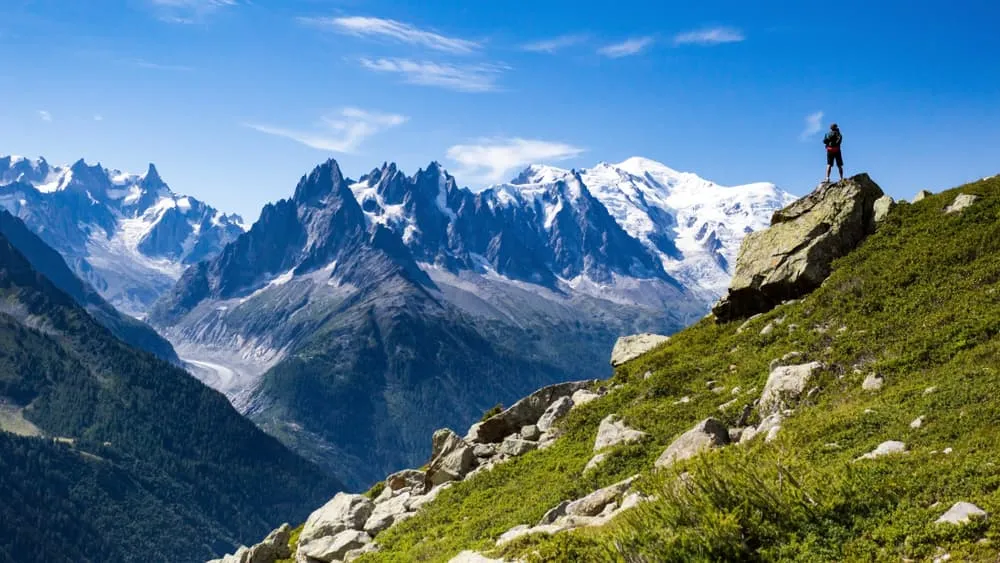
The Tour du Mont Blanc is one of the most famous trekking adventures available in Europe. When talking about mountain trekking, most people think about trekking in Nepal or climbing higher peaks like Mount Kilimanjaro . However, there are options to go trekking closer to home. In this article, we will provide you with all the information you need for this adventure, from the difficulty of the trails, the accommodation along the way, a recommended itinerary for self-guided Tour du Mont Blank hikes, the cost and more!
Today we will introduce you to the majestic Mont Blanc, one of the most stunning massifs in Europe and a great adventure for those looking for some nature and fresh air. From stunning mountain views and snow-capped peaks to small and picturesque towns, this hike will leave you wanting more! Find out all you need to know about this European trekking adventure. Are you ready? Let's go!
Where Is the Tour du Mont Blanc?
Tour du mont blanc: difficulty and map, accommodation on the tour du mont blanc, what is the best season for the tour du mont blanc, tour du mont blanc itinerary and route, short or half tour du mont blanc, packing list for the tour du mont blanc, starting points for the tour du mont blanc hike, how to get to chamonix, tour du mont blanc: self-guided or with a guide, what to do in case of an emergency, how much does the tour du mont blanc cost, safe hiking tips for the tour du mont blanc, where can i book the tour du mont blanc.
This hike is one of the most famous in Europe and it crosses 3 countries: France , Italy , and Switzerland . The famous Tour du Mont Blanc is a 170-kilometer long circuit, which encircles the Mont Blanc massif and has 10 kilometers of ascent/descent. The trek can be completed in 7 to 11 days, depending on the route and physical condition. A part of the Tour du Mont Blanc shapes the Walker's Haute Route as well.
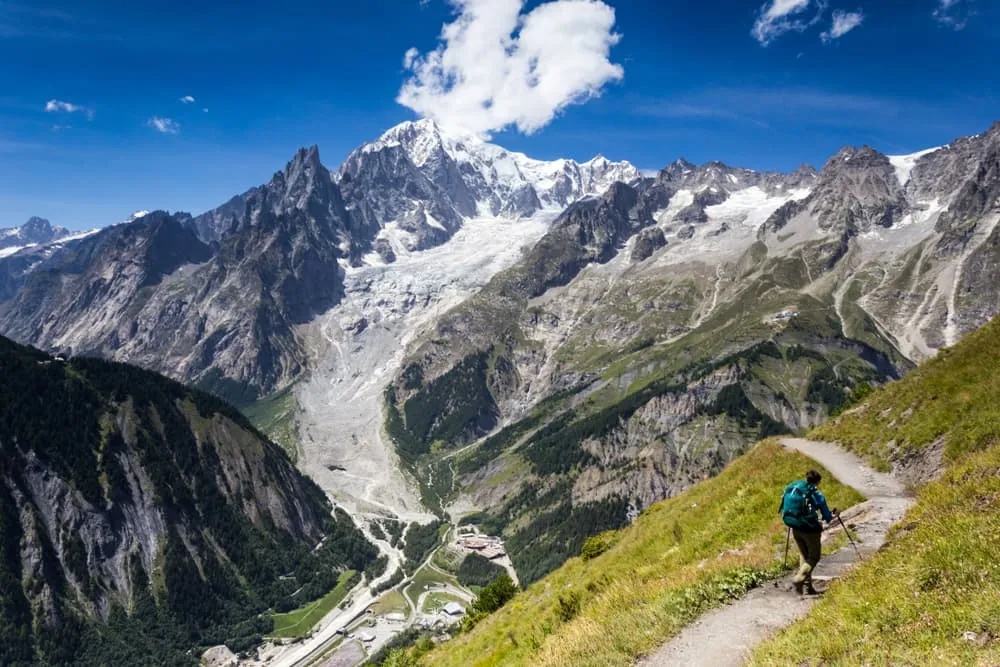
Full Tour du Mont Blanc
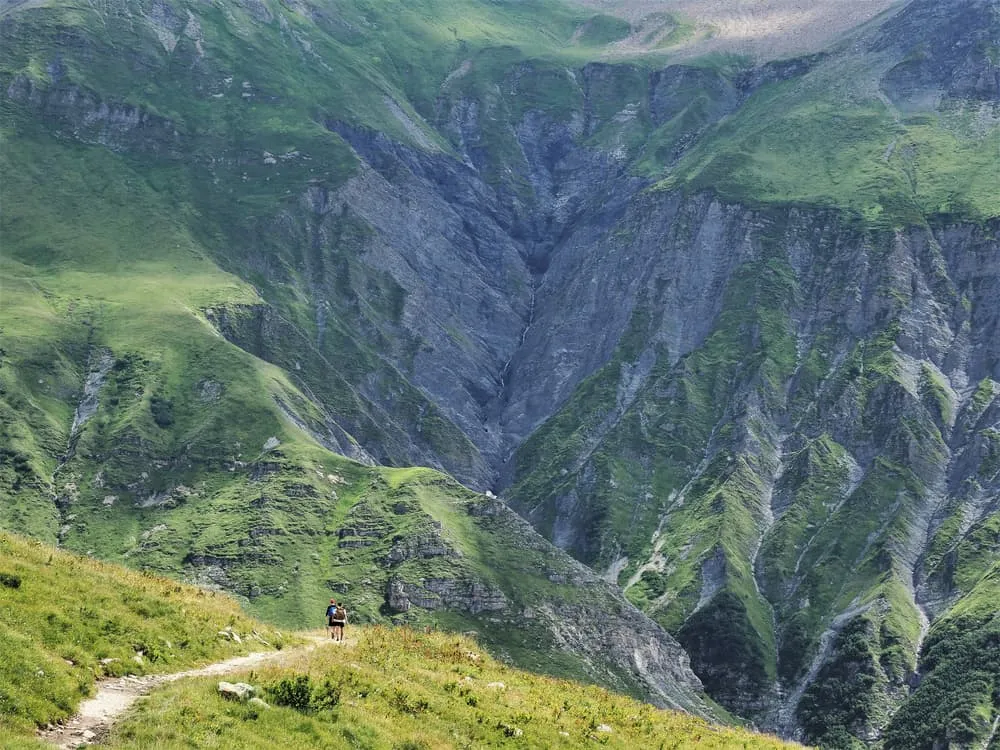
Western Tour du Mont Blanc
As we explained above, the Tour du Mont Blanc circuit is 170 kilometers long and has over 10 km vertical gain and loss. This means that the trek is definitely not a walk in the park. Although the route can be completed by almost anyone, if you are not used to this type of activity or if you don't do exercise regularly, chances are you won't enjoy it that much. In order to have a good experience and make the most out of this adventure, we recommend getting ready for it. You can start a couple of months in advance, climbing stairs, going for walks daily, and trying your trekking boots and backpack in advance. Remember that you will be walking 6 to 8 hours a day for at least a week, never underestimate such an expedition. On the Tour du Mont Blanc there's lots of uphill hiking and you will not always like it!
The accommodation options on the Tour du Mont Blanc are quite varied. On the route, you will find, in all countries, cosy mountain huts or refuges where to spend the night. Most of these huts offer a more affordable option, which involves sleeping with other trekkers in shared dormitories, and more expensive alternatives, where you can choose to have a private room. If you want a more luxurious option, you can choose to sleep in hotels in the towns close to the route.
Most huts offer a half-board pension, which includes breakfast and dinner. We highly recommend choosing this option. Having a warm meal waiting for you at the hut is not only a great way to end a long day of hiking, but it will also make your luggage lighter. Carrying your own food during the trek will mean extra weight on your back.

The best time to complete the Tour du Mont Blanc is during the summer months, July and August, when the route has little snow and the weather is usually good. Outside these months, the logistics get more complicated because many of the hostels and mountain huts on the route are closed. If we had to recommend a more specific time, it would be the second half of August. During these 2 weeks, the number of trekkers and mountaineers is lower and the weather is usually quite pleasant.
Did you know that we can book all huts and refuges for the Tour du Mont Blanc for you? Check out all our options here .
This is a 10-stage itinerary, during which you will cross 3 countries and you will walk around 170 kilometres. On the way, you will visit the valleys of Chamonix, Miage, and Les Contamines. Moreover, you will visit Lac Blanc and cross the Bonhomme Pass. This itinerary follows the classic route and makes sure that you don't miss any of the highlights of this wonderful trek.
From Chamonix / Les Houches to Auberge Du Truc
Auberge du truc.

From Auberge du Truc to Refuge De La Balme
Refuge de la balme.
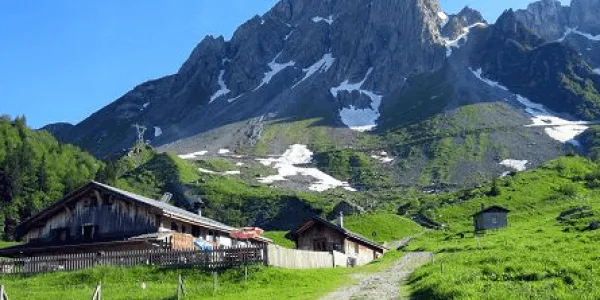
From Refuge de La Balme to Refuge des Mottets
Refuge des mottets.
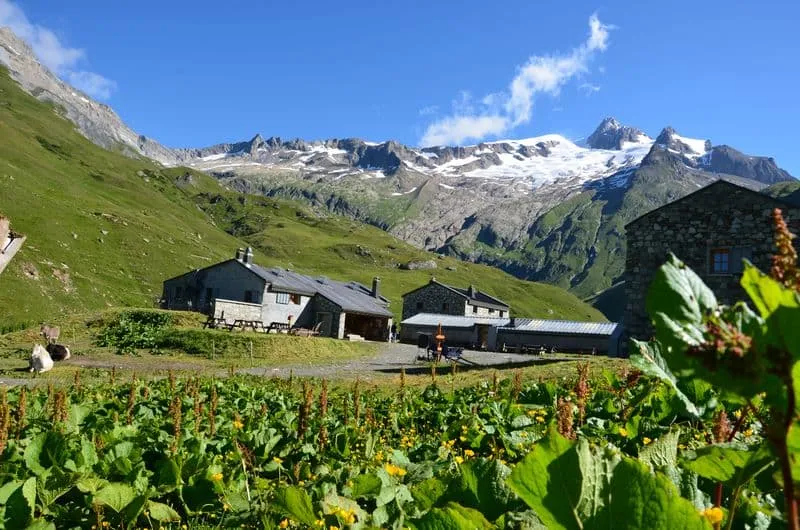
From Refuge des Mottets to Rifugio Maission Vieille
Rifugio maison vieille.

From Rifugio Maission Vieille to Rifugio Gio Bertone
Rifugio gio bertone.
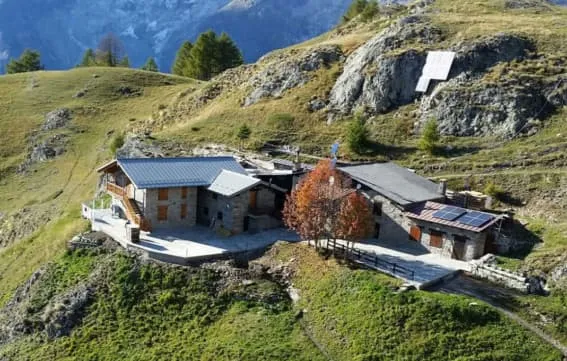
From Rifugio Gio Bertone to Gite Alpage de La Peule
Gite alpage de la peule.
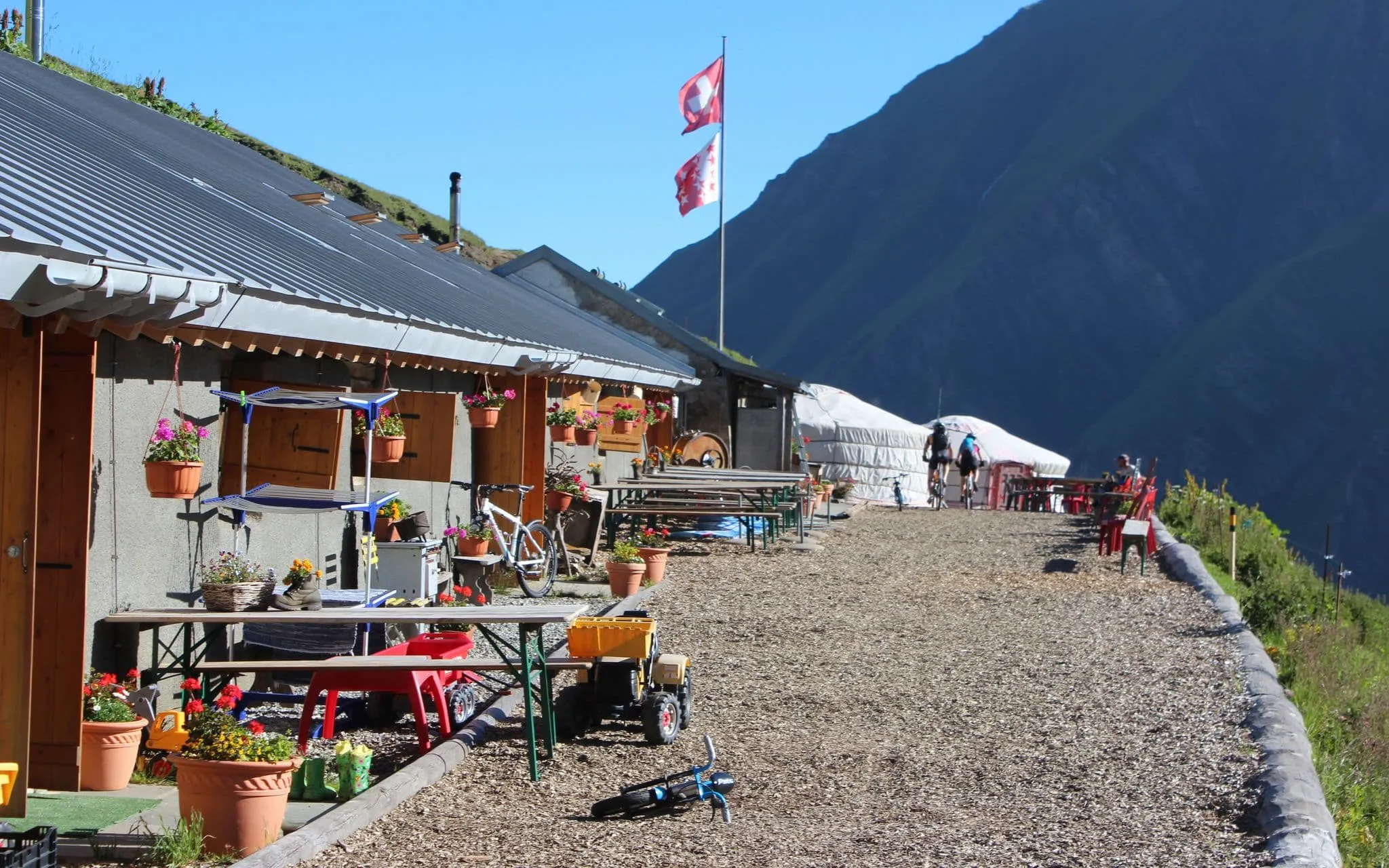
From Gite Alpage de La Peule to Relais D’Arpette
Relais d'arpette.
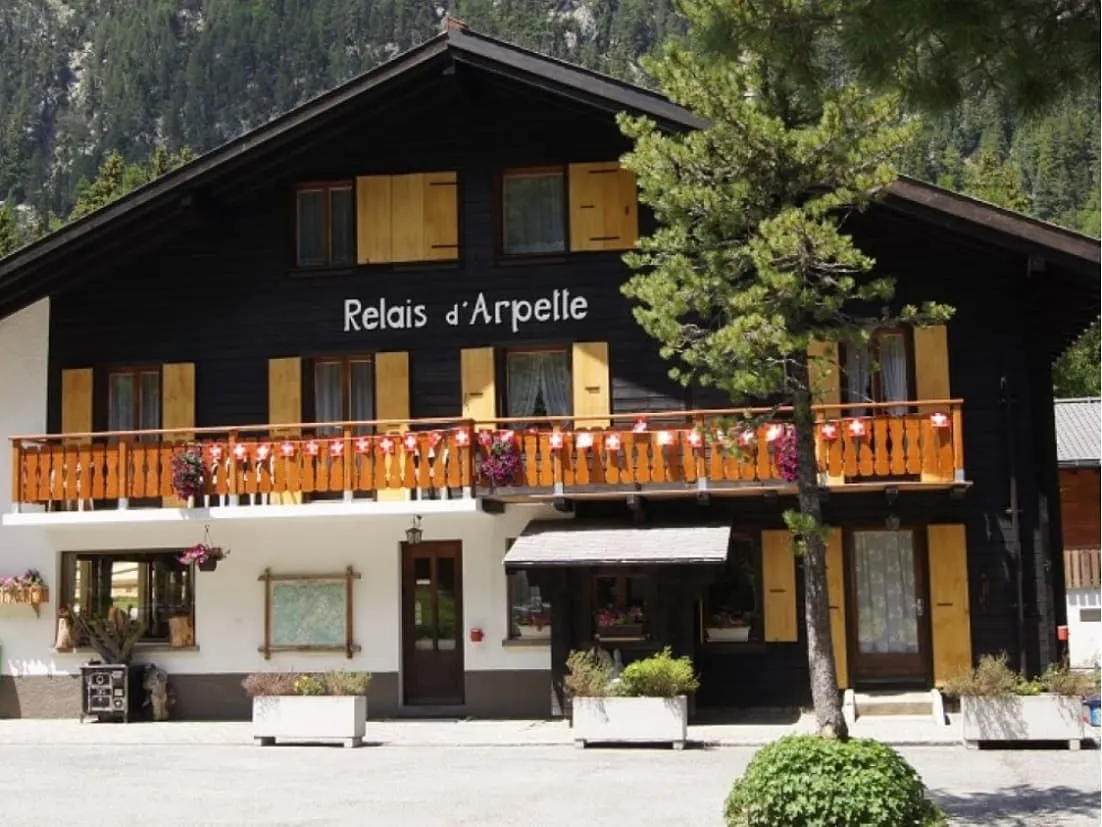
From Relais D'arpette to Auberge Mont Blanc
Auberge mont blanc.
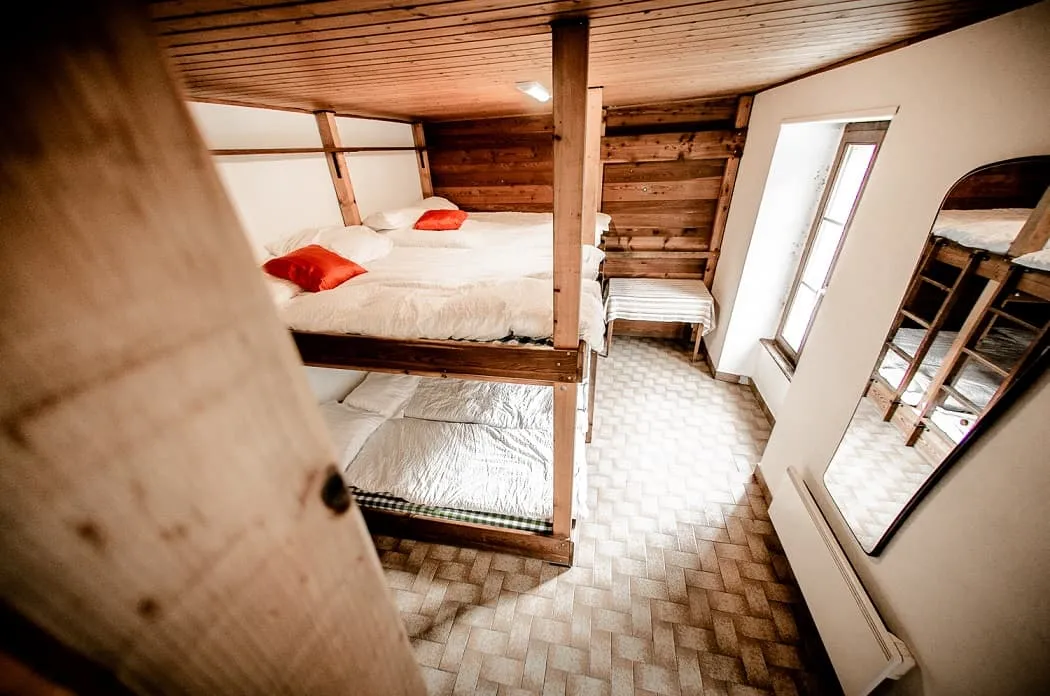
From Auberge Mont Blanc to Gite le Moulin
Gite le moulin.

From Gite Le Moulin to Chamonix
Are you short on time or don't have the legs to hike the Alps for more than a week? No problem. Because the towns of Chamonix and Courmayeur are connected by the majestic Mont Blanc Tunnel, it's easy to just do half of the route. It is possible to start in any town along the route, but most people start in Chamonix. From Chamonix, you can hike in 5 days to Courmayeur, following the trails on the Western side of the Mont Blanc with highlights like the Bionassay glacier, Croix du Bonhomme, and Mottets.
Find our 5-day Western Tour du Mont Blanc option here.
One can also start in Courmayeur. This will take you East across the infamous Col Ferret to Switzerland. From here you can do Fenetre d'Arpette to get back to Chamonix. This will take you 6 days. Both shorter options are not necessarily easier, but definitely shorter. When availability becomes an issue on the Western side, the Eastern route can also be a great outcome.
Find our 6-day Eastern Tour du Mont Blanc option here.
Since the Tour du Mont Blanc is a circular route, there are many starting points on the route. The most common, by far, is Chamonix or the nearby town of Les Houches on the French side. However, you can also choose to start at any of the other main towns en-route, like Les Contamines in France, Courmayeur in Italy, or Champex in Switzerland.
To get to Chamonix, you can fly to Geneva and hire a transfer in advance to take you to this Alpine city. Transfers leave directly from the airport and are located as you leave the arrivals gate. You can travel within the valley between Chamonix and Les Houches on a local bus.
At Bookatrekking.com, we not only book your huts, we also send you on your way with a comprehensive hiking guide with the most important information for your Tour du Mont Blanc, including interactive Komoot maps. Browse all our options here and turn your dreams into reality.
Fortunately, getting to Chamonix is quite easy. Chamonix is located only 103 kilometres away from Geneva international airport, the second-largest airport in Switzerland. There are several transport options for you to get to this beautiful city depending on where you are departing from.
Flying is the most convenient and fastest way to get to Chamonix. Although the Geneva international airport is indeed the closest one, you can also fly to Chambery Airport, Turin Airpot, or Lyon Airport. Being Geneva's biggest airport in the area, it has more flight options available from more destinations than the other airports do. Also, from Geneva, you can take a direct shuttle from the airport to Chamonix.
If you are in France already or in any country near Chamonix, you can drive there. The extensive network of European motorways makes it easy to reach Chamonix by car.
There is a train station right in the centre of the city. Travelling to Chamonix by train isn't necessarily the easiest or fastest option, but it is definitely the one with the least impact on the environment. On your way to Chamonix, you will have to change trains a few times along the way. The silver lining is that you are allowed to carry more luggage without additional charges.
Coach or long-distance buses are another option to get to Chamonix. The good thing about these buses is that they tend to be quite cheap and are more environmentally friendly than flying. If you choose this option, however, you must know that the seats can be quite uncomfortable and the ride takes the longest of all the options.
You can do the Tour do Mont Blanc guided or self-guided, it is up to you. If you decide to go with a guide, you will have the accommodation and meals arranged for you and you won't have to worry about planning every stage of the route. Most importantly, there is no chance of you getting lost. That being said, the truth is that the trails on the Tour du Mont Blanc are very well marked and signposted. If the weather is clear and you follow the road, the chances of getting lost are very limited. As regards the weather, it can get quite foggy in the afternoons, so make sure to have a map, a compass (and know how to use it), and a whistle just in case.
It is possible to do the Tour du Mont Blanc without a guide and most trekkers choose this option. If you want to go on a self-guided trek, make sure you get all the accommodation booked in advance and you plan your steps wisely, making sure that every stage of the trek makes sense and is achievable. If you want to go on a self-guided trek but you want some assistance with the planning, we can help you out. On Bookatrekking.com we offer self-guided Tour du Mont Blanc treks where we take care of arranging the itinerary and accommodation for you. That way, your only concern will be enjoying the views along the way. Find out all our options here.
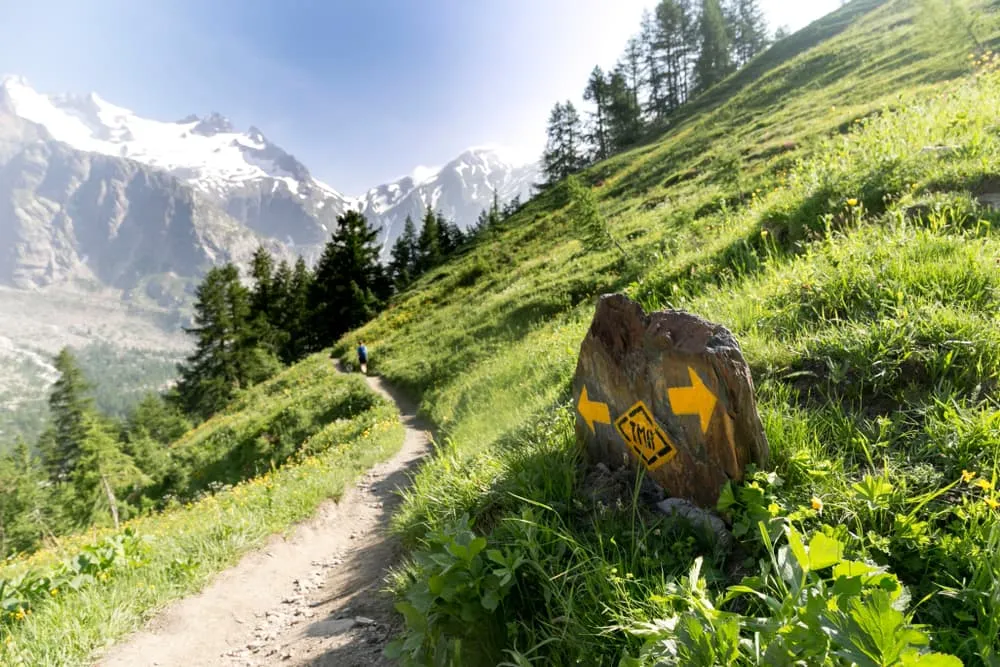
A situation is defined as an emergency whenever human life (yours or someone else's) is endangered and there is nothing you can do to resolve the matter. You should call for help if there has been an accident, if there is somebody trapped, if you got lost or in trouble and are unable to continue because of the time of day or weather conditions, or if you are trapped because of technical climbing challenges that exceed your capabilities.
The most important thing to do in an emergency is to stay calm and survey the situation. Do not panic or take useless risks if the people in trouble are difficult to reach. In an emergency, first and foremost, call for assistance. When calling for help, make sure to provide your location and the number of victims and type of injuries. Then, protect the victim from cold and other environmental threats and administer first aid, if you can.
Useful emergency phone numbers
- Italy: 118 / 112 / 800 319 319 (Civil Protection)
- France: 112 / +33 0 4 50 53 16 89 (PGHM Chamonix)
- Switzerland: 144
The price prices for the Tour du Mont Blanc are quite varied. The full circuit usually ranges between EUR 900 / USD 1020 and EUR 2800 / 3175 USD. There are several variables to take into account when it comes to how much this trek costs: the type of accommodation, which can be in a shared dormitory or a private room in a hut, or also at a hotel in a town; How many days you will be spending on the mountain and whether you will be doing the full circuit or only a section; whether you will be doing it self-guided or with a guided group. The price of the trek will depend on your expectations for the tour.
Not sure yet or want to discuss your plans for the Tour du Mont Blanc with one of our trekking experts? Get in touch today and turn your dreams into memories!
Know your limits
Hiking the Tour du Mont Blanc is the perfect outlet to escape from daily life. It is an endurance sport along with a beautiful nature experience with a positive effect on body and mind —as long as one is in good shape and has a realistic picture of one's possibilities and limits—. Never overestimate yourself or underestimate the route. Don't overdo it! Always choose the slower variant and take more time for your plans. Hiking under time pressure is not fun and at too fast a pace it can be dangerous. Be wise!
Plan carefully
Good planning is half the work! Hiking maps, literature, the Internet and expert advice are invaluable when planning the route in the Tour du Mont Blanc and enable you to determine the length, altitude difference, difficulty and conditions of the hike. When planning group treks, the itinerary should always be planned for the weakest member of the group! The weather in the mountains can change incredibly quickly and rain, wind and cold all increase the risk factor. For this reason, always check the weather forecast beforehand and contact our trekking experts to find your way around before you start.
Be fully equipped
Equipment is everything. In the most extreme case, it makes the difference between life and death, and in any case, it definitely makes the difference between having fun and having a bad time. Food and water, sunscreen and waterproof and warm clothes must always be in your backpack, as well as a first aid kit and a mobile phone with a full battery (in case there is an emergency). However, packing light makes walking easier, so don't take too much extra luggage with you. Your equipment should always be suitable for the terrain you'll be hiking on in the Tour du Mont Blanc.
Wear suitable footwear
Good walking shoes protect your feet and provide a better fit. Shoes with a good fit, with non-slip soles, water-resistant and lightweight are a must for additional walking pleasure during the Tour du Mont Blanc. Trail running shoes are great for a weekend in the mountains, but on longer hikes or more technical trails, you'll want at least A/B hiking boots. That means it is recommended wearing high mountain shoes that are water-repellent with extra ankle support to prevent sprains.
Stay on marked trails
Tour du Mont Blanc has endless marked hiking trails, which are controlled and maintained and should not be deviated from. It may be tempting, but it's not a good idea to take shortcuts or alternative routes through unmarked terrain. It increases the risk of disorientation and you're more likely to get lost and have accidents or fall in the mountains. Even steep slopes of packed old snow are often underestimated and dangerous. Are you in doubt? Better don't do it. For easy navigation we work with our trusted partner Komoot, whose interactive maps, also available offline, provide you with the necessary digital means to get from A to B. As a backup, make sure to bring a hiking guide or a paper map with you. FYI, 75% of stumbles occur due to carelessness on marked paths or roads, not in open terrain!
Take regular breaks
Remember you're on a hiking holiday. Timely and regular breaks not only provide welcome relaxation but also make it possible to enjoy the Tour du Mont Blanc. The body needs a regular food and drink intake to maintain performance and concentration. Our advice is that if you have little time, it's better to follow the short itinerary than to speed up the long one.
Stay reachable
If you are hiking solo or in small groups it is advisable to inform people back home about your plans, what route you are taking and when you plan to return. Even small incidents can lead to unpleasant emergencies so make sure you are available at all times. Bring a charged phone containing at least the phone numbers of immediate family members, your accommodations en route and the emergency phone numbers operating in the Tour du Mont Blanc.
Respect nature
Leave no rubbish behind, prevent noise, stay on the marked trails, do not disturb wildlife or grazing animals, and respect protected areas.
At Bookatrekking.com you can book the self-guided Tour du Mont Blanc and many other treks. We take care of all the details for you, including arranging accommodations and providing you with relevant information well in advance of your trek. Find our offers here . Our easy-to-use platform allows you to browse and compare different trekking options and find the perfect fit for your interests, abilities, and budget.
If you have any questions about a specific trek or need help choosing the right one for you, our team of trekking experts is here to assist you. Simply reach out to us and we will be happy to provide you with personalized recommendations and advice to help you plan the trekking adventure of a lifetime.
Is the Tour du Mont Blanc not your cup of tea and are you looking for other epic adventures? Check out one of our following blog posts:
- Peter Habeler Runde
- Salzburger Almenweg
- Berliner Höhenweg
Switzerland
- Via Alpina 1
- Hut-to-hut in Slovenia
- Climb Mount Triglav
- Palaronda Trek
- Alta Via del Granito
- Walker's Haute Route
- Tour du Mont Blanc
- Tour du Mont Thabor
- Hut-to-Hut in Mercantour
- Carros de Foc
- Porta del Cel
- Peaks of the Balkan Trail
- Menalon Trail
- Corfu Trail
- Climbing Olympus
- Laugavegur Trail
- Fimmvörðuháls Hike

Also Interesting
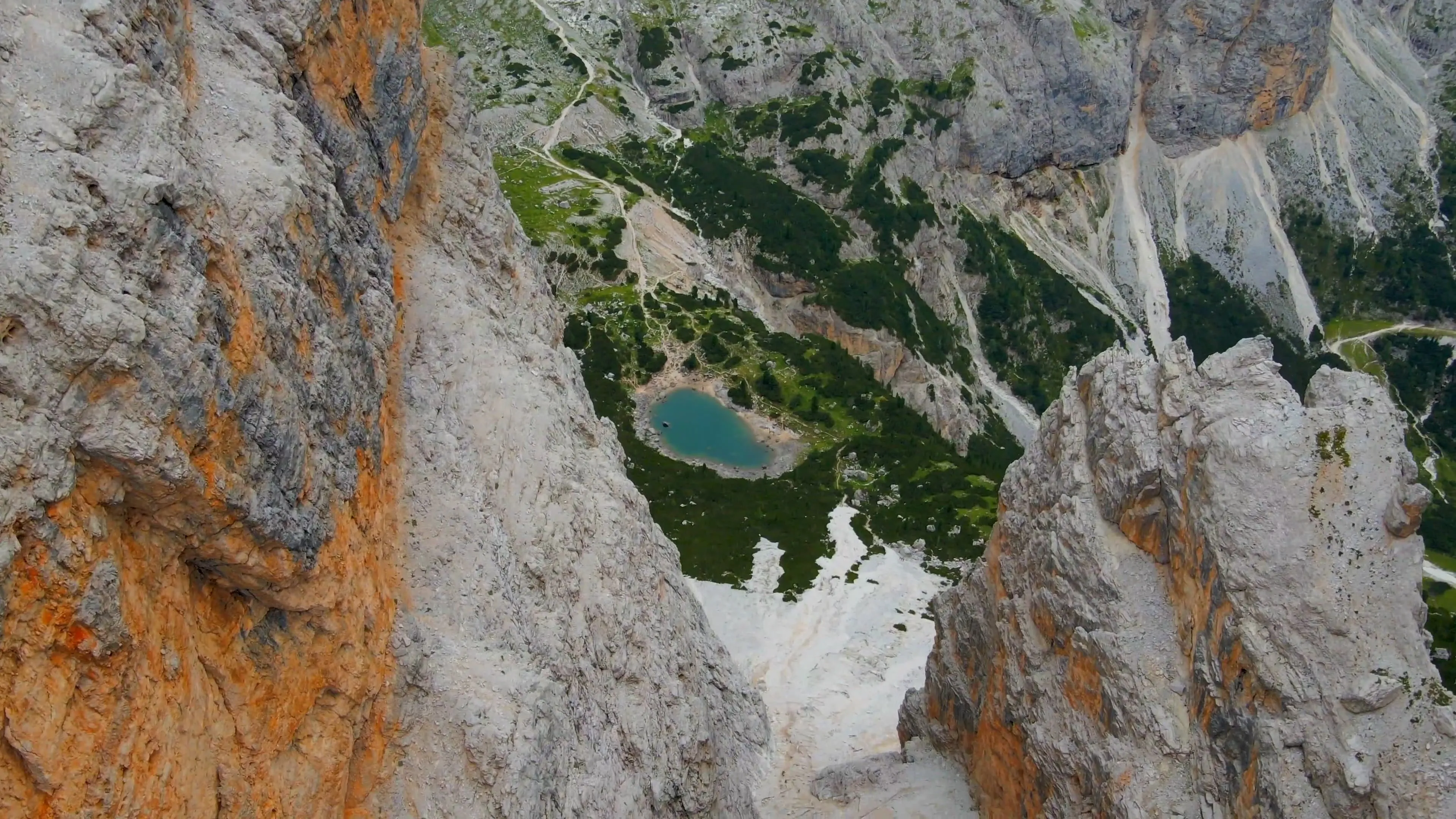
Alta Via 1: Map, Difficulty, and Route on the Italian Dolomites
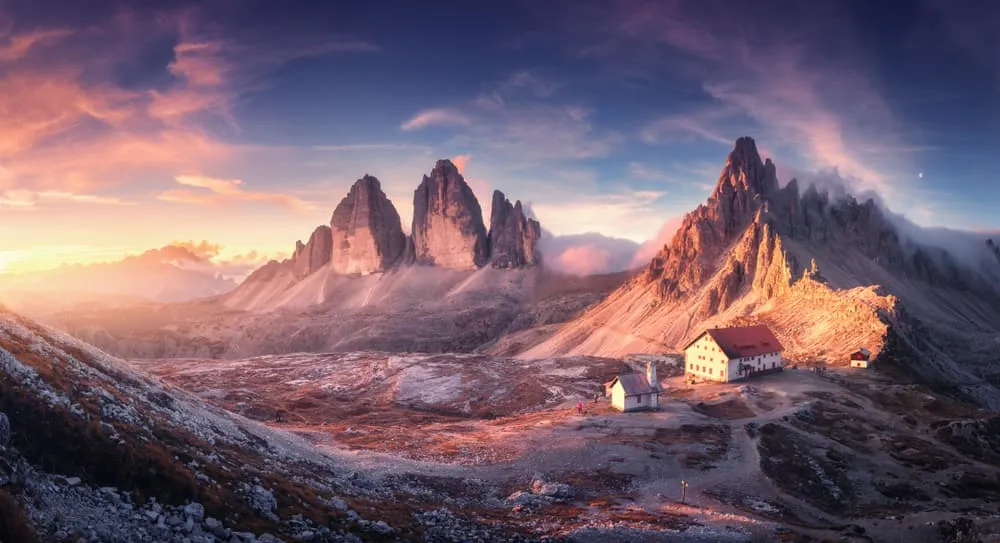
Dolomites Hiking: The 8 Best Options for Hiking Hut-to-Hut in Italy
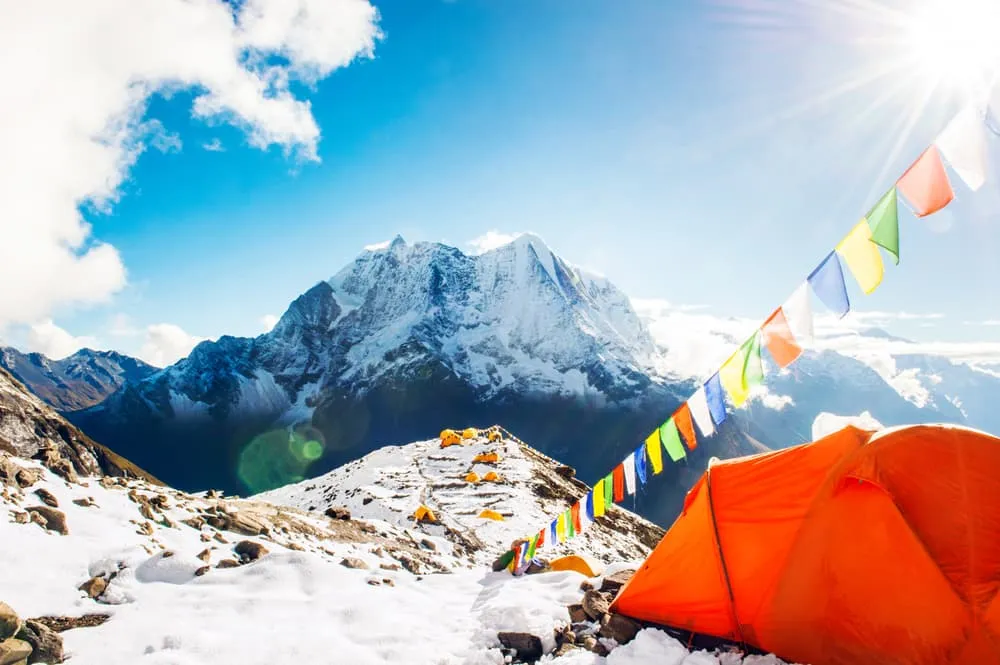
Everest Base Camp: A Trek to The Roof of The World
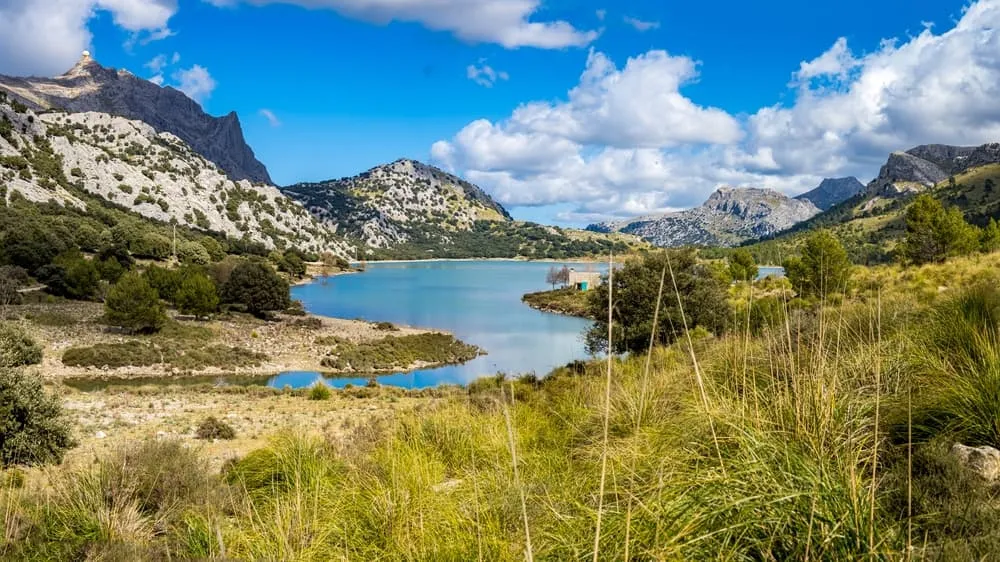
Hiking the GR221 in Mallorca: Everything You Need to Know
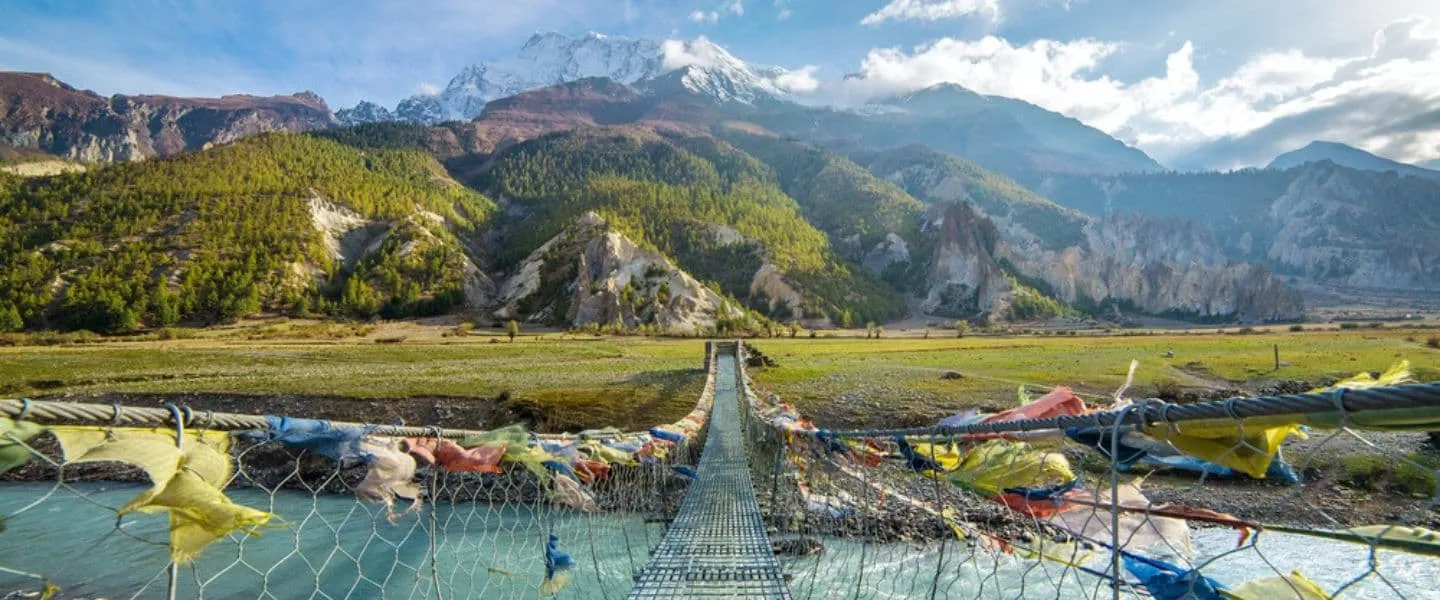
Annapurna Circuit Trek: How to Hike Around the Annapurnas
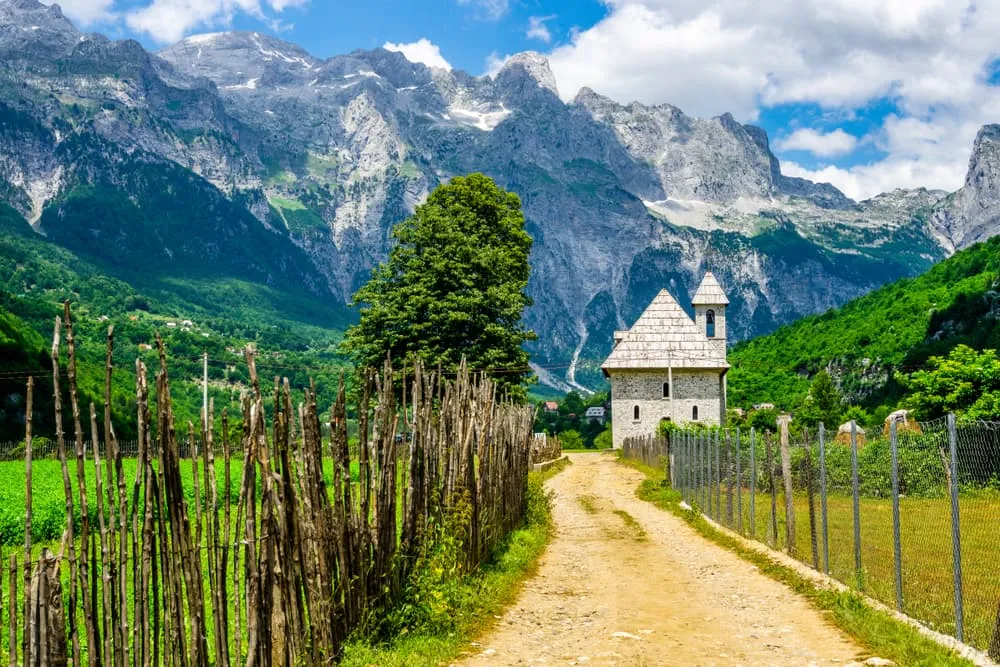
Peaks of the Balkans Trail: All You Need to Know

Hut-to-Hut Hiking in the Pyrenees: The 4 Best Walks
Get weekly inspiration with the best treks.

- Financial Protection
- Tel: +44 1273 256753
- Route of the Tour du Mont Blanc

Starting in the Chamonix Valley, you trek in a clock-wise direction along well-maintained trails to small villages where you will spend the night. The views are outstanding throughout: huge granite spires, tumbling glaciers, snowy peaks and fast-flowing rivers. You will see magnificent Alpine flowers, birds of prey and animals such as ibex, chamois, stoats and marmots. During the trek, you stay at hotels for nine nights and spend one night at an auberge.
Day One: Arrival at Geneva Airport
Geneva Airport is accessible from the USA, Australia, New Zealand, the UK, Canada, and Europe. From there it is just 1 hour to get to the Chamonix Valley by minibus. For our guided Tour du Mont Blanc, transfers are available at an extra cost from the airport to the first hotel in Chamonix.
Geneva is well connected by rail to the rest of Europe and the UK. There is a direct train from the UK to Chamonix.
Day Two: Chamonix to Argentiere
The trek begins by crossing to the other side of the valley in 10 minutes and then hiking for 90 minutes on the undulating path that follows the River Arve to Chamonix (1030m). You then continue to Les Praz in 30 minutes. From here you can walk up to the Chalets de Flegere (1900m) in 90 minutes or take the cable car up in seven minutes. At the top of the Flegere cable car you hike through open countryside for 1.5-2 hours to Lac Blanc (2352m). There are incredible views of the whole Mont Blanc range, including Les Grandes Jorasses, Aiguille Vert and Les Drus. You then follow a beautiful path east and descend through the forest to Argentiere.
Day Three: Argentiere to Trient
From the French village of Argentiere you hike through old Argentiere and up to the Col des Posettes (1997m) for superb views Mont Blanc and the Chamonix Valley. From here, you traverse to the Col de Balme (2191m) and look directly into Switzerland. You then descend through open country with views of glaciers to Trient (1297m).
Day Four: Trient to Champex Lac
A short, steep climb takes you to the Col de la Forclaz (1526m). From La Forclaz you hike steadily upwards through the forest along the ‘Bovine Route’ with magnificent views of the mountains of Verbier and the great Sion Valley. At Bovine (1987m) there is a small farm and the route then winds its way down through meadows, forests and open country. Just before Champex there is an auberge where you can sit in a garden amongst the charming forests of Champex d’en haut. You arrive at Champex Lac (1486m) with its beautiful lake-side hotels and cafés.
Day Five: Champex to La Fouly
Leaving the lakeside village of Champex it is a gentle 5-6 hour trek to La Fouly (1600m) along the Val Ferret. You walk from the lake and descend to the main valley floor and follow the river through forests and meadows to Praz-de-Fort. You then ascend in similar surroundings with wonderful views of Mt Dolent and the South Face of the Mont Blanc range. La Fouly (1600m) is a pretty Swiss village.
Day Six: La Fouly to La Palud, Courmayeur
You continue from La Fouly and cross into Italy via the impressive Grand Col Ferret (2537). From here, the descent is slightly steeper but rewards you with outstanding views of two of the Alps most iconic mountains – Les Grandes Jorasses and Mont Blanc. You stay at La Palud (1350m), just over 3km from Courmayeur.
Day Seven: Rest day in La Palud or hike to La Visaille
Today can be used as a rest day or to hike to La Visaille meaning you complete the whole circuit of the TMB on foot. The accommodation at the half-way point between 4 La Palud (Courmayeur) and Les Chapieux is not good enough and so we spend two nights at La Palud. If you choose to walk, you head to Courmayeur (1200m) and then up to the Col Chécrouit (1956m). From here you follow the TMB trail with superb views of the whole of the South Face of Mont Blanc. The mountain is much steeper this side, compared to the views from Chamonix, with fabulous long ridges and gullies – many of which offer the most challenging routes to mountaineers. You descend to La Visaille (1659m) and then take a 15-minute bus ride back to Courmayeur. Hiking time is around 5 hours. Distance: 7 miles (11km) with 3,600 feet (1100m) of ascent and 2100 feet (640m) of descent. You can take a cable car from Courmayeur to gain height and take the edge off the ascent.
If you choose to use today as a rest day, Courmayeur is one of Italy’s premier ski resorts and is full of pretty shops, cafés and restaurants. Close by, there is the excellent Skyway cable car, the spa at Pre St Didier and lots of gentler walking options. You could also head to Aosta (one hour by bus) to see Roman walls, an amphitheatre and medieval walls and buildings.
Day Eight: Courmayeur to Les Chapieux
From Courmayeur, we take 2 public buses (approx 10 and 20 minutes each) and travel to Val Veny under the spectacular South Face and ridges of Mont Blanc. We trek along a wide glacial valley surrounded by glaciers and high peaks to the Col de la Seigne (2516m) which marks the border between France and Italy. We then descend to Les Chapieux (1549m). Today is quite a long day, although it is not steep.
Day Nine: Les Chapieux to Les Contamines
We make a steep ascent above Les Chapieux through marmot country and on through open meadows to more barren scenery. We cross 2 cols (2479m and 2329m) in wild surroundings with fabulous Alpine Flowers and marmots, weasels and chamois. We then head down through open country and on to a narrowing valley to Notre-de-La-Gorge where there is a 15 th century chapel. Our destination is Les Contamines (1167m) – a pretty ski village with an interesting church. The hotel is located 1km outside of the centre of Les Contamines.
Day Ten: Les Contamines to Les Houches
We ascend thought pretty forests and meadows to the Chalets du Truc perched under the great west-face of the Mont Blanc range. There is a small peak we can climb before descending to the Chalets de Miage at 1559m. We then make a steep climb to the Col du Tricot (2120m) and then on towards the plateau above Les Houches. This is a fitting end to our trek with the most outstanding views of the Chamonix Valley, the Chamonix Aiguilles and the Mont Blanc massif. We descend quickly by cable car and take a short ride by public bus to our hotel.
Day Eleven: Trip ends in Les Houches
Check out from the hotel is normally 11am. If you have booked a transfer to Geneva Airport through us we will let you know the pick-up time the previous evening (day 10).
Get in touch today if you want to find out any more details about the Tour du Mont Blanc.
Information Directory
- Cost of the Tour Du Mont Blanc
- Advice for the Tour du Mont Blanc
- How hard is the Tour du Mont Blanc?
- Attractions on the Tour du Mont Blanc
- Hotels on the Tour du Mont Blanc
- Food Recommended on Tour Du Mont Blanc
- Accomodation on the Tour Du Mont Blanc
- Airports Near the Tour Du Mont Blanc
- Temperatures on the Tour du Mont Blanc
- Weather Conditions on the Tour du Mont Blanc
- Location of the Tour du Mont Blanc
- Altitude on the Tour Du Mont Blanc
- Highest Point of the Tour du Mont Blanc
- Gear List for the Tour Du Mont Blanc
- Equipment for the Tour Du Mont Blanc
- Packing for the Tour du Mont Blanc
- Shoes & Boots for the Tour Du Mont Blanc
- Luggage for the Tour du Mont Blanc
- Navigation on the Tour du Mont Blanc
- Fitness Levels Needed for the Tour Du Mont Blanc
- Distance on the Tour du Mont Blanc
- Walking, Hiking & Trekking
- Guides on the Tour Du Mont Blanc
- Villages on the Tour du Mont Blanc
- Trails on the Tour Du Mont Blanc
- The Mountain – Tour du Mont Blanc
- Dangers on the Tour du Mont Blanc
- Tour du Mont Blanc Safety
- Planning for the Tour du Mont Blanc
- Organiser of the Tour du Mont Blanc
- Length of the Tour Du Mont Blanc
- Info About the Tour Du Mont Blanc
- Itinerary on the Tour Du Mont Blanc
- Highlights of the Tour Du Mont Blanc
- Eccles Refuge
Tour du Mont Blanc Training Tips, How and When to Hike TMB, Wisdom | Hike Strong Podcast | Ep. 02 Hike Strong Podcast
Marcus Shapiro is joined by Mags and Olly - Tour du Mont Blanc experts! They both share a passion for the Tour du Mont Blanc hike a.k.a. TMB. After listening to the discussion, you will feel confident about committing to this iconic hike. Below is a sampling of some discussion topics: - Make your pitch for why someone should pick the TMB if they could only make one trip this year. - What is the most common fitness question you get? - Do you find a difference in fitness levels between self-guided and guided travelers? - When someone has to abandon the TMB due to low fitness, what do you think they left out of their program? - What is the biggest surprise most people experience on TMB? - What do your guides find most people struggle with on TMB? - What surprises most people when they begin researching TMB? - Do many people underestimate the elevation gain per day? - Describe the most challenging 2 stages and why. - What percentage of hikers take on one variant or more? - What would be a good target pack weight to aim for in different scenarios? - Most hikers hike anti-clockwise so that the views of Mont Blanc are always in front of them, but there are advantages to hiking clockwise. Please discuss. - It is common to Cover the entire Tour du Mont Blanc in 11 days. Detail other ways to experience the TMB. Mags is omnipresent online, providing confidence to those who want to hike the TMB without a guide. Olly is the operations director, managing the running of all the trips for Adventure Base and will get you all set to hike with a guide. They are both based in Chamonix in the French Alps and live at the foot of Mont Blanc - the start/finish of the famous multi-day trekking route - Tour du Mont Blanc. Mags Nixon https://tourdumontblanchike.com/ Olly Alkema / Adventure Base https://adventurebase.com/ Ask Me How To Get Fit For Your Next Hike, Trek or Backpacking Trip: https://fitfortrips.com/consultation/ Check Out The Hiking Bucket List Builder System (includes training plan): https://fitfortrips.com/hiking-challenge/ LIKE & SUBSCRIBE for new videos: https://www.youtube.com/@UCNOVNztd2ujN5GmFjyMRkfw Check out the audio podcast version on all platforms: https://fitfortrips.com/hikestrongpodcast
- More Episodes
- © 2024 Hike Strong Podcast

- TripAdvisor
- Testimonials
- Travel Tips
Moscow Metro Map 2005 (Official) Eng/Rus
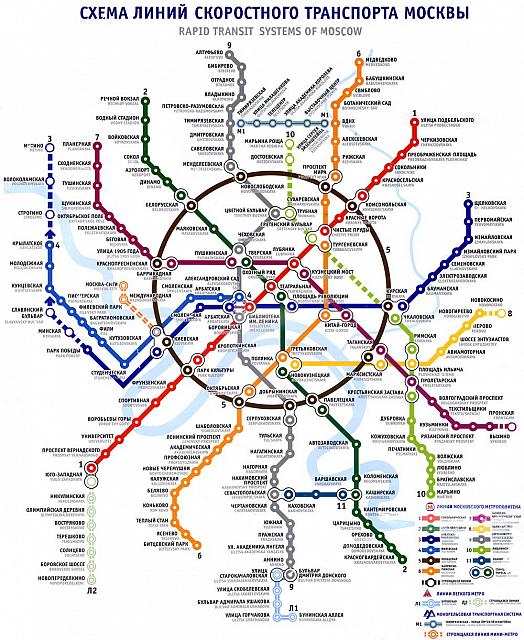
About Me in Short

My name's Arthur Lookyanov, I'm a private tour guide, personal driver and photographer in Moscow, Russia. I work in my business and run my website Moscow-Driver.com from 2002. Read more about me and my services , check out testimonials of my former business and travel clients from all over the World, hit me up on Twitter or other social websites. I hope that you will like my photos as well.
See you in Moscow!
- View full size
- Owner: Moscow Guide & Driver
- Date: August 19, 2005 08:00:00 pm EDT
- File name: Moscow-Metro-Map-2005-Official.jpg
- Tags: Russia , Moscow Metro , maps , Moscow Metro Map , Moscow Metropolitan , Moscow
Google Maps
- GPS Map of Moscow Guide & Driver's pictures
Random image

Novodevichy Convent in the Moonlight
The Novodevichy Convent, lying by a river bend on the South-Western edge of old Moscow, is one of the city`s most beautiful cloisters and major spiritual centers from centuries back. Built in the 16th and 17th centuries in the so-called Moscow Baroque style, Novodevichy convent was part of a chain of monastic ensembles that were integrated into the defense system of the city.
Featured Tags
- 273 photos are tagged with architecture
- 199 photos are tagged with cathedrals
- 305 photos are tagged with churches
- 294 photos are tagged with Dear Clients
- 260 photos are tagged with lights
- 1875 photos are tagged with Moscow
- 306 photos are tagged with Moscow by Night
- 194 photos are tagged with Moscow cityscapes
- 264 photos are tagged with Moscow Kremlin
- 326 photos are tagged with night moscow
- 426 photos are tagged with Orthodox Churches
- 226 photos are tagged with Red Square
- 2538 photos are tagged with Russia
- 209 photos are tagged with twilights
- 350 photos are tagged with Winter
Take one of these exciting tours:
- Moscow Highlights
- Discovering the Golden Ring of Russia
- Arts & Culture Tours
- Moscow by Night tour

km travel chesterfield 2024 brochure prices
This is our KM Travel Tour Operators page, we have listed the full address of KM Travel as well as phone numbers and websites. KM Travel is in Chesterfield, KM Travel may offer holiday tours, sightseeing tours, and general city tours in Chesterfield.
If you have used KM Travel before be sure to leave your own comment or rating on the city tour or holiday tour that you went on so other poeple wishing to use this company can read fair and honest reviews before the book there holiday with KM Travel. Please remember that KM Travel may offer much more that just UK holiday tours, UK Coach Tours and city tours so remember to contact the travel agents company using the details below to find out more information.
Latest KM Travel Reviews

- Transportation (Chesterfield)
- KM Travel Chesterfield
Chesterfield, United Kingdom
Related places.
- Get directions
- Photos page
QR code, vCard

Activate map
Business hours
Reviews of km travel chesterfield.
- Things to Do
- Restaurants
- Holiday Rentals
- Travel Stories
- Add a Place
- Travel Forum
- Travellers' Choice
- Help Centre
Lovely holiday - KM British & European Coach Holiday
- Europe
- United Kingdom (UK)
- England
- Yorkshire
- South Yorkshire
- Barnsley
- Barnsley - Things to Do
- KM British & European Coach Holiday
Brilliant holiday to Torquay, tinsel & turkey 20 th November to Belgrave Sands hotel. The hotel was... read more
Thanks to all at KM TRAVEL especially our driver courier Matt who made the trip more enjoyable and... read more
Trains Moscow to Elektrostal: Times, Prices and Tickets
- Train Times
- Seasonality
- Accommodations
Moscow to Elektrostal by train
The journey from Moscow to Elektrostal by train is 32.44 mi and takes 2 hr 7 min. There are 71 connections per day, with the first departure at 12:15 AM and the last at 11:46 PM. It is possible to travel from Moscow to Elektrostal by train for as little as or as much as . The best price for this journey is .
Get from Moscow to Elektrostal with Virail
Virail's search tool will provide you with the options you need when you want to go from Moscow to Elektrostal. All you need to do is enter the dates of your planned journey, and let us take care of everything else. Our engine does the hard work, searching through thousands of routes offered by our trusted travel partners to show you options for traveling by train, bus, plane, or carpool. You can filter the results to suit your needs. There are a number of filtering options, including price, one-way or round trip, departure or arrival time, duration of journey, or number of connections. Soon you'll find the best choice for your journey. When you're ready, Virail will transfer you to the provider's website to complete the booking. No matter where you're going, get there with Virail.
How can I find the cheapest train tickets to get from Moscow to Elektrostal?
Prices will vary when you travel from Moscow to Elektrostal. On average, though, you'll pay about for a train ticket. You can find train tickets for prices as low as , but it may require some flexibility with your travel plans. If you're looking for a low price, you may need to prepare to spend more time in transit. You can also often find cheaper train tickets at particular times of day, or on certain days of the week. Of course, ticket prices often change during the year, too; expect to pay more in peak season. For the lowest prices, it's usually best to make your reservation in advance. Be careful, though, as many providers do not offer refunds or exchanges on their cheapest train tickets. Unfortunately, no price was found for your trip from Moscow to Elektrostal. Selecting a new departure or arrival city, without dramatically changing your itinerary could help you find price results. Prices will vary when you travel from Moscow to Elektrostal. On average, though, you'll pay about for a train ticket. If you're looking for a low price, you may need to prepare to spend more time in transit. You can also often find cheaper train tickets at particular times of day, or on certain days of the week. Of course, ticket prices often change during the year, too; expect to pay more in peak season. For the lowest prices, it's usually best to make your reservation in advance. Be careful, though, as many providers do not offer refunds or exchanges on their cheapest train tickets.
How long does it take to get from Moscow to Elektrostal by train?
The journey between Moscow and Elektrostal by train is approximately 32.44 mi. It will take you more or less 2 hr 7 min to complete this journey. This average figure does not take into account any delays that might arise on your route in exceptional circumstances. If you are planning to make a connection or operating on a tight schedule, give yourself plenty of time. The distance between Moscow and Elektrostal is around 32.44 mi. Depending on the exact route and provider you travel with, your journey time can vary. On average, this journey will take approximately 2 hr 7 min. However, the fastest routes between Moscow and Elektrostal take 1 hr 3 min. If a fast journey is a priority for you when traveling, look out for express services that may get you there faster. Some flexibility may be necessary when booking. Often, these services only leave at particular times of day - or even on certain days of the week. You may also find a faster journey by taking an indirect route and connecting in another station along the way.
How many journeys from Moscow to Elektrostal are there every day?
On average, there are 71 daily departures from Moscow to Elektrostal. However, there may be more or less on different days. Providers' timetables can change on certain days of the week or public holidays, and many also vary at particular times of year. Some providers change their schedules during the summer season, for example. At very busy times, there may be up to departures each day. The providers that travel along this route include , and each operates according to their own specific schedules. As a traveler, you may prefer a direct journey, or you may not mind making changes and connections. If you have heavy suitcases, a direct journey could be best; otherwise, you might be able to save money and enjoy more flexibility by making a change along the way. Every day, there are an average of 18 departures from Moscow which travel directly to Elektrostal. There are 53 journeys with one change or more. Unfortunately, no connection was found for your trip from Moscow to Elektrostal. Selecting a new departure or arrival city, without dramatically changing your itinerary could help you find connections.
Book in advance and save
If you're looking for the best deal for your trip from Moscow to Elektrostal, booking train tickets in advance is a great way to save money, but keep in mind that advance tickets are usually not available until 3 months before your travel date.
Stay flexible with your travel time and explore off-peak journeys
Planning your trips around off-peak travel times not only means that you'll be able to avoid the crowds, but can also end up saving you money. Being flexible with your schedule and considering alternative routes or times will significantly impact the amount of money you spend on getting from Moscow to Elektrostal.
Always check special offers
Checking on the latest deals can help save a lot of money, making it worth taking the time to browse and compare prices. So make sure you get the best deal on your ticket and take advantage of special fares for children, youth and seniors as well as discounts for groups.
Unlock the potential of slower trains or connecting trains
If you're planning a trip with some flexible time, why not opt for the scenic route? Taking slower trains or connecting trains that make more stops may save you money on your ticket – definitely worth considering if it fits in your schedule.
Best time to book cheap train tickets from Moscow to Elektrostal
The cheapest Moscow - Elektrostal train tickets can be found for as low as $35.01 if you’re lucky, or $54.00 on average. The most expensive ticket can cost as much as $77.49.
Find the best day to travel to Elektrostal by train
When travelling to Elektrostal by train, if you want to avoid crowds you can check how frequently our customers are travelling in the next 30-days using the graph below. On average, the peak hours to travel are between 6:30am and 9am in the morning, or between 4pm and 7pm in the evening. Please keep this in mind when travelling to your point of departure as you may need some extra time to arrive, particularly in big cities!
Moscow to Elektrostal CO2 Emissions by Train

Anything we can improve?
Frequently Asked Questions
Go local from moscow, trending routes, weekend getaways from moscow, international routes from moscow and nearby areas, other destinations from moscow, other popular routes.
Na Ulitse Yalagina 13B Apartments
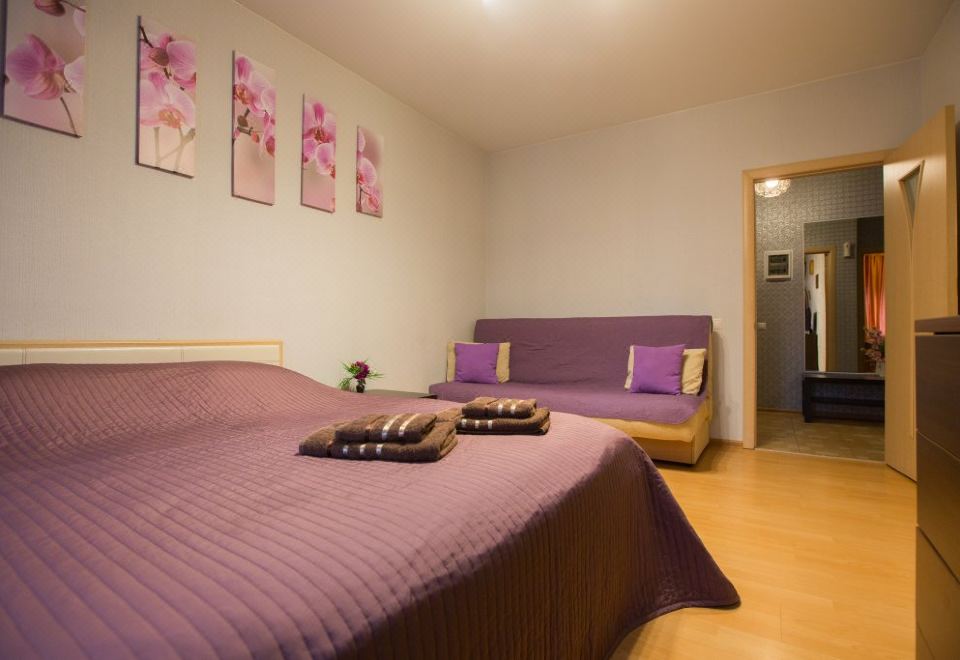
Trending Questions
Property policies, frequently asked questions, how much does it cost to stay at na ulitse yalagina 13b apartments, what are the check-in and check-out times at na ulitse yalagina 13b apartments, does na ulitse yalagina 13b apartments provide airport transfer services, what amenities and services does na ulitse yalagina 13b apartments have, does na ulitse yalagina 13b apartments have a swimming pool, does na ulitse yalagina 13b apartments have fitness amenities, does na ulitse yalagina 13b apartments provide wi-fi, does na ulitse yalagina 13b apartments have non-smoking rooms, does na ulitse yalagina 13b apartments have a restaurant, is parking available at na ulitse yalagina 13b apartments, popular hotels, popular attractions, explore more.
Expedia Rewards is now One Key™
Elektrostal, visit elektrostal, check elektrostal hotel availability, popular places to visit.
- Electrostal History and Art Museum
You can spend time exploring the galleries in Electrostal History and Art Museum in Elektrostal. Take in the museums while you're in the area.
- Cities near Elektrostal

- Places of interest
- Yuri Gagarin Cosmonaut Training Center
- Peter the Great Military Academy
- Central Museum of the Air Forces at Monino
- History of Russian Scarfs and Shawls Museum
- Balashikha Arena
- Balashikha Museum of History and Local Lore
- Bykovo Manor
- Pekhorka Park
- Ramenskii History and Art Museum
- Malenky Puppet Theater
- Drama Theatre BOOM
- Likino Dulevo Museum of Local Lore
- Noginsk Museum and Exhibition Center
- Pavlovsky Posad Museum of Art and History
- Saturn Stadium
- Fairy Tale Children's Model Puppet Theater
- Fifth House Gallery
- Church of Vladimir
- Malakhovka Museum of History and Culture
- Orekhovo Zuevsky City Exhibition Hall
Destinations in May
Destinations in 2024.
Please note prices are based on two persons sharing a twin/double room. Single room supplements may apply, please call check single availability/price.
Comments are closed.
- Destinations
- Hotel Information
- Private hire
- Special offers / Late availability
- Travel Insurance
- Employment Opportunities

NEW CHRISTMAS TOUR 2024 - Bournemouth - Norfolk Royale Hotel - BROCHURE ADDITION . 2024 EUROPEAN HOLIDAYS - Early release - ITALY - Lake Garda / Alassio Click here to download our 2024 Brochure All Our Holidays Include In The Price: Free Door to Door Taxi ( Subject to Area ) ~ Luxury Coach Travel ~ Reserved Coach Seats . Personally Selected ...
www.kmchesterfield.co.uk
KM Travel of Barnsley, South Yorkshire. Request a brochure by: Calling: 01226 245564 email: [email protected] . download: click here to download the 2024 Tour Brochure.
KM Travel is in Chesterfield, KM Travel may offer holiday tours, sightseeing tours, and general city tours in Chesterfield. If you have used KM Travel before be sure to leave your own comment or rating on the city tour or holiday tour that you went on so other poeple wishing to use this company can read fair and honest reviews before the book ...
What people are saying. " HOLIDAY TO BLACKPOOL ". Oct 2023. Thanks to all at KM TRAVEL especially our driver courier Matt who made the trip more enjoyable and a credit to the co... " Lovely place enjoyed it clean need a bit of investment there ". Aug 2022. Stayed at ilfracombe Devon 14 to 20 Aug the coach was lovely our driver Tony was ...
Reviews, contact details and business hours of KM Travel Chesterfield at 27 Stephenson Place, Chesterfield, Derbyshire. Check out nearby places on a map. Write a review. Log in. ... 21:03 Tuesday, 23 April 2024: Business hours. Monday: 9:00 am - 4:30 pm: Tuesday: 9:00 am - 4:30 pm: Wednesday: 9:00 am - 4:30 pm: Thursday: 9:00 am - 4:30 ...
KM Travel of Barnsley, South Yorkshire. Tel: (01226) 245564 [email protected] . Home. Booking Guide Request Brochure Customer Information Contact Us. ... Our 2024 British Coach Holiday Brochure is now available to download and available shortly from our Market Street office in paper form.
5. £339. Nil. Please note prices are based on two persons sharing a twin/double room. Single room supplements may apply, please call check single availability/price. Price Includes: * Luxury Coach Travel * Local Departure Points. * En-suite bedrooms * Excursions. * Half Board Accommodation.
Page List. (Click on the page required to be linked with that page in the brochure) Page 1 - Front cover. Page 2 - Introduction. Page 3 - Contact information. Customer information. Page 4 - How to make a booking. Holiday index January to June. Page 5 - Holiday index June to December.
Our 2024 UK Brochure is OUT NOW! Order yours today. 01246 474747 Opening Times Brochures . Menu (current) Home Holidays Day Trips ... A-Line Travel 15 Soresby Street Chesterfield S40 1JW 01246 474747 [email protected] . A-Line Travel, Company number 13060548
Lovely holiday. Review of KM British & European Coach Holiday. Reviewed 9 December 2023. Just back from a T&T break at Exmouth. The hotel and food were brilliant, and the driver James was the best. However we had a bad start after waiting nearly one and a half hours in cold and rain at Ilkeston for the coach. I know there was traffic problems ...
Geeveetravelchesterfield, Chesterfield. 1,657 likes · 24 talking about this · 29 were here. DOOR TO DOOR COACH HOLIDAYS DAY TRIPS AND PRIVATE HIRE
Thankyou received our brochure in the post , I see you have new for 2024 Kynren weekend , we went last year and its the most amazing show I've seen well worth going recommended to everybody. 22w. Robert Lindley. Can I have a brochure please 9 monsal crescent Barnsley S71 3PY. 15w.
KM Travel of Barnsley, South Yorkshire. Tel: (01226) 245564 [email protected] . Home. Booking Guide Request Brochure Customer Information Contact Us. Skip to content. Request a brochure by: Calling: 01226 245564 . email: [email protected] download: ... Please note prices are based on two persons sharing a twin/double room ...
Central Air Force Museum The Central Air Force Museum, housed at Monino Airfield, 40 km east of Moscow, Russia, is one of the world's largest aviation museums, and the largest for Russian aircraft. 173 aircraft and 127 aircraft engines are on display, and the museum also features collections of weapons, instruments, uniforms (including captured U2 pilot Gary Powers' uniform), other Cold War ...
The journey from Moscow to Elektrostal by train is 32.44 mi and takes 2 hr 7 min. There are 71 connections per day, with the first departure at 12:15 AM and the last at 11:46 PM. It is possible to travel from Moscow to Elektrostal by train for as little as or as much as . The best price for this journey is . Journey Duration.
KM Travel of Barnsley, South Yorkshire. Tel: (01226) 245564 [email protected] . ... we guarantee excellent customer service and affordable prices. ... Winter/Spring 2024. Blackpool 2024 Potters Resorts 2024. Our booking office is located at: 52, ...
2022 Brochure . Page List ... All Our Holidays Include In The Price: Free Door to Door Taxi ( Subject to Area ) ~ Luxury Coach Travel ~ Reserved Coach Seats . Personally Selected Hotels ~ En-suite Bedrooms ~ Free Varied Excursions . Telephone: 01246 -556617 ...
Prices at Na Ulitse Yalagina 13B Apartments are subject to change according to dates, hotel policy, and other factors. To view prices, please search for the dates you wish to stay at the hotel. What are the check-in and check-out times at Na Ulitse Yalagina 13B Apartments? The check-in time is after 14:00 and the check-out time is before 12:00.
Cities near Elektrostal. Places of interest. Pavlovskiy Posad Noginsk. Travel guide resource for your visit to Elektrostal. Discover the best of Elektrostal so you can plan your trip right.
Map of the 2100 Moscow Metro
July 31, 2010
Planning on taking the Moscow metro at the beginning of the next century? If so, be sure to have this map handy — it should clear things up for you:
This map — and the version detailing the current Moscow Metro , which is slightly more sane — was made by Artemy Lebedev . In all seriousness, his map of the 2010 metro is a nice improvement to the current standard .


+33 (0)781586903
montblanctreks
- Dates & Prices
TREKKING IN 2021... See our latest blog
Tour du Mont Blanc Map

If you look at a map of the area, the Mont Blanc range forms a compact mass of complex mountain structures, passable via a circular route making use of its surrounding valleys and relatively low level cols or mountain passes.
Traditionally, the Tour du Mont Blanc starts and finishes in the Chamonix Valley and moves anti-clockwise through France, Italy and Switzerland and returns in to the Chamonix valley for the last few days of the trek.
Over time, all manner of variants have been included. For example, Col de Tricot from Les Houches to Contamines or Fenetre d'Arpette from Champex-Lac to Trient. Often these variants make the Tour du Mont Blanc more challenging with more height gain and descent and tougher terrain.
The Tour du Mont Blanc full circuit is often undertaken in reverse and can seem very different when done in the opposite direction.
Scroll down to view the full circuit, easterly and westerly routes.
Tour du Mont Blanc Full Circuit Map
Approximately 170 kilometres in length with an accumulation of 9,500m of height gain. The Tour du Mont Blanc full circuit starts and finishes in the Chamonix valley the route circumnavigates the Mont Blanc Massif taking in some of the most spectacular alpine scenery through France, Italy and Switzerland.
Click the route sections on the map for more info
Chamonix to Les Houches
Distance: 13k | Height gain: +700m | Descent: -1500m
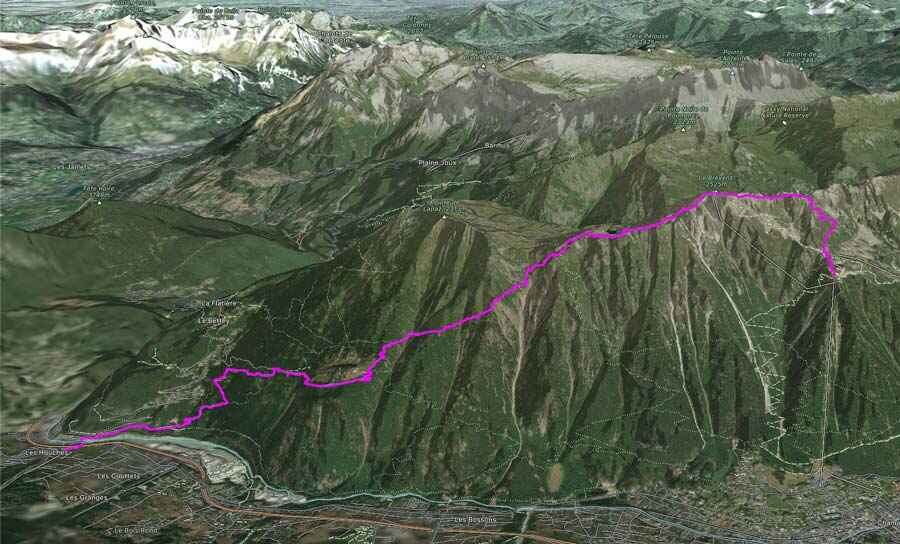
We commence the Tour Mont Blanc full trek from Chamonix taking the cable car to the Planpraz at 2000m, from here we take the TMB route to the Col du Brevent, Brevent 2525m and descend along the stunning ridge to Refuge Bel Lachat. From the refuge, we make the long and tough descent via Parc Merlet to Les Houches and our hotel accommodation for the night.
Accommodation
3* Hotel, private en-suite rooms, evening meal & breakfast
Guide notes:
This day often feels one of the toughest on the trek generally because people are not fully acclimatised. The descent can be punishing & is probably the most difficult during the trek due 1500m sustained down hill & at times rocky terrain. Walking poles are recommended to save the knees!
Les Houches to Les Contamines
Via Bionnassay: Distance: 15k | Height gain: +100m | Descent: -700m Via Col du Tricot: Distance: 13k | Height gain: +800m | Descent: -1300m
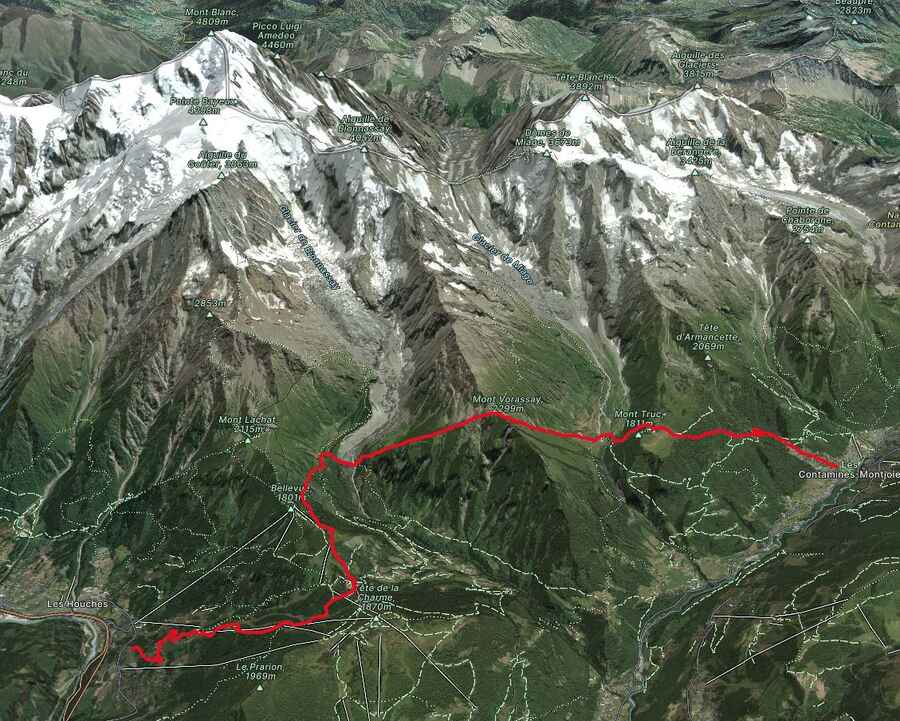
Our day starts with a cable car ride to the Bellevue 1802m with stunning views of the Mont Blanc range from high above the westerly end of the Chamonix valley. We then have a choice of routes to Les Contamines via Bionnassay and Chapel or the Col du Tricot and Chalets des Miage.
3* Hotel, private en-suite rooms, evening meal and breakfast
Day two and you are probably feeling a little tiered from the first day. The terrain is very different today, less rugged and more green as you will be trekking though high altitude pastureland. If you are trekking via the Col du Tricot check out the Blueberry pie at the Chalets des Miage, very memorable and delicious!
Les Contamines to Refuge Mottets
Distance: 20k | Height gain: +1500m | Descent: -900m
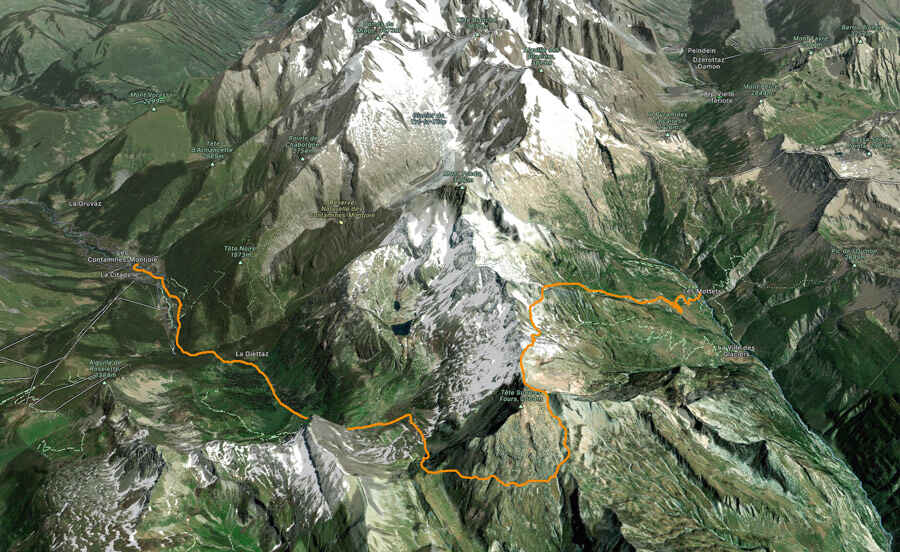
A great day ahead awaits and we make our ascent through three cols, Col du Bonhomme, Col de la Croix du Bonhomme and the Col des Fours 2665m. Descending steeply through the wild and remote landscape to Ville des Glaciers and our rest stop for the night at the atmospheric Refuge Mottets.
Dormitory (upgrade possible), evening meal & breakfast
On paper this looks like one of the longest and toughest days on the trek but don’t worry its very doable. There is a fair amount of height gain but it is integrated with sections of gentle terrain, which make the day more manageable. The key is to start early & allow plenty of time.
Refuge Mottets to Courmayeur
Distance: 14k | Height gain: +700m | Descent: -700m
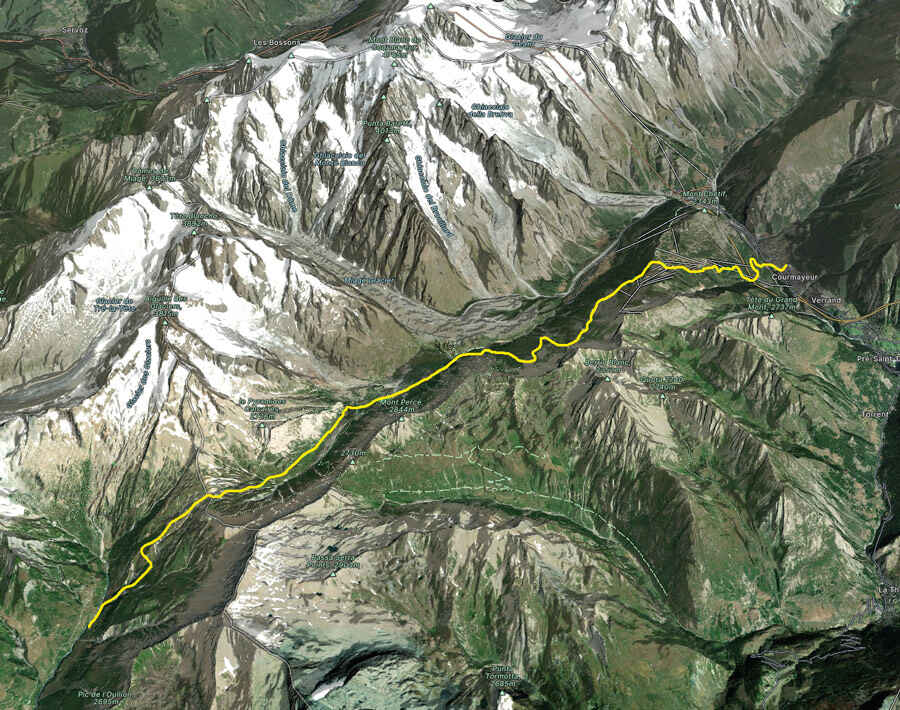
By staying at the Refuge Mottets it gives us a great position below the Col du Seigne 2516m, although we climb steeply at times we soon find ourselves over the col and across French/Italian border into Italy. We then make a descent into the stunning Val Veny with easy walking through the hanging valleys to Lac Combal. From here we descend La Visaille and take the shuttle bus to Courmayeur.
3* Hotel, private en-suite rooms, B & B
One of my favourite days on the Tour du Mont Blanc, the views from the Col du Seigne is second to none! Once you are at the col and if the weather is right rest for a while and take in the far-reaching views in to Italy & Switzerland, just wonderful!
Courmayeur to Refuge Bonatti
Distance: 17k | Height gain: +750m | Descent: -50m
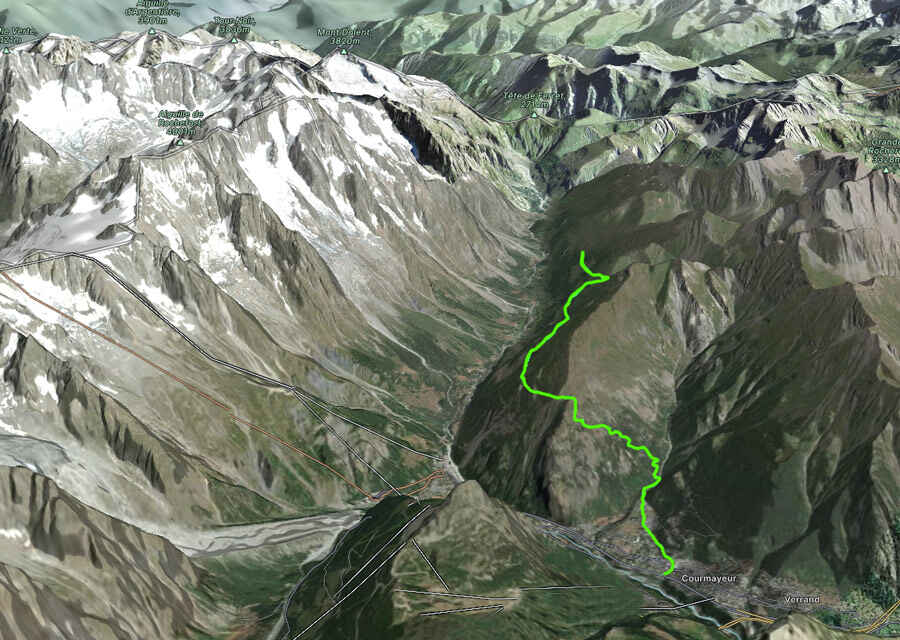
Fully refreshed we make our ascent to the Refuge Bertoni and enjoy amazing views of Mont Blanc and Courmayeur down below. We spend the rest of the day on a lofty traverse from high above the Val Ferret with stunning views of the Italian side of the Mont Blanc before reaching our accommodation at the beautiful Refuge Bonatti 2056m.
A steep but steady climb up to the Refuge Bertoni, it’s worth it because the coffee is fabulous & the views just stunning, elevenses’ here is a must! Fabulous views of some of the most famous peaks in the European Alps including Mont Blanc and the Grand Jorasses. And for the refuge Bonatti... its just fabulous, if the night is clear go our side after dinner and just 'be' in this impressive location.
Refuge Bonatti to La Fouly
Distance: 20k | Height gain: +900m | Descent: -1400m
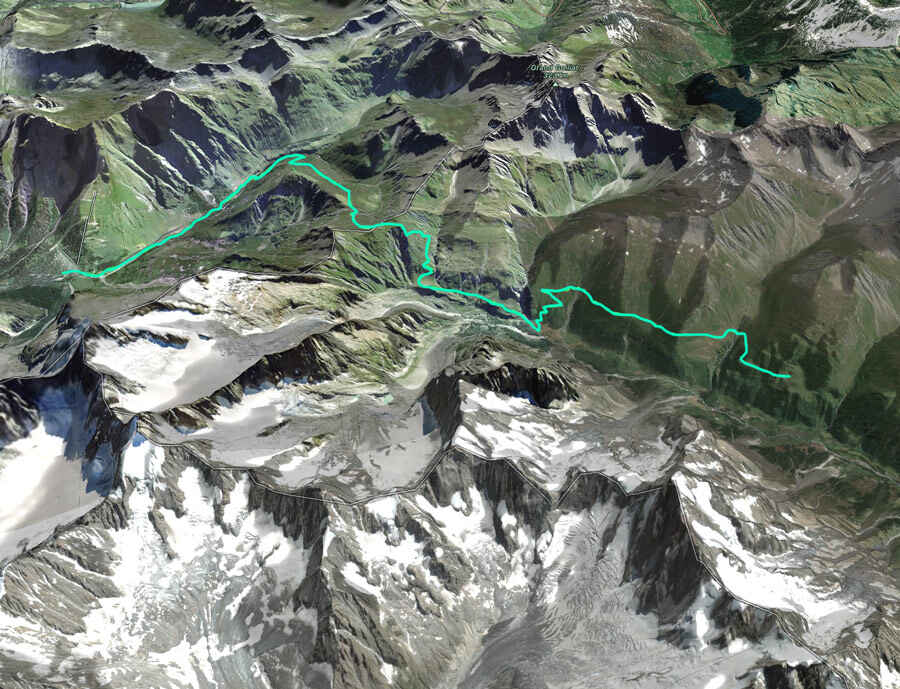
An early start and a new country awaits, we continue through the Val Ferret to Arnuva before making our long ascent to the Grand Col Ferret 2537m via the Refugio Elena and the Italian/Swiss border. We then make a relatively easy and enjoyable descent via la Peule, Ferret to La Fouly and our hotel accommodation for the night.
3* Hotel private en-suite rooms, evening meal & breakfast
Again this day looks tough but the hard bits are nicely spaced with less challenging terrain & once at the Col stare in wonder at the view looking back at your last 3 days of trekking towards the Col du Seigne & over the boarder into Switzerland. The descent is long but at an easy angle & the path is good. Plenty of opportunity to stop for refreshments at Arnurva, Refuge Elena & La Peule.
La Fouly to Champex Lac
Distance: 18k | Height gain: +750m | Descent: -950m
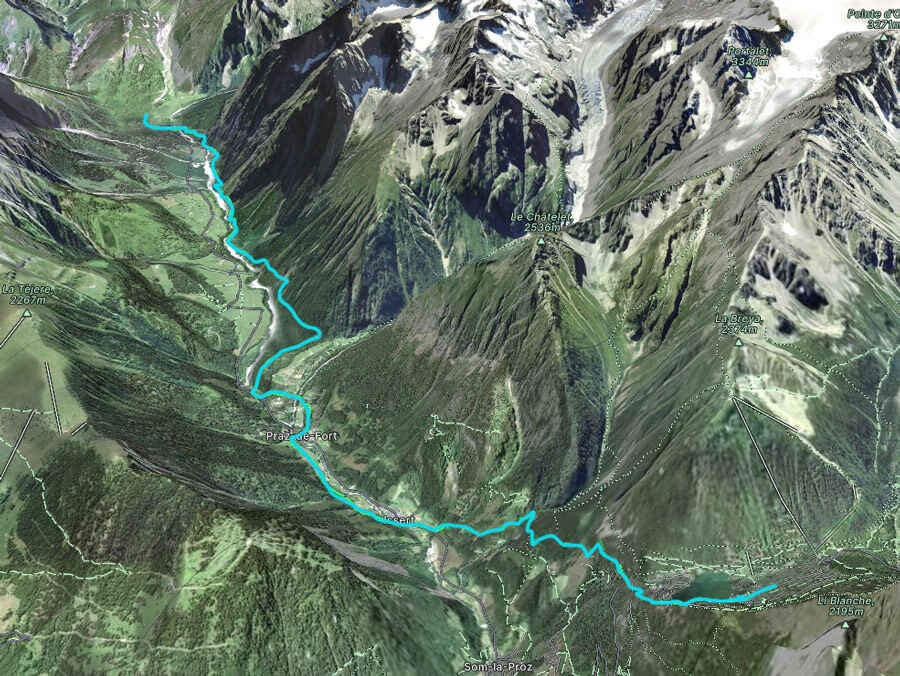
An easy day in comparison walking in the beautiful Swiss Val Ferret. We then pass through the Swiss villages of Praz de Fort and Issert before make our ascent to the charming village of Champex-Lac and our resting place for the evening.
Auberge with private rooms & shared facilities, evening meal & breakfast
The Bovine route is a fabulous day not too tricky over lovely terrain. Lunch stop at the high alpine farm at Bovine is a must, you can purchase local food or even eat your own picnic on the terrace as long as you buy a drink. Amazing views across to Lac Leman & down the Rhone valley.
Champex Lac to Trient
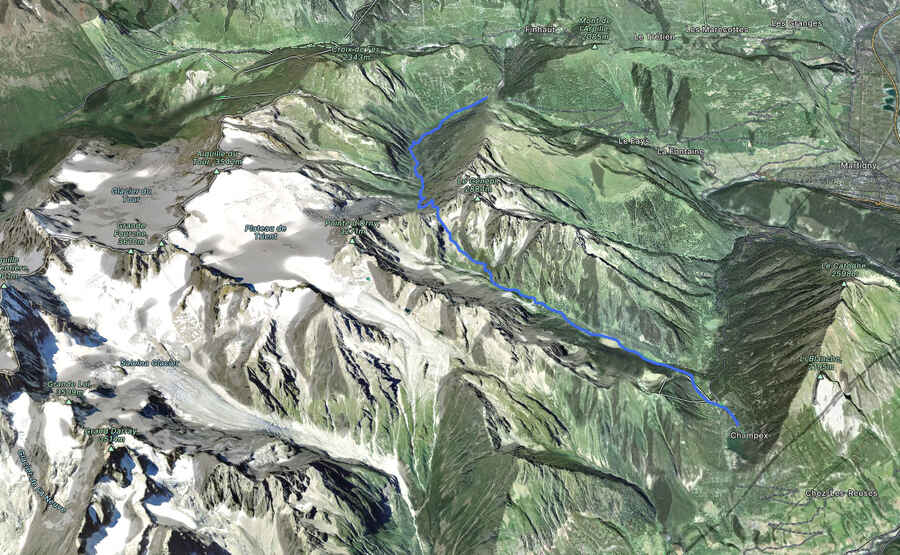
An initial easy start to the day is to be had as we wind our way on easy paths to Plan de l'Au. We then climb up steadily to the Alpage Bovine 1987m and enjoy fabulous views over Martigny and the Swiss Valais. We spend the rest of the day making our descent to the Col du Forclaz 1526m with a final descent to Trient.
Auberge with private rooms and shared facilities, evening meal and breakfast
The Bovine route is a fabulous day not too tricky over lovely terrain. Lunch stop at the high alpine farm at Bovine is a must, you can purchase local food or even eat your own picnic on the terrace as long as you buy a drink. Amazing views across to Lac Leman and down the Rhone valley.
Trient to Argentière
Direct via the Col du Balme: Distance: 13k | Height gain: +900m | Descent: -900m Via Catogne & the Col du Balme: Distance: 15k | Height gain: +1000m | Descent: -1000m
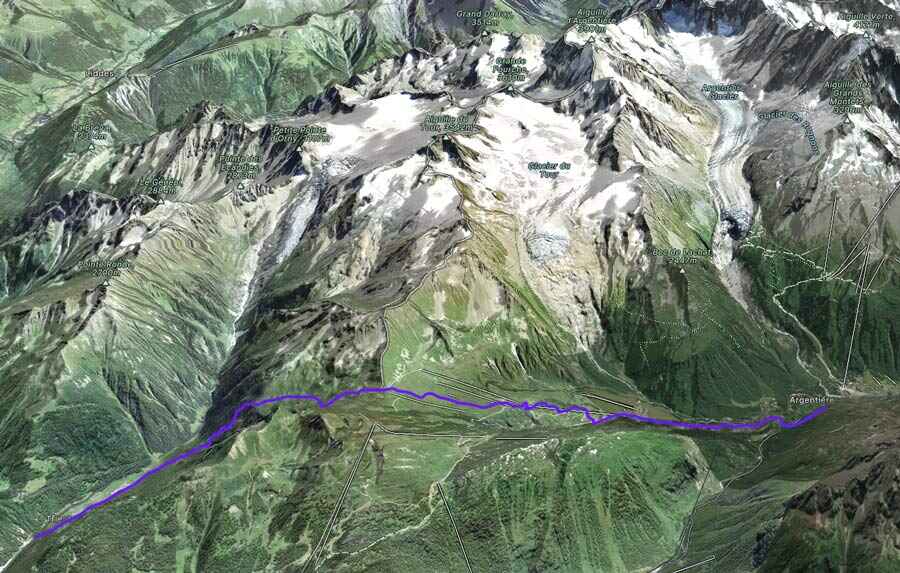
Today we have two options as we can take the route directly to the Col du Balme from Trient or through alpine woodland to the Alpage of Tseppes, Catogne and on to the Col du Balme 2191m and the Swiss/French border. From the Col, we then make our descent to the hamlet of Le Tour and across pastureland to the village of Argentiere and our hotel accommodation for the evening.
4* Hotel private en-suite rooms, B & B
Personally unless the weather is bad take the route via Catogne, the views are far superior as one up high you take a lofty traverse with excellent views over towards Emossom dam & the Aiguille Rouges nature reserve.
Argentière to Chamonix
Distance: 14k | Height gain: +1200m | Descent: -500m
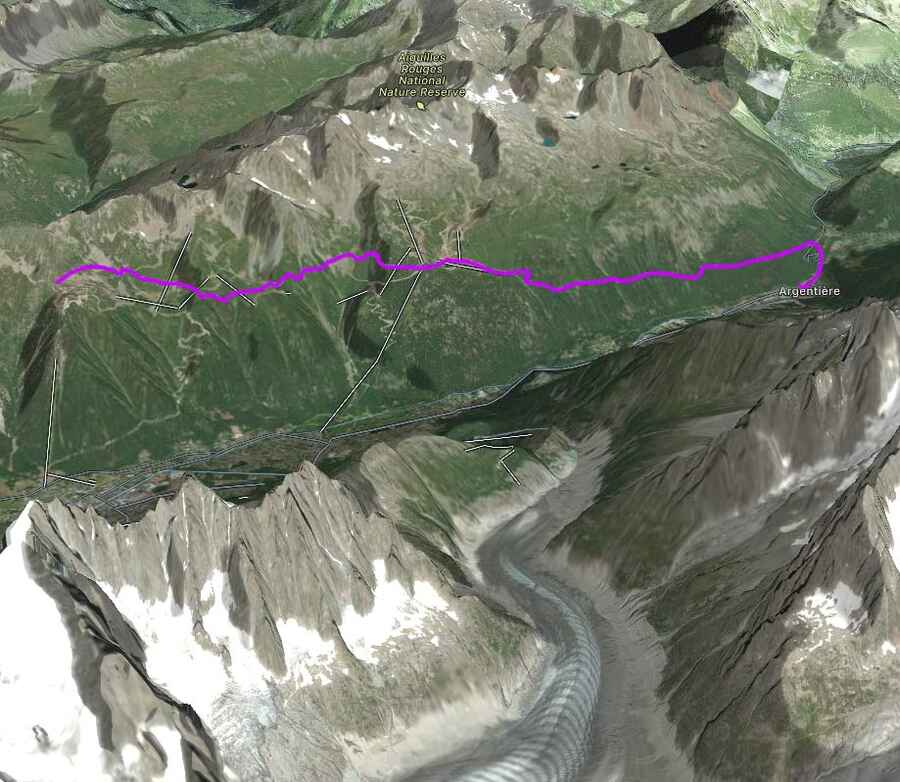
Our final day and a fitting end to the trek takes us back into the Aiguille Rouges to the stunning Lac des Cheserys and Lac Blanc 2352m. We then make a descent to Flegere and take the balcony path traversing high above the Chamonix valley to Planpraz at our starting point 11 days earlier completing the circuit. A final decent via the cable car back to Chamonix in time for a celebratory drink as you have just completed the Tour du Mont Blanc, one of the best multi day treks in the world. In the event of lift closures, we make our descent back to Chamonix via Flegere.
3* Hotel private en-suite rooms, B & B
A fitting end to the trek back in the Aiguille nature reserve with pristine views of the Mont Blanc massif and all its peaks and glaciers. Visiting the iconic Lac Blanc is a must and stop for refreshments in the refuge. It gets busy with day walkers in August so make an early start if possible.
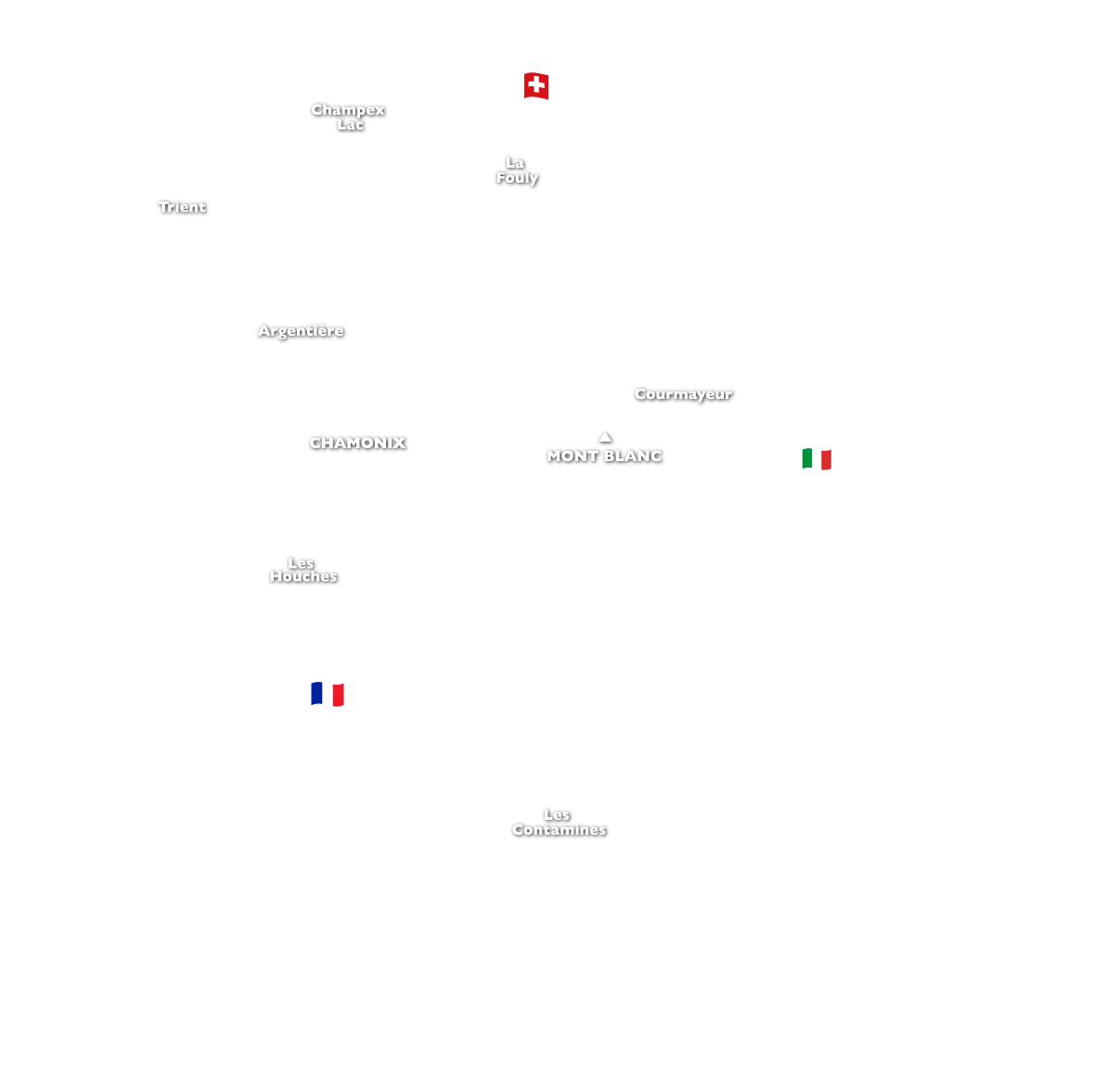
- 1. Chamonix to Les Houches
- 2. Les Houches to Les Contamines
- 3. Les Contamines to Refuge Mottets
- 4. Refuge Mottets to Courmayeur
- 5. Courmayeur to Refuge Bonatti
- 6. Refuge Bonatti to La Fouly
- 7. La Fouly to Champex Lac
- 8. Champex Lac to Trient
- 9. Trient to Argentière
- 10. Argentière to Chamonix
Tour du Mont Blanc Easterly Circuit Map
The Tour Mont Blanc easterly trek starts in Courmayeur and takes in half of the classic route anti-clockwise to Chamonix. It is a 6 day trek that covers approximately 100 kilometers through the Italian, Swiss and French alps. This walking holiday in the alps is ideal for those wanting to experience the Tour du Mont Blanc in a shorter period of time.
We make our ascent to the Refuge Bertoni and enjoy amazing views of Mont Blanc and Courmayeur down below. We spend the rest of the day on a lofty traverse from high above the Val Ferret with stunning views of the Italian side of the Mont Blanc before reaching our accommodation at the beautiful Refuge Bonatti 2056m.
- 1. Courmayeur to Refuge Bonatti
- 2. Refuge Bonatti to La Fouly
- 3. La Fouly to Champex Lac
- 4. Champex Lac to Trient
- 5. Trient to Argentière
- 6. Argentière to Chamonix
Tour du Mont Blanc Westerly Circuit Map
The Tour du Mont Blanc westerly route starts in Chamonix and takes in half of the classic Tour du Mont Blanc route anti-clockwise to Courmayeur. The route covers approximately 70 kilometers through the French and Italian alps. This trekking holiday in the alps is ideal for those wanting to experience the Tour du Mont Blanc in a shorter period of time.
We commence the Tour Mont Blanc westerly trek from Chamonix taking the cable car to the Planpraz at 2000m, from here we take the TMB route to the Col du Brevent, Brevent 2525m and descend along the stunning ridge to Refuge Bel Lachat. From the refuge, we make the long and tough descent via Parc Merlet to Les Houches and our hotel accommodation for the night.
This day often feels one of the toughest on the trek generally because people are not fully acclimatised. The descent can be punishing and is probably the most difficult during the trek due 1500m sustained down hill & at times rocky terrain. Walking poles are recommended to save the knees!

Tour du Mont Blanc Profile

Sign up to Our Newsletter
Marketing permissions.
Mont Blanc Treks will use the information you provide on this form to be in touch with you and to provide updates and marketing. Please let us know if you are happy to receive emails from us by checking the box below.
You can change your mind at any time by clicking the unsubscribe link in the footer of any email you receive from us, or by contacting us at [email protected]. We will treat your information with respect. For more information about our privacy practices please visit our website. By clicking below, you agree that we may process your information in accordance with these terms.
We use Mailchimp as our marketing platform. By clicking below to subscribe, you acknowledge that your information will be transferred to Mailchimp for processing. Learn more about Mailchimp's privacy practices here.

IMAGES
VIDEO
COMMENTS
The table below has an overview of all of the options: Entire Route TMB Map (1:50,000) Detailed TMB Map 1 of 2 (1:25,000) Detailed TMB Map 2 of 2 (1:25,000) Tour du Mont Blanc IGN Map (English and French Edition) Tour du Mont Blanc Map: 3630OT Chamonix Mont Blanc. Tour du Mont Blanc Map: 3531ET Saint-Gervais les Bains.
The Tour Mont Blanc easterly trek starts in Courmayeur and takes in half of the classic route anti-clockwise to Chamonix. It is a 6 day trek that covers approximately 100 kilometers through the Italian, Swiss and French alps. This walking holiday in the alps is ideal for those wanting to experience the Tour du Mont Blanc in a shorter period of ...
Tour du Mont Blanc Hiking - Routes, Maps and Itineraries. The Tour du Mont Blanc is a 170 km trek that encompasses the whole of the Mont Blanc Massif; with nearly 10 000m of cumulative descent and ascent it is usually completed in a number of days. The TMB has a variety of accommodations along its way (hotels and mountain huts with possibility ...
Tour du Mont Blanc Self Guided Itinerary. Make no mistake, the Tour du Mont Blanc hike is tough. The Tour du Mont Blanc is roughly 170 kilometres (110 miles) long with 10,000 metres (6 miles) of ascent/descent as it passes through parts of Switzerland, Italy and France while circling the Mont Blanc massif.
The second stage of the Tour du Mont Blanc begins at the Refuge de la Balme and ends at the Refuge des Mottets. It follows the classic route of the tour. The departure from the Refuge de la Balme leads to a climb of 650 meters of elevation gain over a distance of 4 kilometers to reach the Col du Bonhomme.
The Tour du Mont Blanc (TMB) is a captivating multi-day hike that circuits the Mont Blanc massif in usually 10-11 days, passing through France, Italy and Switzerland. The main Tour du Mont Blanc route is 170 km (105 miles) long and involves 10,080 meters (33,071 feet) of elevation gain and loss. The Mont Blanc mountain range takes its name from ...
Tour du Mont Blanc Map Overview of the Route. The Tour du Mont Blanc is a renowned hiking trail that spans approximately 170 kilometers (106 miles) through France, Italy, and Switzerland. The route encircles the majestic Mont Blanc, the highest peak in the Alps, offering breathtaking views of snow-capped mountains, lush valleys, and picturesque ...
Our Tour du Mont Blanc guide helps you navigate the length of the 105-mile TdMB. ... Download our guide to access the Tour du Mont Blanc map, tracks, waypoints, and comments! ... Courmayeur, Champex, and Martigny. The route also passes Chamonix, the famous resort which hosted the first Winter Olympic Games in 1924. $14.99/£14.99 A TRAILBLAZER ...
Route Overview. The Tour du Mont Blanc covers a distance of roughly 170 kilometres and gains more than 10,000 meters of altitude over 11 stages. Most people start their hike in Les Houches, France going in an anti-clockwise direction. During this trek you will hike in the French, Italian and Swiss Alps and spend the night in mountain huts.
The Tour du Mont Blanc (TMB) is a 170-km trek that circles the Mont Blanc massif. The route is traditionally walked in the anti-clockwise direction over 11-stages. The TMB starts and finishes in the French village of Les Houches, which sits adjacent to the popular mountain town of Chamonix.
The Tour du Mont Blanc or TMB is one of the most popular long-distance walks in Europe. It circles the Mont Blanc massif, covering a distance of roughly 165 kilometres (103 mi) with 10 kilometres (6.2 mi) of ascent/descent and passing through parts of Switzerland, Italy and France. It is considered one of the classic long-distance hiking trails ...
This map was created by a user. Learn how to create your own. Mont Blanc Treks full Tour du Mont Blanc 10 day trek. For More information visit www.montblanctreks.com.
The Tour du Mont Blanc difficulty level is somewhat subjective to the hiker. The Gouter route is relatively easy because it takes about two days to reach the ascent and does not require extensive ...
Trekking route - 7 days, 7 nights, use of transportation for some segments Created by www.EfratNakash.com Official main route and variants on a topographic map: https://umap.openstreetmap.fr/fr ...
It's worth noting that each 'stage' is LONG averaging between 13-20km per day over challenging terrain, expect between 700m up to 1000m elevation gain each day! Covering the entire Tour du Mont Blanc in 11 days is no walk in the park - expect to be on the trail between 7-9 hours per day. Some of you may want to walk at a more leisurely ...
The famous Tour du Mont Blanc is a 170-kilometer long circuit, which encircles the Mont Blanc massif and has 10 kilometers of ascent/descent. The trek can be completed in 7 to 11 days, depending on the route and physical condition. A part of the Tour du Mont Blanc shapes the Walker's Haute Route as well.
From here you can walk up to the Chalets de Flegere (1900m) in 90 minutes or take the cable car up in seven minutes. At the top of the Flegere cable car you hike through open countryside for 1.5-2 hours to Lac Blanc (2352m). There are incredible views of the whole Mont Blanc range, including Les Grandes Jorasses, Aiguille Vert and Les Drus.
Marcus Shapiro is joined by Mags and Olly - Tour du Mont Blanc experts! They both share a passion for the Tour du Mont Blanc hike a.k.a. TMB. After listening to the discussion, you will feel confident about committing to this iconic hike. Below is a sampling of some discussion topics: - Make you…
Official map of Moscow metro since 2005 ©2005 ZAO Metroreklama . Next Previous 6 of 6 . About Me in Short. My name's Arthur Lookyanov, I'm a private tour guide, personal driver and photographer in Moscow, Russia. I work in my business and run my website Moscow-Driver.com from 2002.
NEW CHRISTMAS TOUR 2024 - Bournemouth - Norfolk Royale Hotel - BROCHURE ADDITION . 2024 EUROPEAN HOLIDAYS - Early release - ITALY - Lake Garda / Alassio Click here to download our 2024 Brochure All Our Holidays Include In The Price: Free Door to Door Taxi ( Subject to Area ) ~ Luxury Coach Travel ~ Reserved Coach Seats . Personally Selected ..... www.kmchesterfield.co.uk...
This map — and the version detailing the current Moscow Metro, which is slightly more sane — was made by Artemy Lebedev. In all seriousness, his map of the 2010 metro is a nice improvement to the current standard. @pmylund — Subscribe — Contact.
Welcome to the 628DirtRooster website where you can find video links to Randy McCaffrey's (AKA DirtRooster) YouTube videos, community support and other resources for the Hobby Beekeepers and the official 628DirtRooster online store where you can find 628DirtRooster hats and shirts, local Mississippi honey and whole lot more!
The Tour Mont Blanc easterly trek starts in Courmayeur and takes in half of the classic route anti-clockwise to Chamonix. It is a 6 day trek that covers approximately 100 kilometers through the Italian, Swiss and French alps. This walking holiday in the alps is ideal for those wanting to experience the Tour du Mont Blanc in a shorter period of ...